ZyXEL Communications G570S Access Point User Manual Part 2
ZyXEL Communications Corporation Access Point Part 2
Contents
- 1. Part 1
- 2. Part 2
Part 2

ZyXEL G-570S User’s Guide
Chapter 6 Wireless Screens 81
6.13 Security Parameters Summary
Refer to this table to see what other security parameters you should configure for each
authentication method/ key management protocol type. You enter manual keys by first
selecting 64-bit WEP,128-bit WEP or 152-bit WEP from the WEP Encryption field and
then typing the keys (in ASCII or hexadecimal format) in the key text boxes. MAC address
filters are not dependent on how you configure these security features.
6.14 Wireless Client WPA Supplicants
A wireless client supplicant is the software that runs on an operating system instructing the
wireless client how to use WPA. At the time of writing, the most widely available supplicants
are the WPA patch for Windows XP, Funk Software's Odyssey client, and Meetinghouse Data
Communications' AEGIS client.
The Windows XP patch is a free download that adds WPA capability to Windows XP's built-
in "Zero Configuration" wireless client. However, you must run Windows XP to use it.
6.15 Configuring Wireless Security
In order to configure and enable wireless security; click SETTINGS > WIRELESS >
Security to display the Security screen. This screen varies according to the encryption method
you select.
Table 16 Wireless Security Relational Matrix
AUTHENTICATION
METHOD/ KEY
MANAGEMENT
PROTOCOL
ENCRYPTION
METHOD ENTER MANUAL
KEY IEEE 802.1X
Open None No Disable
Open WEP No Enable with Dynamic WEP Key
Yes Enable without Dynamic WEP Key
Yes Disable
Shared WEP No Enable with Dynamic WEP Key
Yes Enable without Dynamic WEP Key
Yes Disable
WPA TKIP No Enable
WPA-PSK TKIP Yes Enable
WPA2 AES No Enable
WPA2-PSK AES Yes Enable
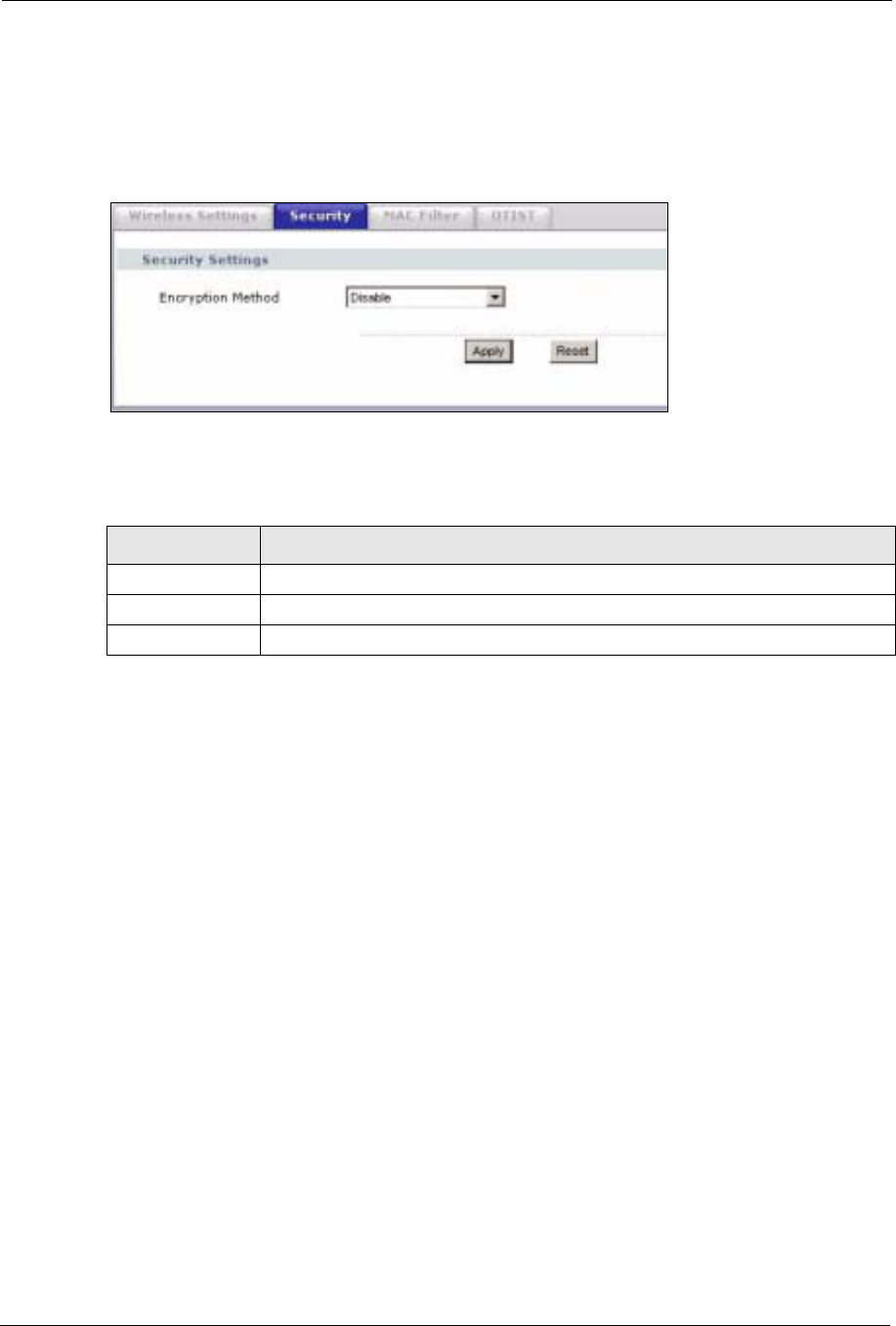
ZyXEL G-570S User’s Guide
82 Chapter 6 Wireless Screens
6.15.1 Wireless Security: Disable
If you do not enable any wireless security on your device, your network is accessible to any
wireless networking device that is within range.
Figure 47 Wireless Security: Disable
The following table describes the labels in this screen.
6.15.2 Wireless Security: WEP
WEP provides a mechanism for encrypting data using encryption keys. Both the AP and the
wireless stations must use the same WEP key to encrypt and decrypt data. You can configure
up to four 64-bit, 128-bit or 152-bit WEP keys, but only one key can be used at any one time.
Table 17 Wireless Security: Disable
LABEL DESCRIPTION
Encryption Method Select Disable to have no wireless LAN security configured.
Apply Click Apply to save your changes back to the device.
Reset Click Reset to begin configuring this screen afresh.
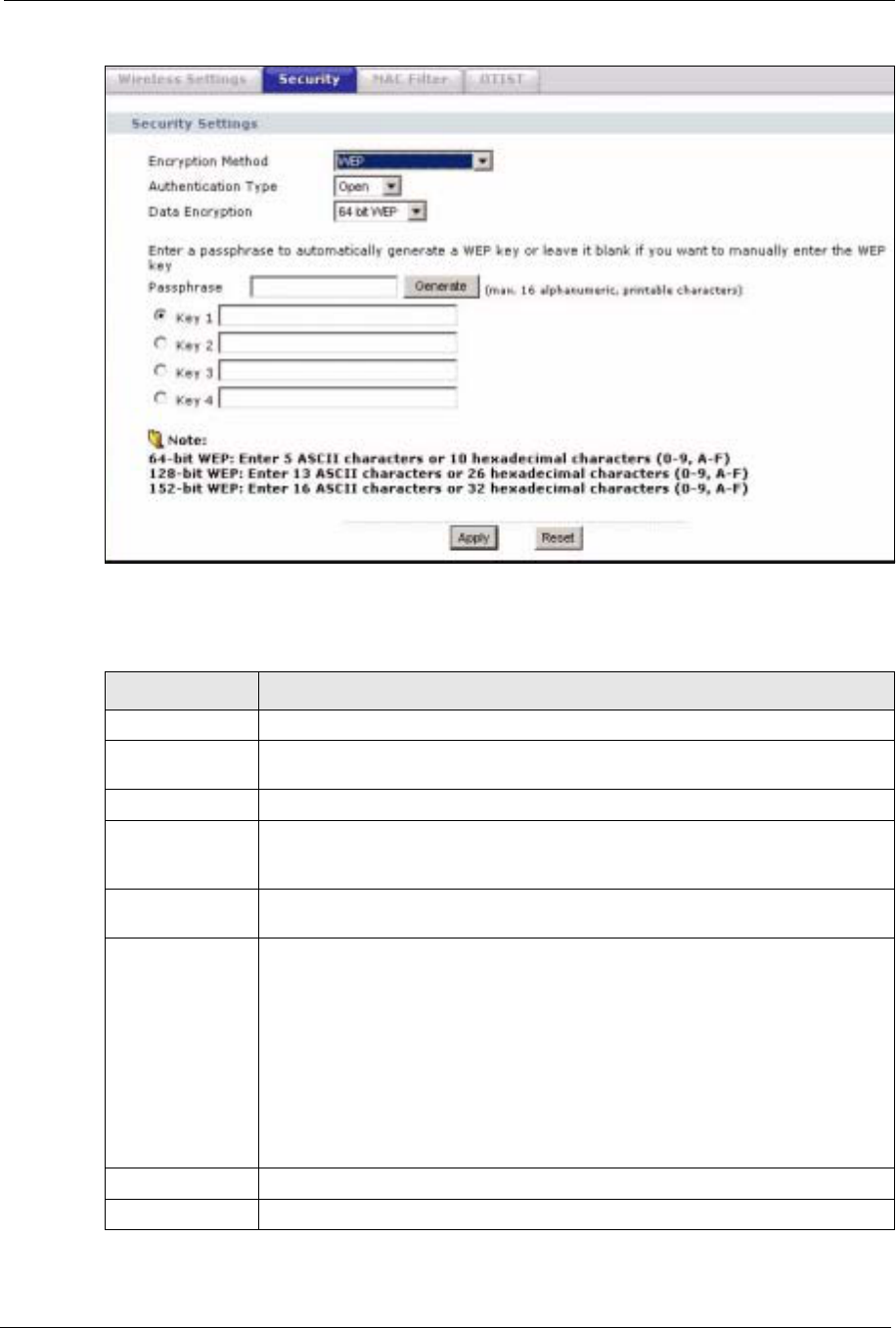
ZyXEL G-570S User’s Guide
Chapter 6 Wireless Screens 83
Figure 48 Wireless Security: WEP
The following table describes the labels in this screen.
Table 18 Wireless Security: WEP
LABEL DESCRIPTION
Encryption Method Select WEP if you want to configure WEP encryption parameters.
Authentication
Type Select Auto,Open or Shared from the drop-down list box.
WEP Encryption Select 64 bit WEP,128 bit WEP or 152 bit WEP to enable data encryption.
Passphrase If you selected 64-bit or 128-bit WEP, you can enter a “passphrase” (password
phrase) of up to 32 case-sensitive printable characters and click Generate to have
the device create four different WEP keys.
Generate After you enter the passphrase, click Generate to have the device generates four
different WEP keys automatically.
Key 1 to
Key 4
If you want to manually set the WEP keys, enter the WEP key in the field provided.
Select a WEP key to use for data encryption.
The WEP keys are used to encrypt data. Both the device and the wireless stations
must use the same WEP key for data transmission.
If you chose 64 bit WEP, then enter any 5 ASCII characters or 10 hexadecimal
characters ("0-9", "A-F").
If you chose 128 bit WEP, then enter 13 ASCII characters or 26 hexadecimal
characters ("0-9", "A-F").
If you chose 152 bit WEP, then enter 16 ASCII characters or 32 hexadecimal
characters ("0-9", "A-F").
Apply Click Apply to save your changes back to the device.
Reset Click Reset to begin configuring this screen afresh.
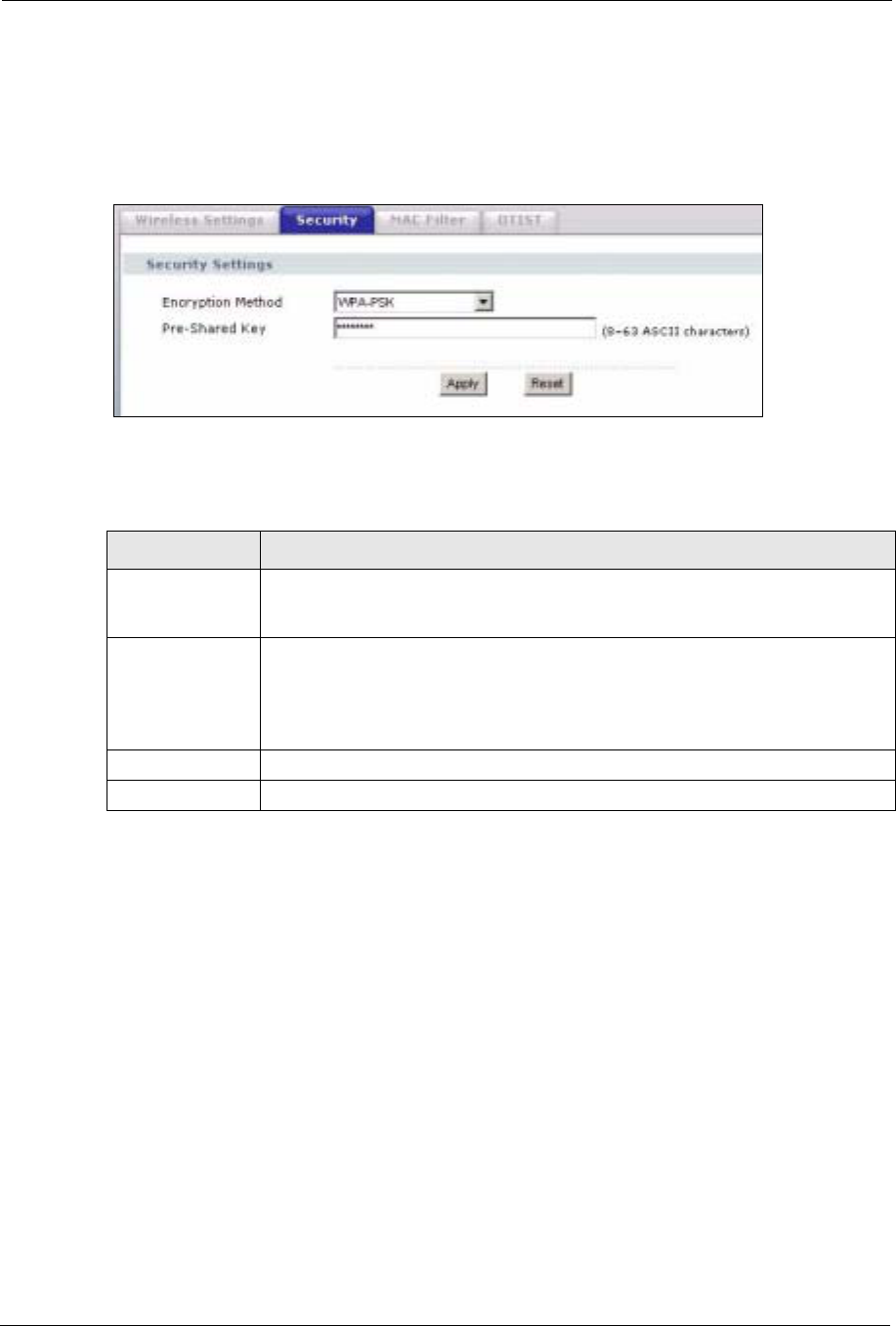
ZyXEL G-570S User’s Guide
84 Chapter 6 Wireless Screens
6.15.3 Wireless Security: WPA(2)-PSK
Select WPA-PSK,WPA2-PSK or WPA-PSK & WPA2-PSK in the Encryption Method
drop down list-box to display the screen displays as next.
Figure 49 Wireless Security: WPA(2)-PSK
The following table describes the labels in this screen.
6.15.4 Wireless Security: WPA(2)
WPA (Wi-Fi Protected Access) is a subset of the IEEE 802.11i standard. WPA2 (IEEE
802.11i) is a wireless security standard that defines stronger encryption, authentication and
key management than WPA. Key differences between WPA(2) and WEP are user
authentication and improved data encryption.
Table 19 Wireless Security: WPA-PSK
LABEL DESCRIPTION
Encryption Method Select WPA-PSK,WPA2-PSK or WPA-PSK & WPA2-PSK if you want to
configure a pre-shared key. Choose this option only if your wireless clients support
it.
Pre-Shared Key The encryption mechanisms used for WPA and WPA-PSK are the same. The only
difference between the two is that WPA-PSK uses a simple common password,
instead of user-specific credentials.
Type a pre-shared key from 8 to 63 ASCII characters (including spaces and
symbols). This field is case-sensitive.
Apply Click Apply to save your changes back to the device.
Reset Click Reset to begin configuring this screen afresh.
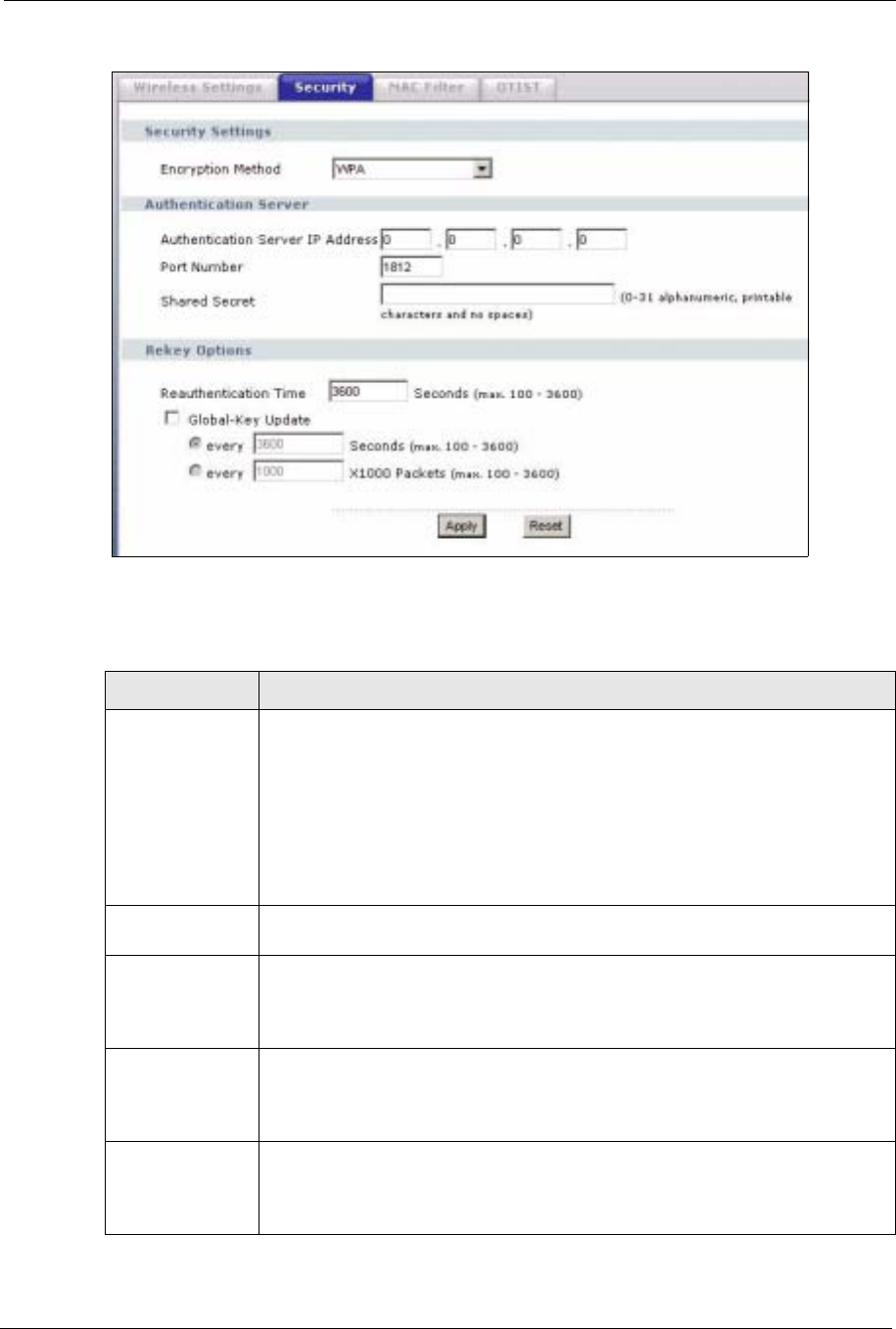
ZyXEL G-570S User’s Guide
Chapter 6 Wireless Screens 85
Figure 50 Wireless Security: WPA(2)
The following table describes the labels in this screen.
Table 20 Wireless Security: WPA(2)
LABEL DESCRIPTION
Encryption Method Select WPA,WPA2 or WPA & WPA2 to configure user authentication and
improved data encryption.
Note: WPA, WPA2 and IEEE 802.1x wireless security are not
available when you use Wireless Client, Bridge or
AP+Repeater mode.
You can only use WEP keys to encrypt traffic between APs.
Authentication
Server IP Address Enter the IP address of the external authentication server in dotted decimal
notation.
Port Number Enter the port number of the external authentication server. The default port
number is 1812.
You need not change this value unless your network administrator instructs you to
do so with additional information.
Shared Secret Enter a password (up to 63 printable characters) as the key to be shared between
the external authentication server and the device.
The key must be the same on the external authentication server and your device.
The key is not sent over the network.
Reauthentication
Time Specify how often wireless stations have to resend user names and passwords in
order to stay connected. Enter a time interval between 100 and 3600 seconds.
If wireless station authentication is done using a RADIUS server, the
reauthentication timer on the RADIUS server has priority.
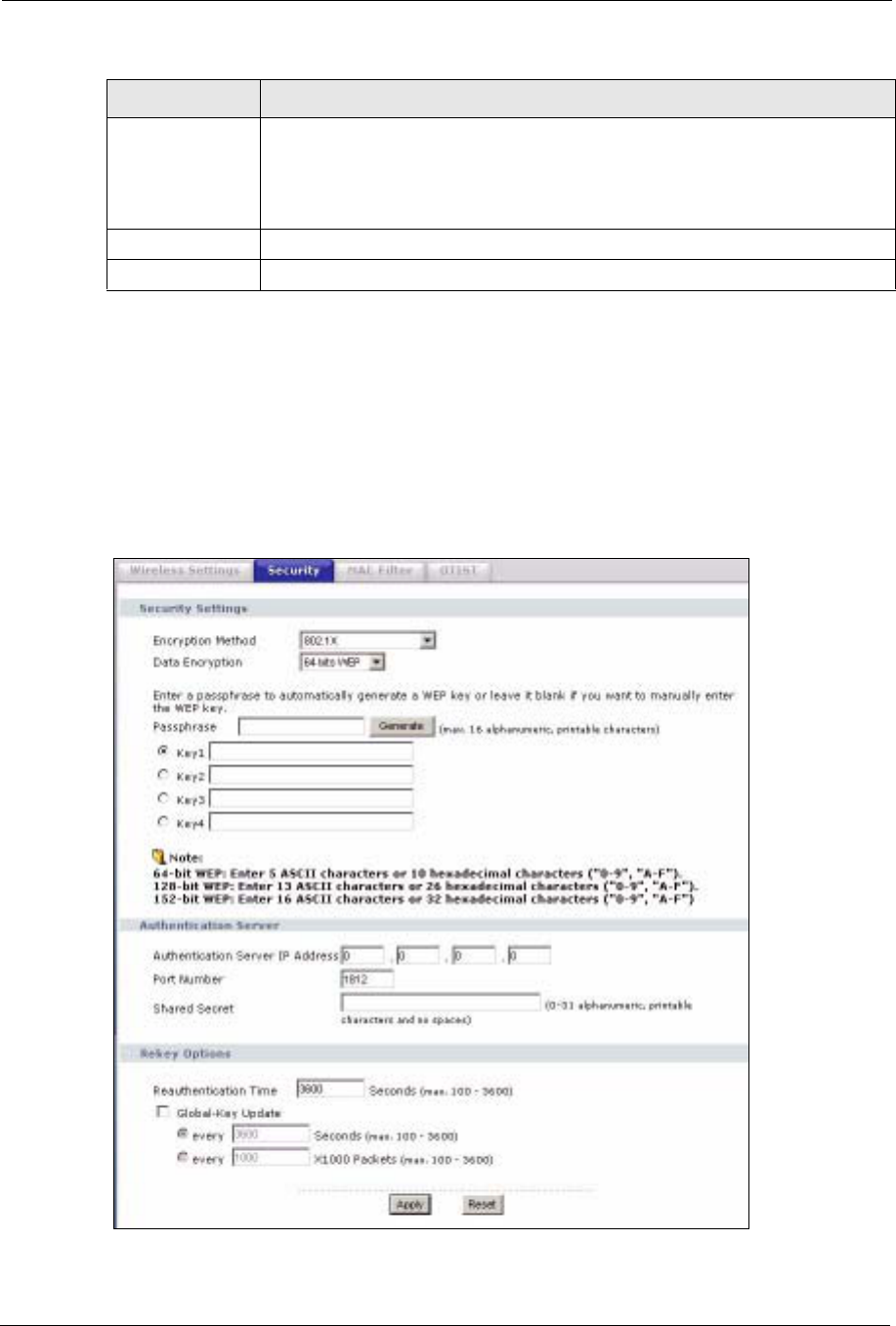
ZyXEL G-570S User’s Guide
86 Chapter 6 Wireless Screens
6.15.5 Wireless Security: IEEE 802.1x
The IEEE 802.1x standard outlines enhanced security methods for both the authentication of
wireless stations and encryption key management.
Note: Once you enable user authentication, you need to specify an external RADIUS
server on the device for authentication.
Figure 51 Wireless Security: 802.1x
Global-Key
Update This is how often the AP sends a new group key out to all clients. The re-keying
process is the WPA equivalent of automatically changing the WEP key for an AP
and all stations in a WLAN on a periodic basis.
Specify an interval either in seconds or thousands of packets that the device
sends.
Apply Click Apply to save your changes back to the device.
Reset Click Reset to begin configuring this screen afresh.
Table 20 Wireless Security: WPA(2) (continued)
LABEL DESCRIPTION

ZyXEL G-570S User’s Guide
Chapter 6 Wireless Screens 87
The following table describes the labels in this screen.
6.16 MAC Filter
The MAC filter screen allows you to give exclusive access to up to 32 devices (Allow
Association) or exclude up to 32 devices from accessing the device (Deny Association). Every
Ethernet device has a unique MAC (Media Access Control) address. The MAC address is
assigned at the factory and consists of six pairs of hexadecimal characters, for example,
00:A0:C5:00:00:02. You need to know the MAC addresses of the devices to configure this
screen.
The MAC filter works when the device functions as an AP. It allows or denies wireless client
access. The MAC filter does not apply to bridge or repeater functions.
Table 21 Wireless Security: 802.1x
LABEL DESCRIPTION
Encryption Method Select 802.1X to configure authentication of wireless stations and encryption key
management.
Note: WPA, WPA2 and IEEE 802.1x wireless security are not
available when you use Bridge or AP+Repeater mode. You
can only use WEP keys to encrypt traffic between APs.
Data Encryption Select None to allow wireless stations to communicate with the access points
without using dynamic WEP key exchange.
Select 64 bits WEP,128 bits WEP or 152 bits WEP to enable data encryption.
Up to 32 stations can access the device when you configure dynamic WEP key
exchange.
Authentication
Server IP Address Enter the IP address of the external authentication server in dotted decimal
notation.
Port Number Enter the port number of the external authentication server. The default port
number is 1812.
You need not change this value unless your network administrator instructs you to
do so with additional information.
Shared Secret Enter a password (up to 63 printable characters) as the key to be shared between
the external authentication server and the device.
The key must be the same on the external authentication server and your device.
The key is not sent over the network.
Reauthentication
Time Specify how often wireless stations have to resend user names and passwords in
order to stay connected. Enter a time interval between 100 and 3600 seconds.
If wireless station authentication is done using a RADIUS server, the
reauthentication timer on the RADIUS server has priority.
Global-Key
Update This is how often the AP sends a new group key out to all clients. The re-keying
process is the WPA equivalent of automatically changing the WEP key for an AP
and all stations in a WLAN on a periodic basis.
Specify an interval either in seconds or thousands of packets that the device
sends.
Apply Click Apply to save your changes back to the device.
Reset Click Reset to begin configuring this screen afresh.
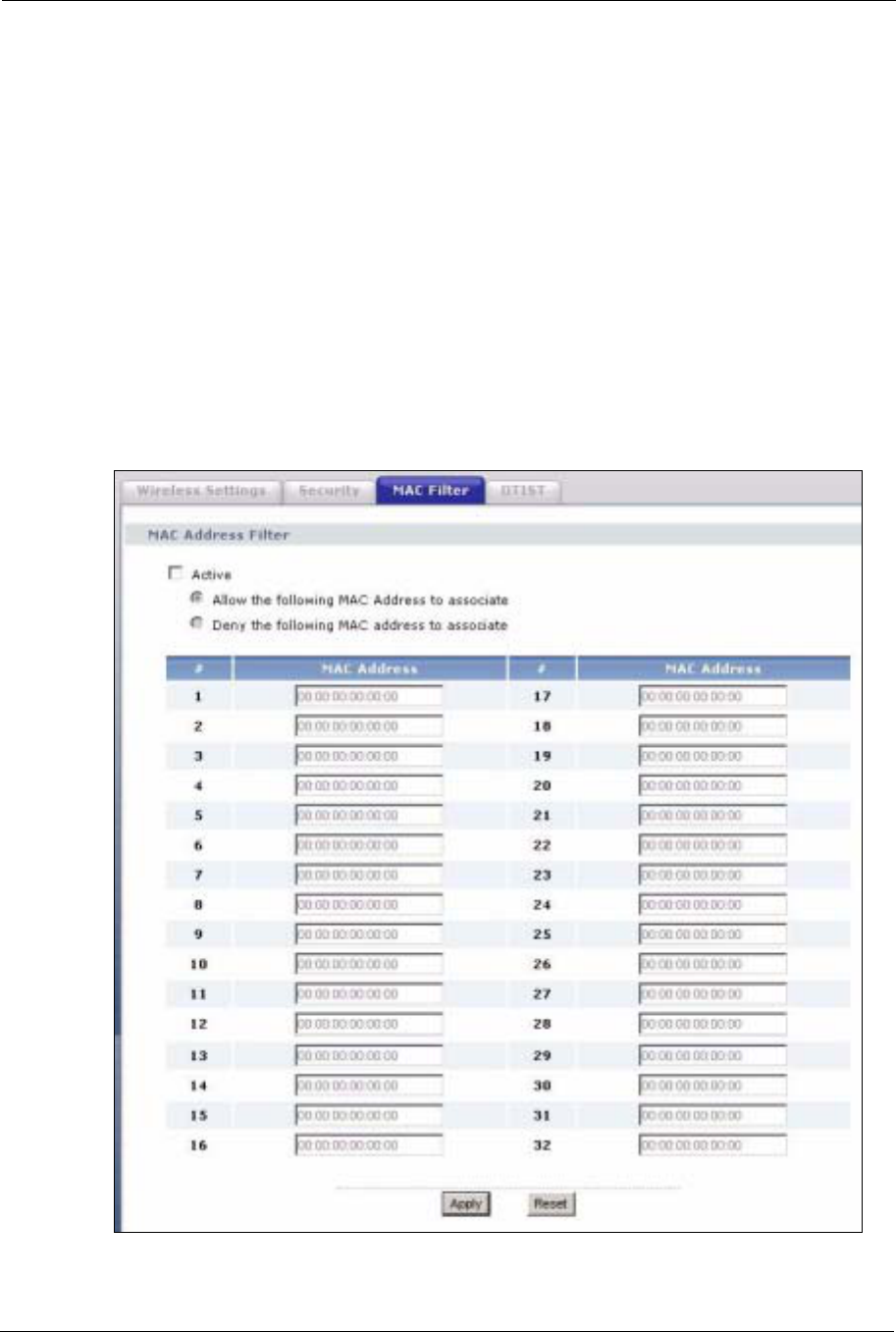
ZyXEL G-570S User’s Guide
88 Chapter 6 Wireless Screens
The following applies if you set the device to client mode and want to connect to an AP that
uses a MAC filter. After the device turns on in client mode, it clones the MAC address of the
first packets that it receives from devices connected to the Ethernet port. It uses this MAC
address on the packets that it sends to an AP. All of the packets that the device sends to an AP
will appear to be from the first device that connected to the Ethernet port. If you turn the
device off and back on, it again clones the MAC address of the first packets that it receives
from devices connected to the Ethernet port. You may be able to check the association list on
the AP to determine which MAC address the device is currently using.
To change your device's MAC filter settings, click WIRELESS > SETTINGS > MAC
Filter. The screen appears as shown.
Note: Be careful not to list your computer's MAC address and select Deny the
following MAC address to associate when managing the device via a
wireless connection. This would lock you out.
Figure 52 MAC Filter

ZyXEL G-570S User’s Guide
Chapter 6 Wireless Screens 89
The following table describes the labels in this screen.
6.17 OTIST
In a wireless network, the wireless clients must have the same SSID and security settings as
the access point (AP) or wireless router (we will refer to both as “AP” here) in order to
associate with it. Traditionally this meant that you had to configure the settings on the AP and
then manually configure the exact same settings on each wireless client.
OTIST (One-Touch Intelligent Security Technology) allows you to transfer your AP’s SSID
and WEP or WPA-PSK security settings to wireless clients that support OTIST and are within
transmission range. You can also choose to have OTIST generate a WPA-PSK key for you if
you didn’t configure one manually.
Note: OTIST replaces the pre-configured wireless settings on the wireless clients.
6.17.1 Enabling OTIST
You must enable OTIST on both the AP and wireless client before you start transferring
settings.
Note: The AP and wireless client(s) MUST use the same Setup key.
6.17.1.1 AP
You can enable OTIST using the OTIST button or the web configurator.
6.17.1.1.1 OTIST Button
If you use the OTIST button, the default (01234567) or previous saved (through the web
configurator) Setup key is used to encrypt the settings that you want to transfer.
Table 22 MAC Filter
LABEL DESCRIPTION
Active Select the check box to enable MAC address filtering and define the filter action for
the list of MAC addresses in the MAC address filter table.
Select Allow the following MAC address to associate to permit access to the
device, MAC addresses not listed will be denied access to the device.
Select Deny the following MAC address to associate to block access to the
device, MAC addresses not listed will be allowed to access the device.
# This is the index number of the MAC address.
MAC Address Enter the MAC addresses (in XX:XX:XX:XX:XX:XX format) of the wireless station
that are allowed or denied access to the device in these address fields.
Apply Click Apply to save your changes back to the device.
Reset Click Reset to begin configuring this screen afresh.
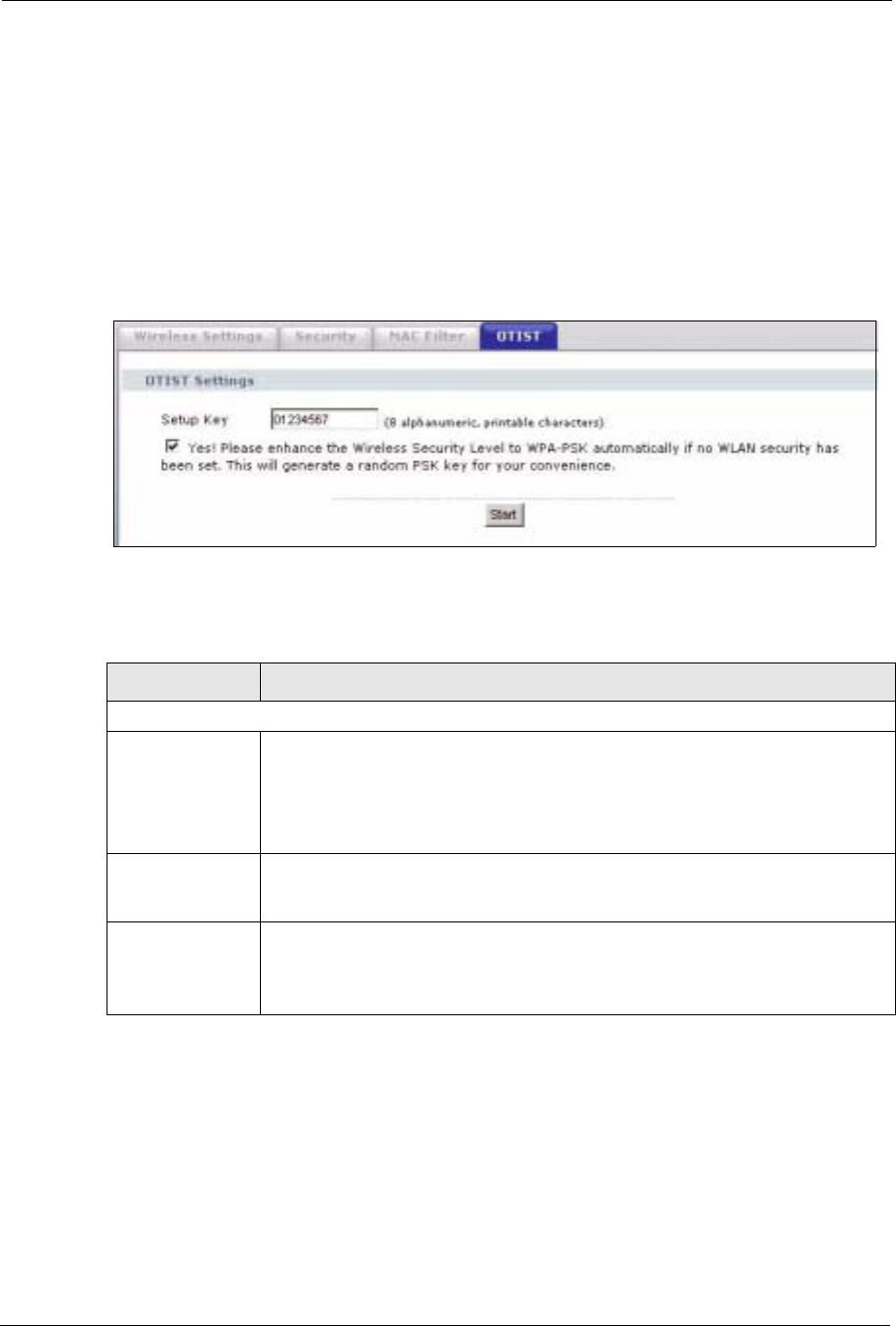
ZyXEL G-570S User’s Guide
90 Chapter 6 Wireless Screens
Hold in the OTIST button for one or two seconds.
6.17.1.1.2 Web Configurator
Click WIRELESS > SETTINGS > OTIST to configure and enable OTIST. The screen
appears as shown.
Note: At the time of writing the device does not support OTIST in the wireless client
mode.
Figure 53 OTIST
The following table describes the labels in this screen.
6.17.1.2 Wireless Client
Start the ZyXEL utility and click the Adapter tab. Select the OTIST check box, enter the
same Setup Key as your AP’s and click Save.
Table 23 OTIST
LABEL DESCRIPTION
One-Touch Intelligent Security Technology
Setup Key Enter the setup key of up to eight printable characters. The default OTIST setup
key is "01234567".
Note: If you change the OTIST setup key here, you must also make
the same change on the wireless client(s).
Yes! To have OTIST automatically generate a WPA-PSK key, select this check box. If
you manually configured a WEP key or a WPA-PSK key and you also select this
check box, then the key you manually configured is used.
Start Click Start to encrypt the wireless security data using the setup key and have the
device set the wireless client to use the same wireless settings as the device. You
must also activate and start OTIST on the wireless client at the same time.
The process takes three minutes to complete.
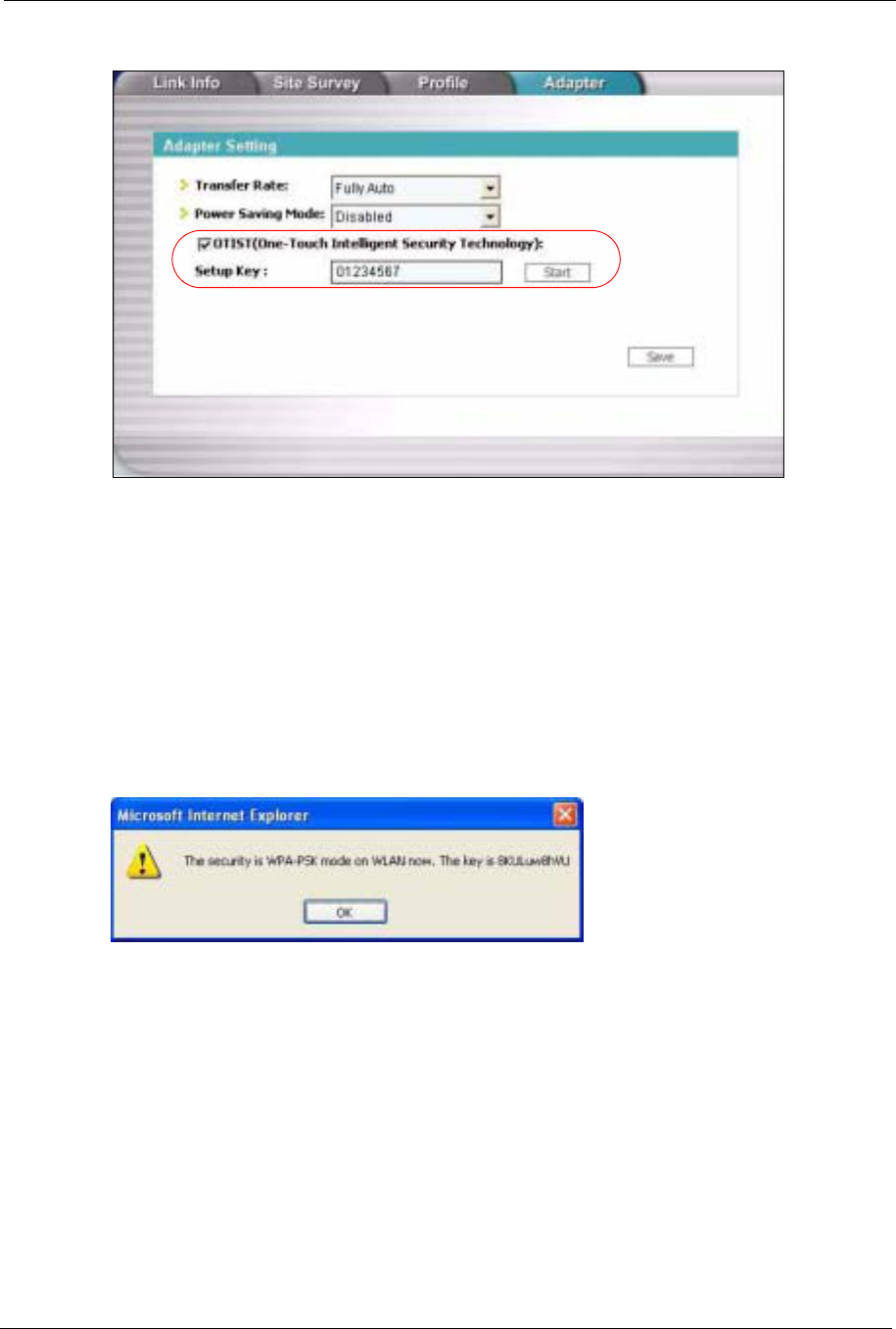
ZyXEL G-570S User’s Guide
Chapter 6 Wireless Screens 91
Figure 54 Example Wireless Client OTIST Screen
6.17.2 Starting OTIST
Note: You must click Start in the AP OTIST web configurator screen and in the
wireless client(s) Adapter screen all within three minutes (at the time of
writing). You can start OTIST in the wireless clients and AP in any order but
they must all be within range and have OTIST enabled.
1In the AP, a web configurator screen pops up showing you the security settings to
transfer. After reviewing the settings, click OK.
Figure 55 Security Key
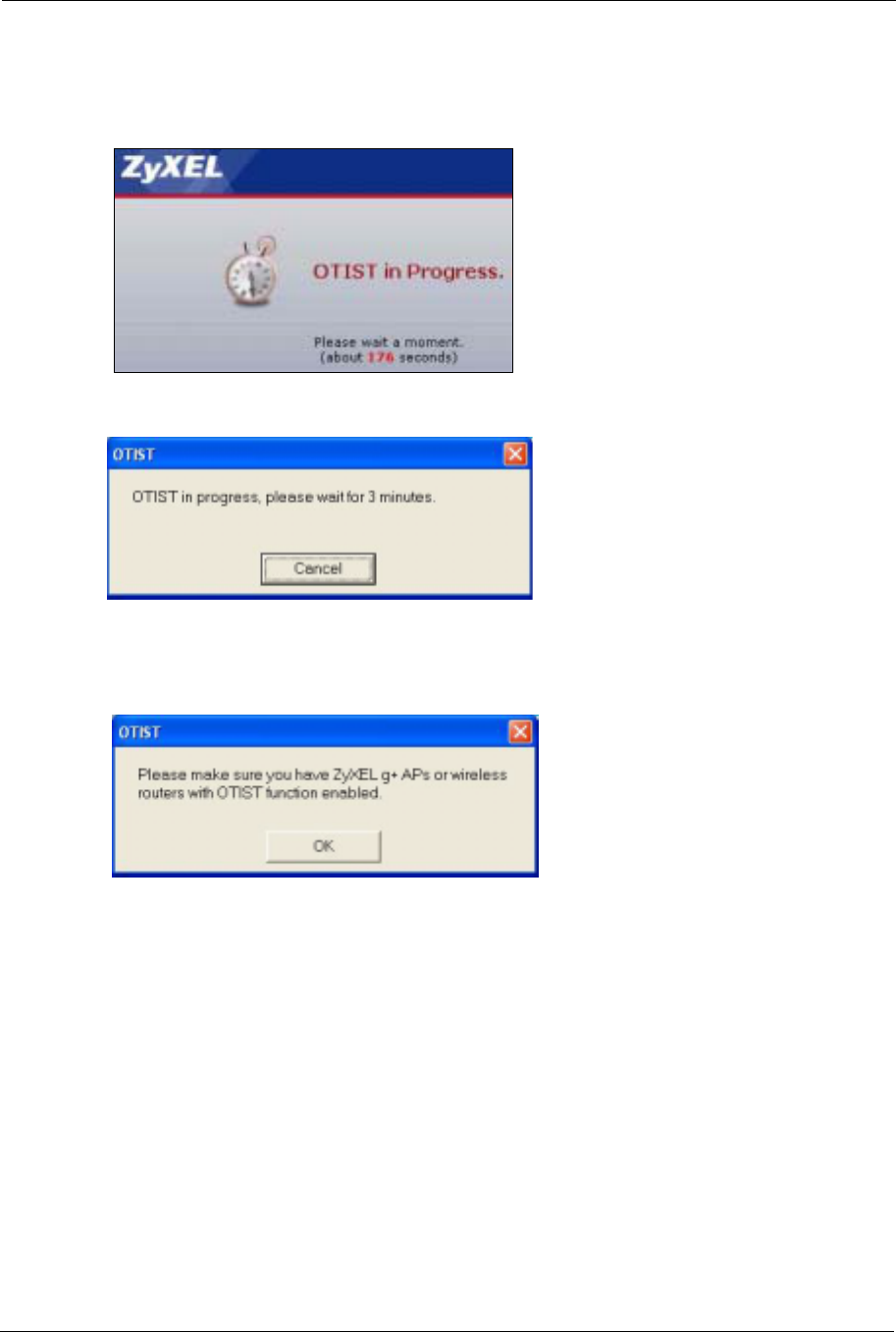
ZyXEL G-570S User’s Guide
92 Chapter 6 Wireless Screens
2This screen appears while OTIST settings are being transferred. It closes when the
transfer is complete.
Figure 57 OTIST in Progress (Client)
• In the wireless client, you see this screen if it can't find an OTIST-enabled AP (with the
sameSetup key). Click OK to go back to the ZyXEL utility main screen.
Figure 58 No AP with OTIST Found
• If there is more than one OTIST-enabled AP within range, you see a screen asking you to
select one AP to get settings from.
6.17.3 Notes on OTIST
1If you enabled OTIST in the wireless client, you see this screen each time you start the
utility. Click Yes for it to search for an OTIST-enabled AP.
Figure 56 OTIST in Progress (AP)

ZyXEL G-570S User’s Guide
Chapter 6 Wireless Screens 93
Figure 59 Start OTIST?
2If an OTIST-enabled wireless client loses its wireless connection for more than ten
seconds, it will search for an OTIST-enabled AP for up to one minute. (If you manually
have the wireless client search for an OTIST-enabled AP, there is no timeout; click
Cancel in the OTIST progress screen to stop the search.)
3When the wireless client finds an OTIST-enabled AP, you must still click Start in the AP
OTIST web configurator screen or hold in the OTIST button (for one or two seconds)
for the AP to transfer settings.
4If you change the SSID or the keys on the AP after using OTIST, you need to run OTIST
again or enter them manually in the wireless client(s).
5If you configure OTIST to generate a WPA-PSK key, this key changes each time you run
OTIST. Therefore, if a new wireless client joins your wireless network, you need to run
OTIST on the AP and ALL wireless clients again.

ZyXEL G-570S User’s Guide
94 Chapter 6 Wireless Screens
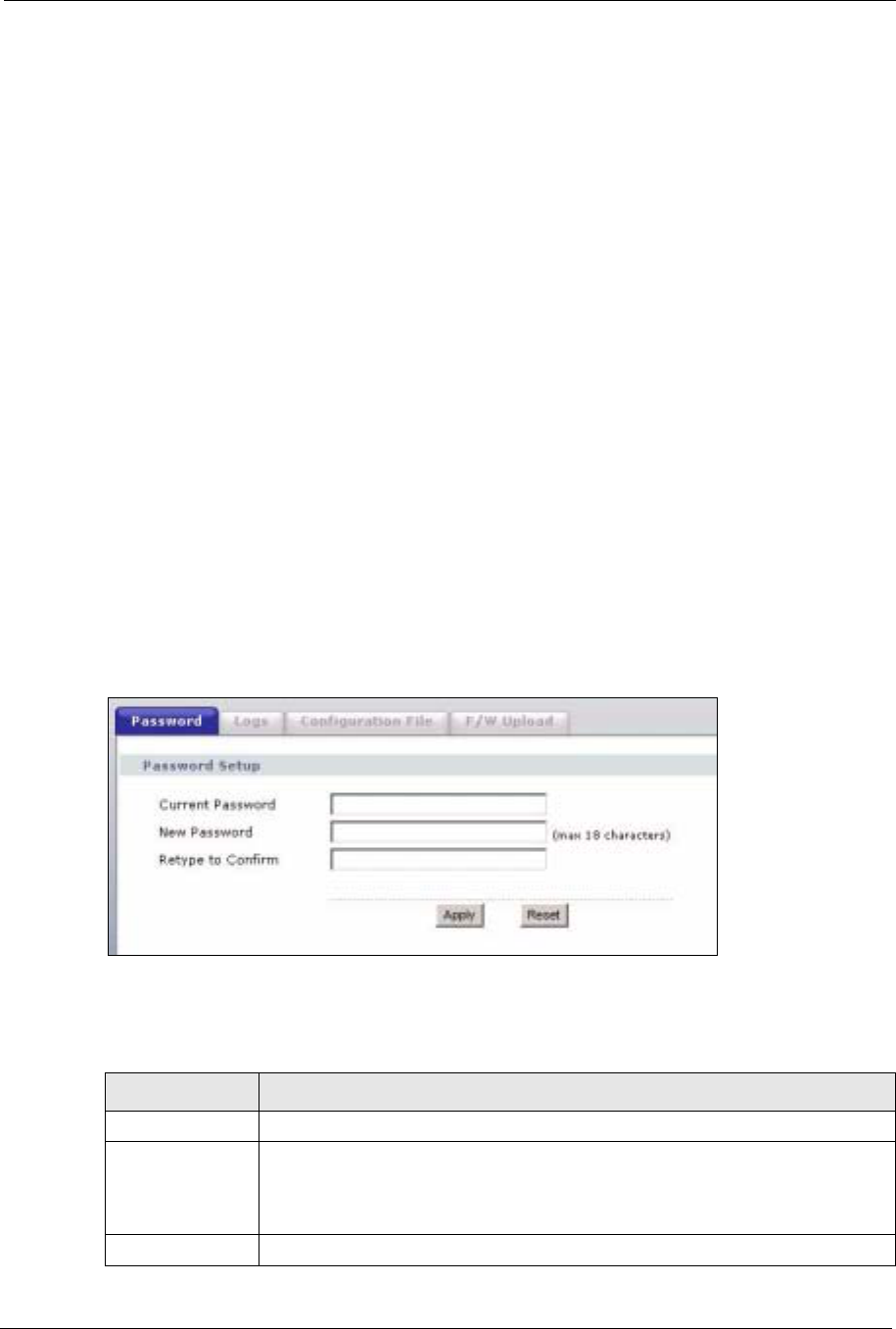
ZyXEL G-570S User’s Guide
Chapter 7 Management Screens 95
CHAPTER 7
Management Screens
This chapter describes the Maintenance screens.
7.1 Maintenance Overview
Use these maintenance screens to change the password, view logs, back up or restore the G-
570S configuration and change the web configurator language.
7.2 Password
To change your device's password (recommended), click SETTINGS > MANAGEMENT.
The screen appears as shown. This screen allows you to change the device's password.
If you forget your password (or the device IP address), you will need to reset the device. See
the section on resetting the device for details.
Figure 60 Management: Password
The following table describes the labels in this screen.
Table 24 Management: Password
LABEL DESCRIPTION
Current Password Type in your existing system password (1234 is the default password).
New Password Type your new system password (up to 30 printable characters). Spaces are not
allowed.
Note that as you type a password, the screen displays an asterisk (*) for each
character you type.
Retype to Confirm Retype your new system password for confirmation.
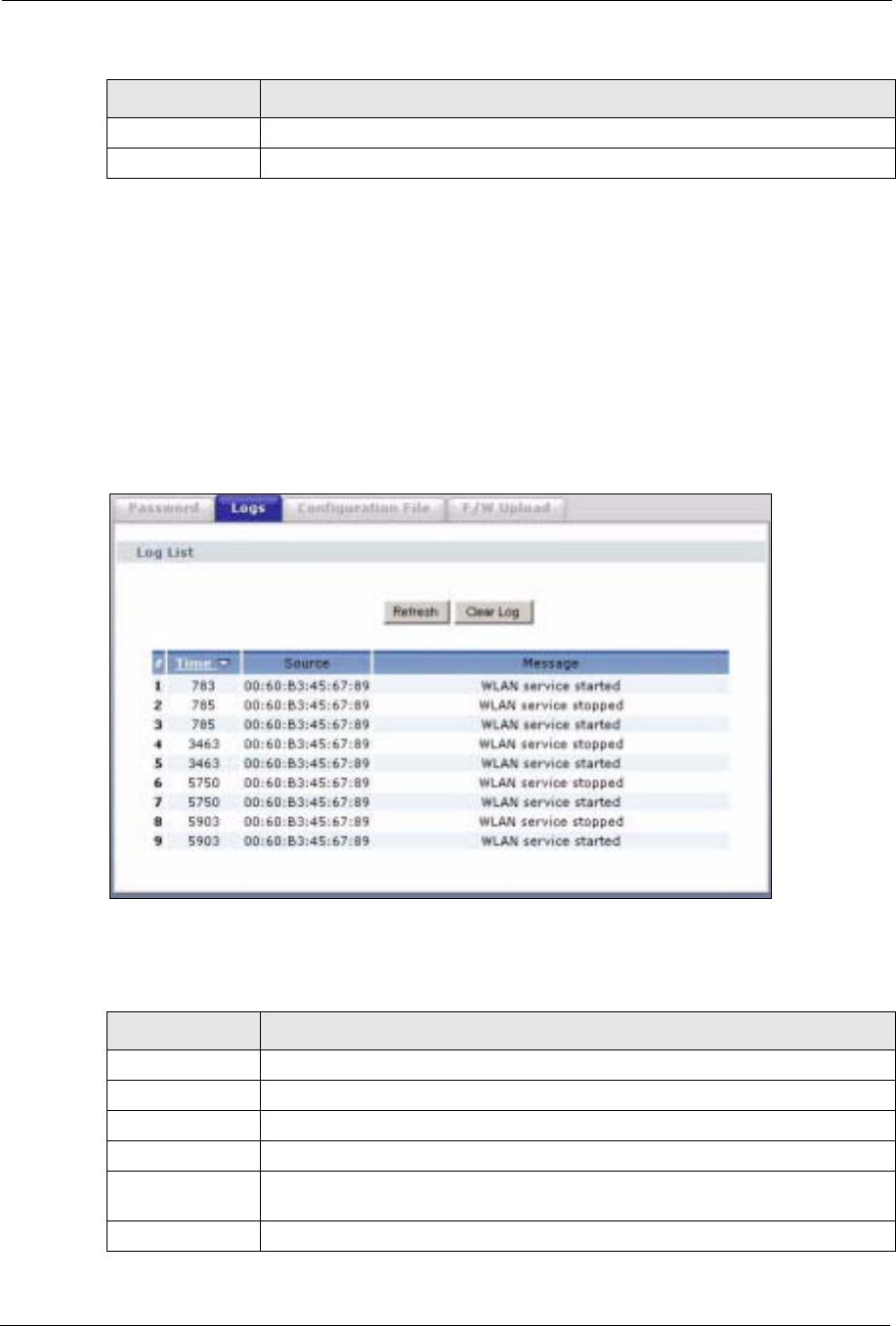
ZyXEL G-570S User’s Guide
96 Chapter 7 Management Screens
7.3 Logs
Click SETTINGS > MANAGEMENT > Logs to open the Logs screen.
You can view logs and alert messages in this screen. Once the log table is full, old logs are
deleted as new logs are created.
Click a column heading to sort the entries. A triangle indicates the direction of the sort order.
Figure 61 Management: Logs
The following table describes the labels in this screen.
Apply Click Apply to save your changes back to the device.
Cancel Click Cancel to reload the previous configuration for this screen.
Table 24 Management: Password (continued)
LABEL DESCRIPTION
Table 25 Management: Logs
LABEL DESCRIPTION
Display Select a category of logs to view.
Refresh Click Refresh to renew the log screen.
Clear Log Click Clear Log to clear all the logs.
# This is the log’s index number.
Time This field displays the time the log was recorded. It is the number of seconds since
the last time the system turned on.
Message This field states the reason for the log.
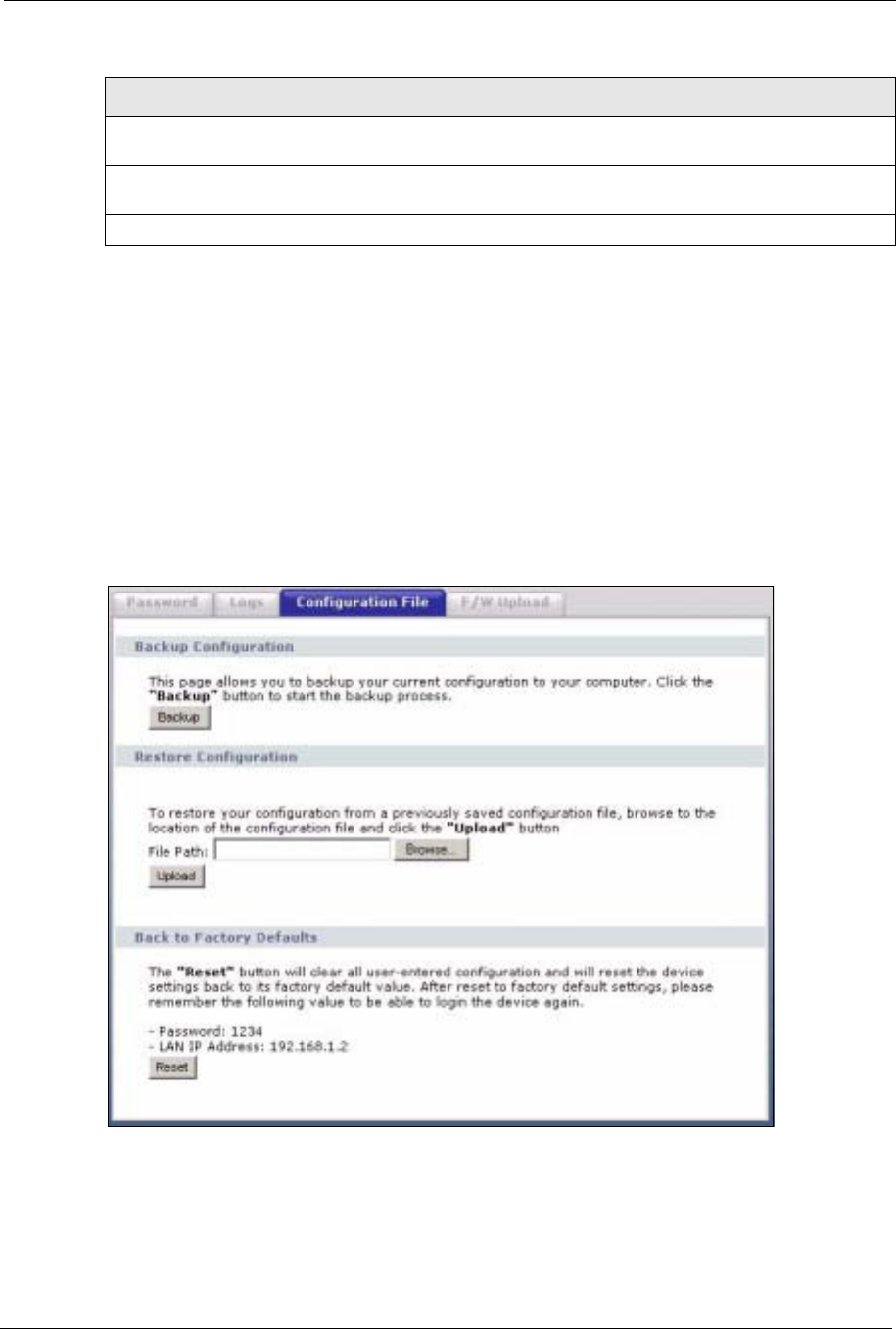
ZyXEL G-570S User’s Guide
Chapter 7 Management Screens 97
7.4 Configuration File
The configuration file (often called the romfile or rom-0) contains the factory default settings
such as password and TCP/IP Setup, etc. It arrives from ZyXEL with a .rom filename
extension. Once you have customized the device's settings, they can be saved back to your
computer under a filename of your choosing.
Click SETTINGS > MANAGEMENT > Configuration File. Information related to factory
defaults, backup configuration, and restoring configuration appears as shown next.
Figure 62 Management: Configuration File
Source This field lists the source IP address and the port number of the incoming packet
that caused the log.
Destination This field lists the destination IP address and the port number of the outgoing
packet that caused the log.
Note This field displays additional information about the log entry.
Table 25 Management: Logs (continued)
LABEL DESCRIPTION
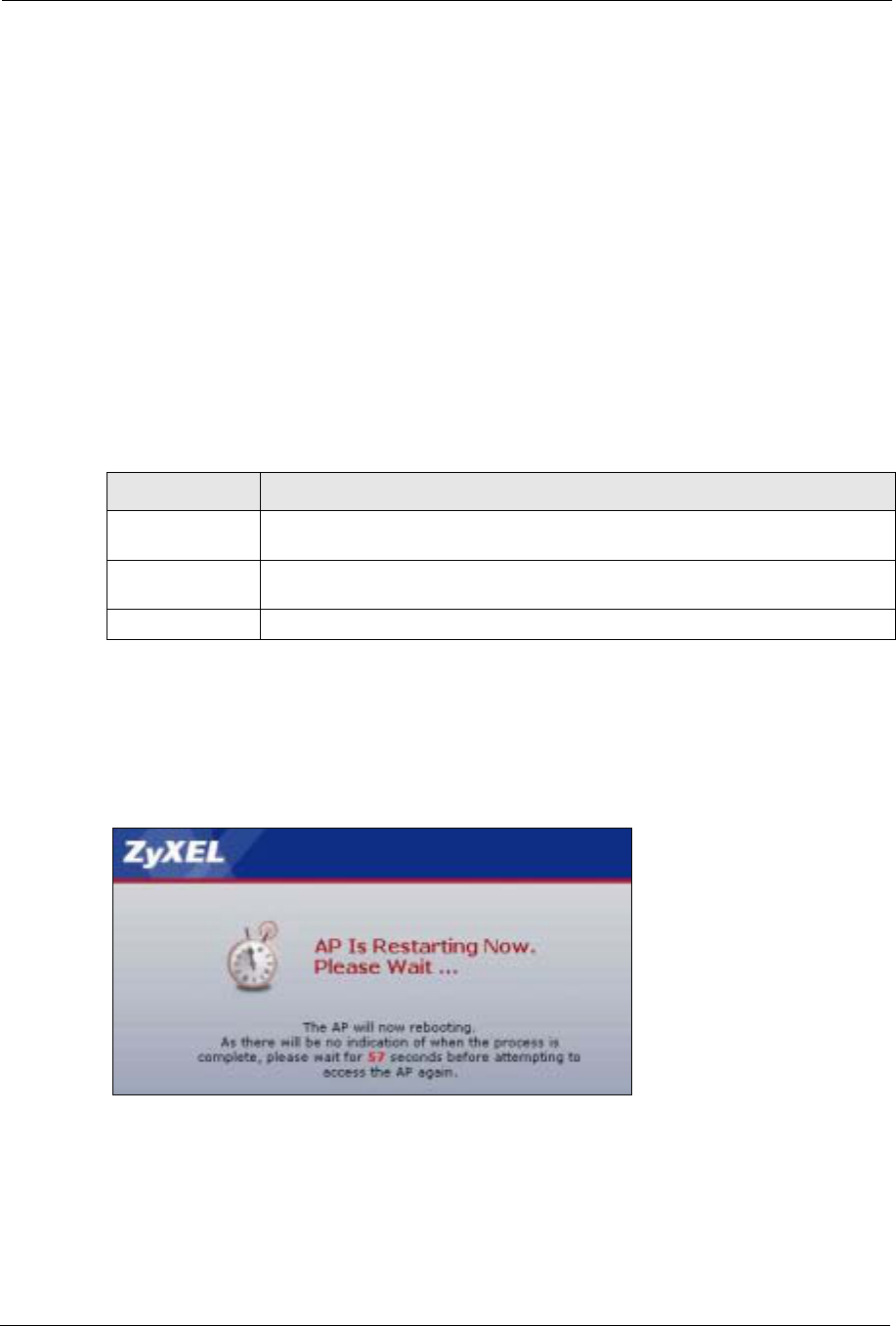
ZyXEL G-570S User’s Guide
98 Chapter 7 Management Screens
7.4.1 Backup Configuration
Backup configuration allows you to back up (save) the device's current configuration to a file
on your computer. Once your device is configured and functioning properly, it is highly
recommended that you back up your configuration file before making configuration changes.
The backup configuration file will be useful in case you need to return to your previous
settings.
Click Backup to save the device's current configuration to your computer.
7.4.2 Restore Configuration
Restore configuration allows you to upload a new or previously saved configuration file from
your computer to your device.
Note: Do not turn off the device while configuration file upload is in progress.
The following screen displays. You must wait one minute before logging into the device
again.
Figure 63 Configuration Upload Successful
The device automatically restarts in this time causing a temporary network disconnect. In
some operating systems, you may see the following icon on your desktop.
Table 26 Management: Configuration File: Restore Configuration
LABEL DESCRIPTION
File Path Type in the location of the file you want to upload in this field or click Browse ... to
find it.
Browse... Click Browse... to find the file you want to upload. Remember that you must
decompress compressed (.zip) files before you can upload them.
Upload Click Upload to begin the upload process.
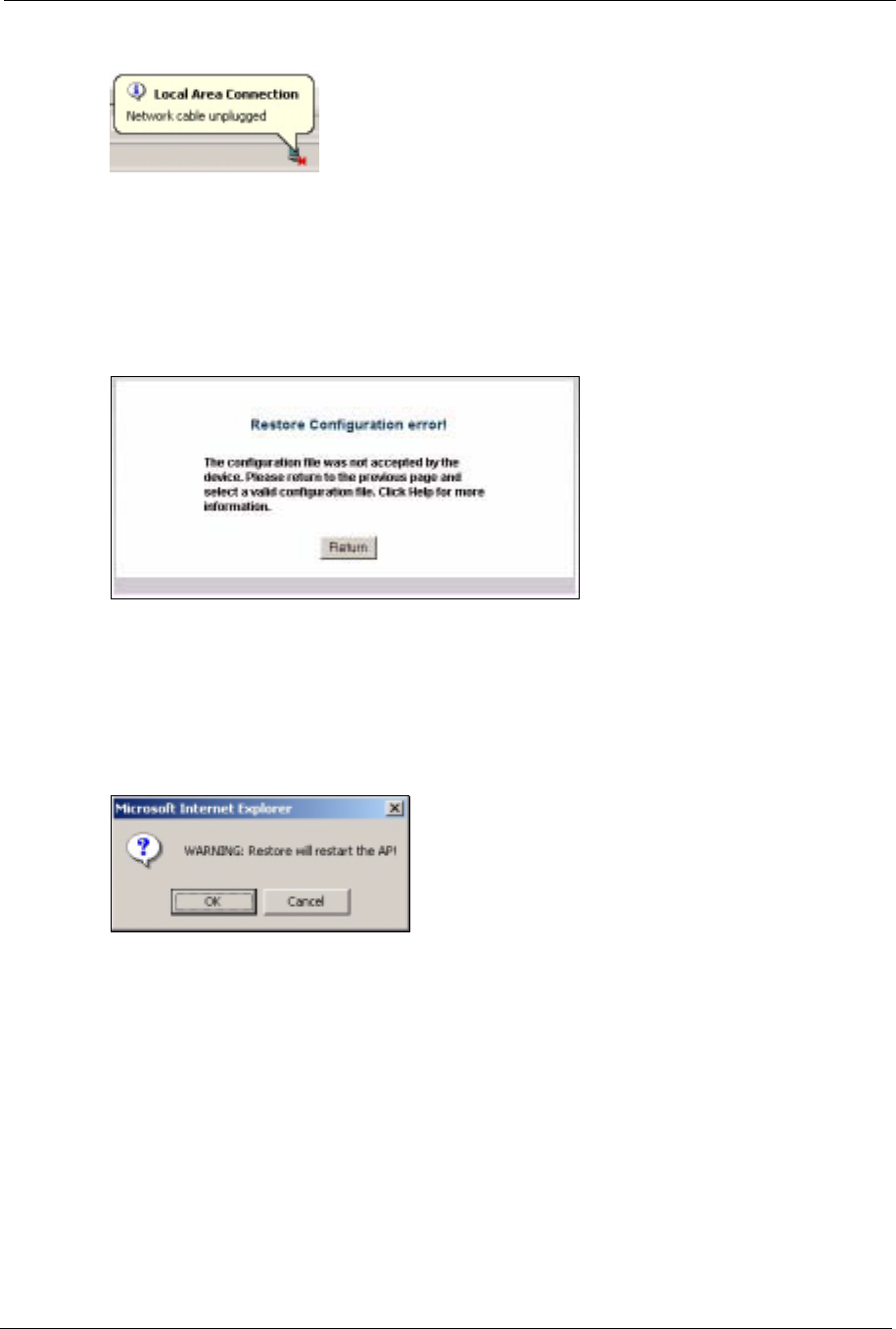
ZyXEL G-570S User’s Guide
Chapter 7 Management Screens 99
Figure 64 Network Temporarily Disconnected
If you uploaded the default configuration file you may need to change the IP address of your
computer to be in the same subnet as that of the default device IP address (192.168.1.2).
If the upload was not successful, the following screen will appear. Click Return to go back to
the Configuration File screen.
Figure 65 Configuration Upload Error
7.4.3 Back to Factory Defaults
Clicking the RESET button in this section clears all user-entered configuration information
and returns the device to its factory defaults. The following warning screen will appear.
Figure 66 Reset Warning Message
You can also press the RESET button on the rear panel to reset the factory defaults of your
device. Refer to the section on resetting the device for more information on the RESET
button.
7.5 F/W Upload Screen
Find firmware at www.zyxel.com in a file that (usually) uses the system model name with a
.rmt extension, for example, "zyxel.rmt". The upload process uses HTTP (Hypertext Transfer
Protocol) and may take up to two minutes. After a successful upload, the system will reboot.
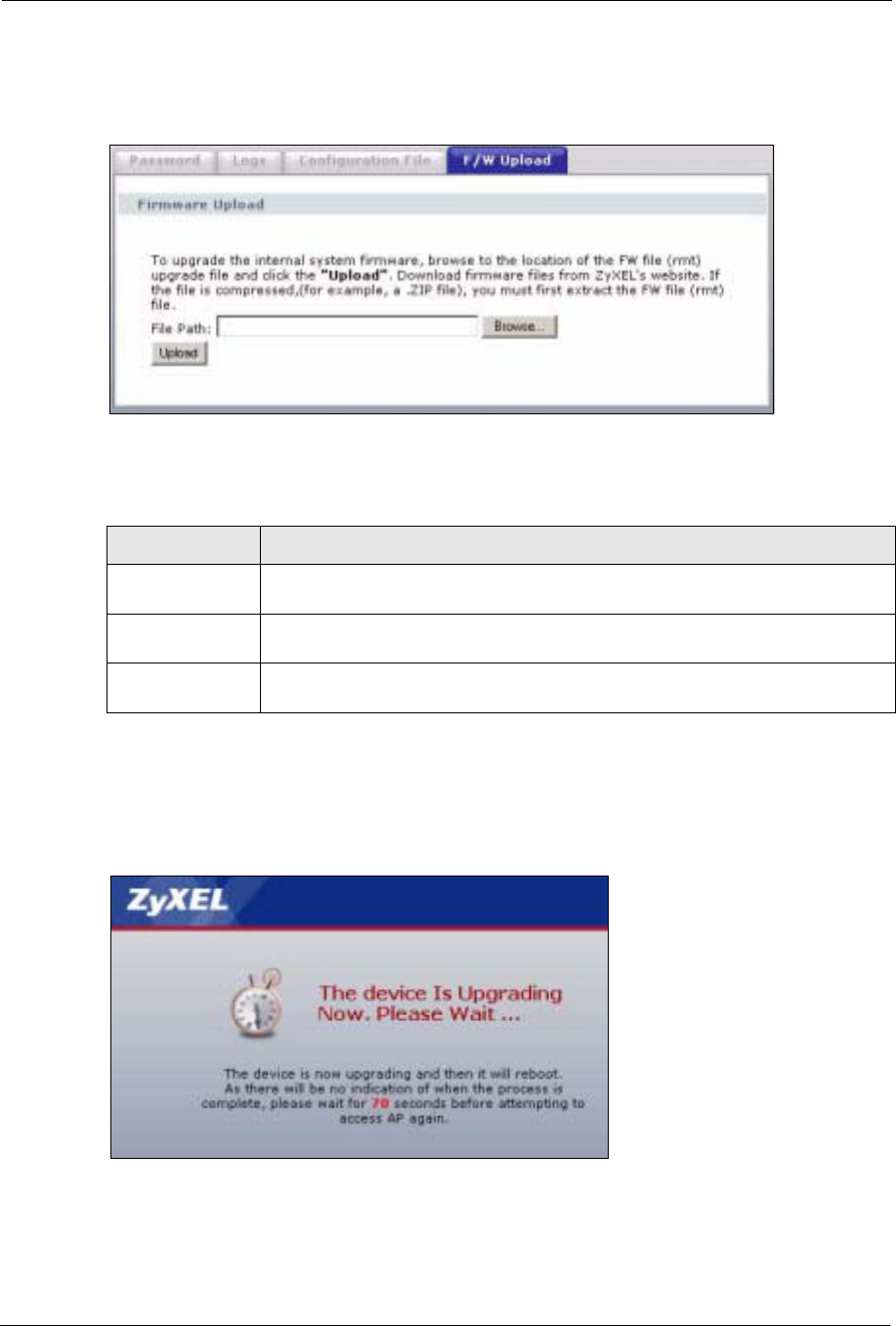
ZyXEL G-570S User’s Guide
100 Chapter 7 Management Screens
Click SETTINGS > MANAGEMENT > F/W Upload to display the screen as shown.
Follow the instructions in this screen to upload firmware to your device.
Figure 67 Management: F/W Upload
The following table describes the labels in this screen.
Note: Do not turn off the device while firmware upload is in progress!
The following screen appears. Wait two minutes before logging into the device again.
Figure 68 Firmware Upgrading Screen
The device automatically restarts in this time causing a temporary network disconnect. In
some operating systems, you may see the following icon on your desktop.
Table 27 Management: F/W Upload
LABEL DESCRIPTION
File Path Type in the location of the file you want to upload in this field or click Browse ... to
find it.
Browse... Click Browse... to find the .rmt file you want to upload. Remember that you must
decompress compressed (.zip) files before you can upload them.
Upload Click Upload to begin the upload process. This process may take up to two
minutes.

ZyXEL G-570S User’s Guide
Chapter 7 Management Screens 101
Figure 69 Network Temporarily Disconnected
After two minutes, log in again and check your new firmware version in the System Status
screen.
If the upload was not successful, the following status message displays at the bottom of the
screen.
Figure 70 Firmware Upload Error

ZyXEL G-570S User’s Guide
102 Chapter 7 Management Screens

ZyXEL G-570S User’s Guide
Chapter 8 Troubleshooting 103
CHAPTER 8
Troubleshooting
This chapter covers potential problems and possible remedies. After each problem description,
some instructions are provided to help you to diagnose and to solve the problem.
8.1 Problems Starting Up the G-570S
8.2 Problems with the Password
Table 28 Troubleshooting the Start-Up of Your G-570S
PROBLEM CORRECTIVE ACTION
None of the LEDs
turn on when I
plug in the power
adaptor.
Make sure you are using the supplied power adaptor and that it is plugged in to an
appropriate power source. Check that the power source is turned on.
If the problem persists, you may have a hardware problem. In this case, you should
contact your local vendor.
The G-570S
reboots
automatically
sometimes.
The supplied power to the G-570S is too low. Check that the G-570S is receiving
enough power.
Make sure the power source is working properly.
Table 29 Troubleshooting the Password
PROBLEM CORRECTIVE ACTION
I cannot access the
G-570S. The Password field is case-sensitive. Make sure that you enter the correct
password using the proper casing.
Use the RESET button on the rear panel of the G-570S to restore the factory
default configuration file (hold this button in for about 10 seconds or release the
button when the PWR LED starts blinking). This will restore all of the factory
defaults including the password.

ZyXEL G-570S User’s Guide
104 Chapter 8 Troubleshooting
8.3 Problems with the WLAN Interface
8.4 Problems with the Ethernet Interface
Table 30 Troubleshooting the WLAN Interface
PROBLEM CORRECTIVE ACTION
Cannot access the
G-570S from the
WLAN.
Make sure the wireless adapter on the wireless station is working properly.
Check that both the G-570S and your wireless station are using the same
ESSID, channel and security settings.
I cannot ping any
computer on the
WLAN.
Make sure the wireless adapter on the wireless station(s) is working properly.
Check that both the G-570S and wireless station(s) are using the same ESSID,
channel and security settings.
Table 31 Troubleshooting the Ethernet Interface
PROBLEM CORRECTIVE ACTION
I cannot access the
G-570S from the
LAN.
If the ETHN LED on the front panel is off, check the Ethernet cable connection
between your G-570S and the Ethernet device connected to the ETHERNET
port.
Check for faulty Ethernet cables.
Make sure your computer’s Ethernet adapter is installed and working properly.
Check the IP address of the Ethernet device. Verify that the IP address and the
subnet mask of the G-570S, the Ethernet device and your computer are on the
same subnet.
I cannot ping any
computer on the
LAN.
If the ETHN LED on the front panel is off, check the Ethernet cable connections
between your G-570S and the Ethernet device.
Check the Ethernet cable connections between the Ethernet device and the
LAN computers.
Check for faulty Ethernet cables.
Make sure the LAN computer’s Ethernet adapter is installed and working
properly.
Verify that the IP address and the subnet mask of the G-570S, the Ethernet
device and the LAN computers are on the same subnet.

ZyXEL G-570S User’s Guide
Chapter 8 Troubleshooting 105
8.4.1 Pop-up Windows, JavaScripts and Java Permissions
In order to use the web configurator you need to allow:
• Web browser pop-up windows from your device.
• JavaScripts (enabled by default).
• Java permissions (enabled by default).
Note: Internet Explorer 6 screens are used here. Screens for other Internet Explorer
versions may vary.
8.4.1.1 Internet Explorer Pop-up Blockers
You may have to disable pop-up blocking to log into your device.
Either disable pop-up blocking (enabled by default in Windows XP SP (Service Pack) 2) or
allow pop-up blocking and create an exception for your device’s IP address.
Cannot access the
web configurator. Your computer’s and the G-570S’s IP addresses must be on the same subnet
for LAN access.
If you changed the G-570S’s IP address, then enter the new one as the URL.
If you don’t know the G-570S’s IP address, type the device name of your G-
570S as the URL. ZyXELXXXX is the default where “XXXX” is the last four digits
of the MAC address. The MAC address is on the bottom of the device).
If you just changed the G-570S’s IP address, your computer’s cache of machine
names may contain an entry that maps the name of the G-570S to its previous
IP address.
In Windows, use nbtstat -R at the command prompt to delete all entries in your
computer’s cache of machine names.
Open a new browser window.
See the following section to check that pop-up windows, JavaScripts and Java
permissions are allowed.
You may also need to clear your Internet browser’s cache.
In Internet Explorer, click Tools and then Internet Options to open the Internet
Options screen.
In the General tab, click Delete Files. In the pop-up window, select the Delete
all offline content check box and click OK. Click OK in the Internet Options
screen to close it.
If you disconnect your computer from one device and connect it to another
device that has the same IP address, your computer’s ARP (Address Resolution
Protocol) table may contain an entry that maps the management IP address to
the previous device’s MAC address).
In Windows, use arp -d at the command prompt to delete all entries in your
computer’s ARP table.
Open a new browser window.
Table 31 Troubleshooting the Ethernet Interface (continued)
PROBLEM CORRECTIVE ACTION
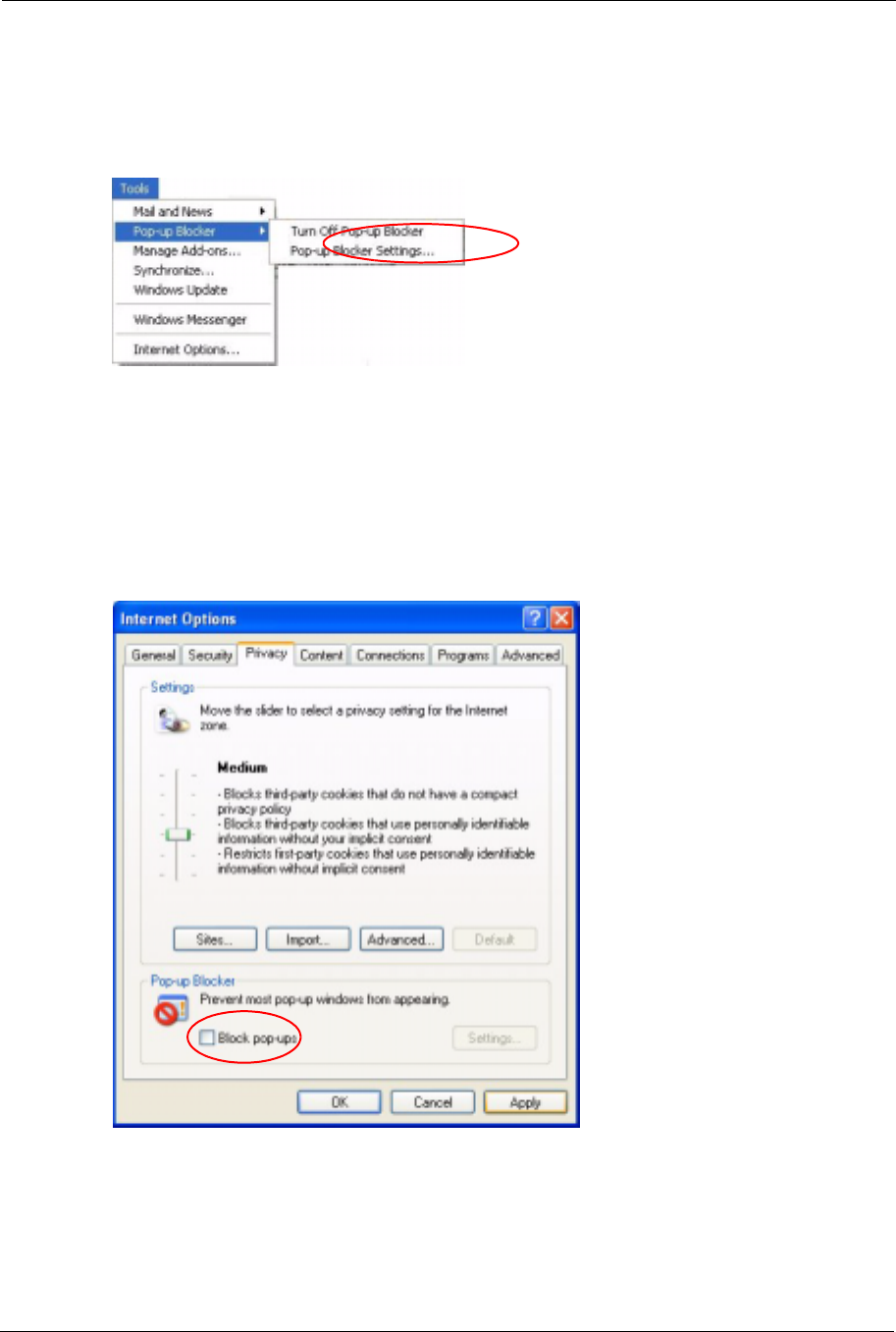
ZyXEL G-570S User’s Guide
106 Chapter 8 Troubleshooting
8.4.1.1.1 Disable pop-up Blockers
1In Internet Explorer, select Tools,Pop-up Blocker and then select Turn Off Pop-up
Blocker.
Figure 71 Pop-up Blocker
You can also check if pop-up blocking is disabled in the Pop-up Blocker section in the
Privacy tab.
1In Internet Explorer, select Tools,Internet Options,Privacy.
2Clear the Block pop-ups check box in the Pop-up Blocker section of the screen. This
disables any web pop-up blockers you may have enabled.
Figure 72 Internet Options
3Click Apply to save this setting.
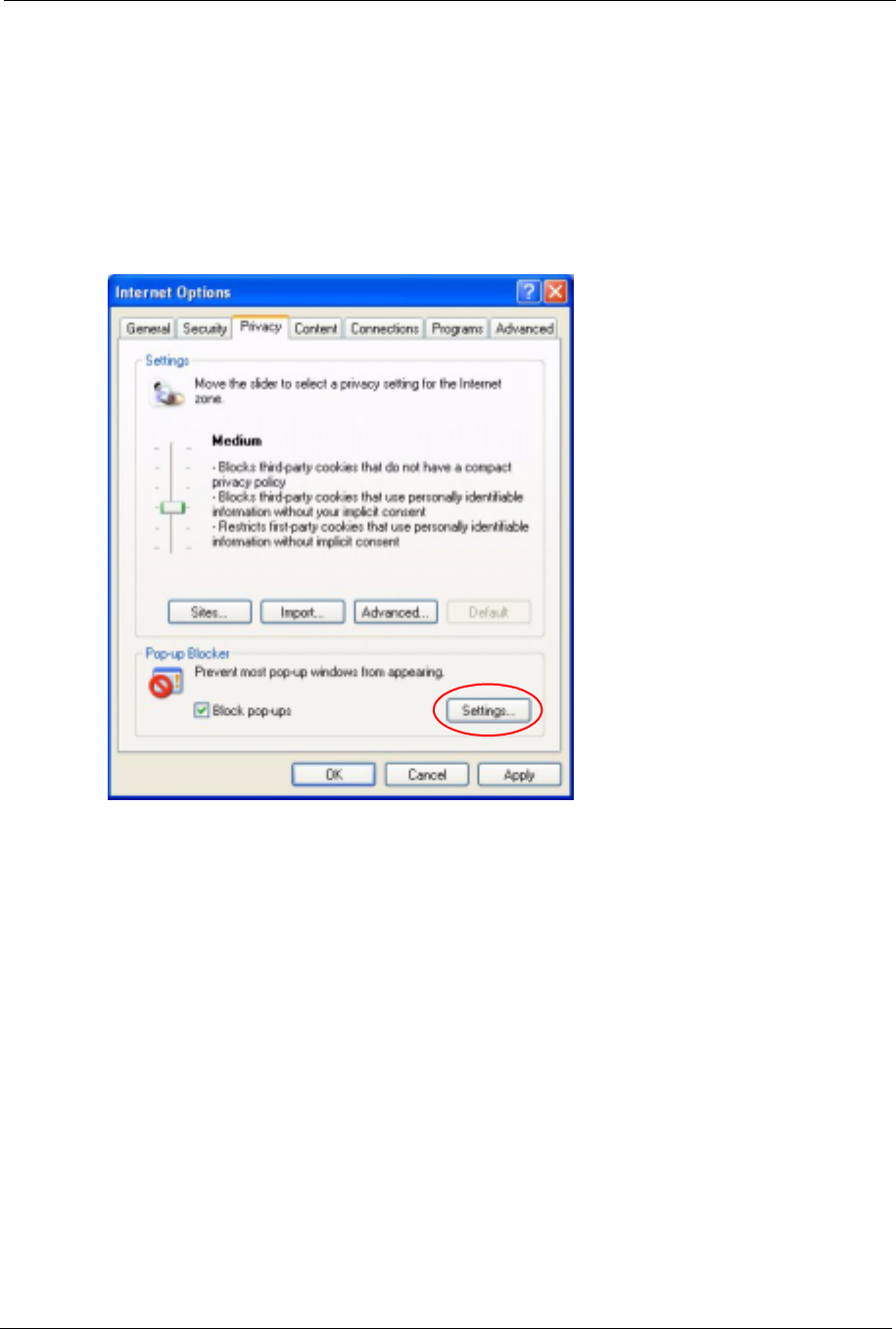
ZyXEL G-570S User’s Guide
Chapter 8 Troubleshooting 107
8.4.1.1.2 Enable pop-up Blockers with Exceptions
Alternatively, if you only want to allow pop-up windows from your device, see the following
steps.
1In Internet Explorer, select Tools,Internet Options and then the Privacy tab.
2Select Settings…to open the Pop-up Blocker Settings screen.
Figure 73 Internet Options
3Type the IP address of your device (the web page that you do not want to have blocked)
with the prefix “http://”. For example, http://192.168.1.1.
4Click Add to move the IP address to the list of Allowed sites.
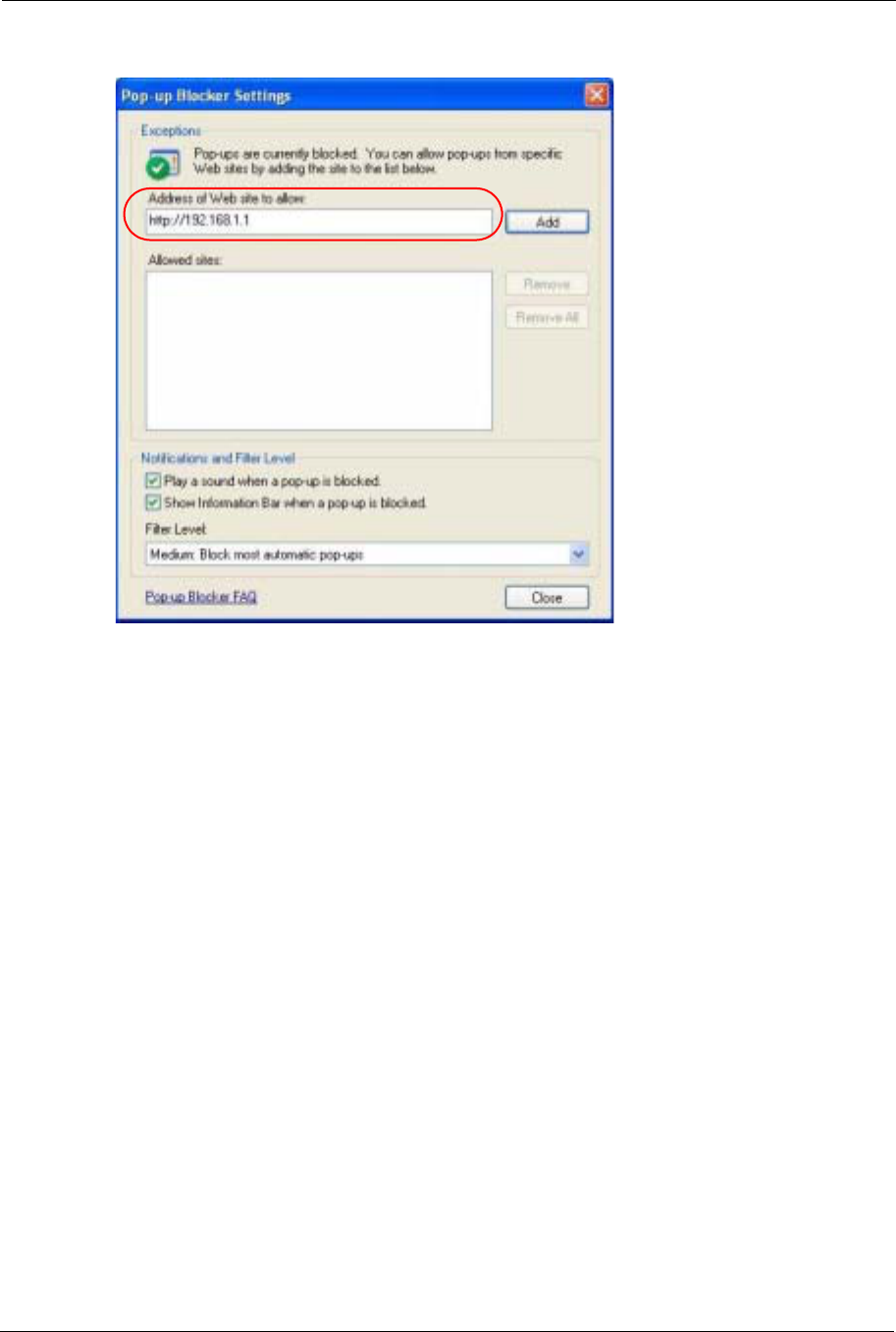
ZyXEL G-570S User’s Guide
108 Chapter 8 Troubleshooting
Figure 74 Pop-up Blocker Settings
5Click Close to return to the Privacy screen.
6Click Apply to save this setting.
8.4.1.2 JavaScripts
If pages of the web configurator do not display properly in Internet Explorer, check that
JavaScripts are allowed.
1In Internet Explorer, click Tools,Internet Options and then the Security tab.
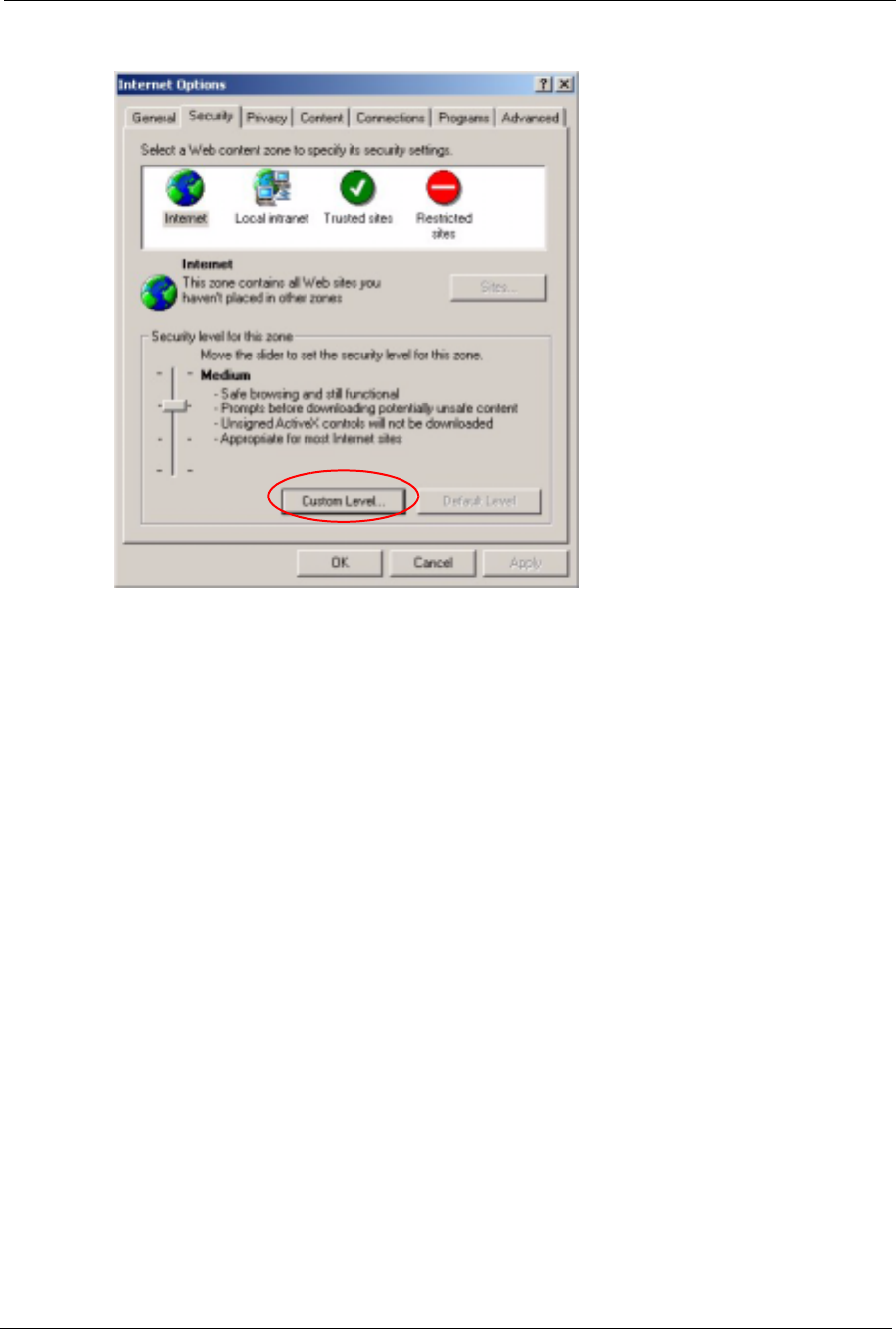
ZyXEL G-570S User’s Guide
Chapter 8 Troubleshooting 109
Figure 75 Internet Options
2Click the Custom Level... button.
3Scroll down to Scripting.
4Under Active scripting make sure that Enable is selected (the default).
5Under Scripting of Java applets make sure that Enable is selected (the default).
6Click OK to close the window.
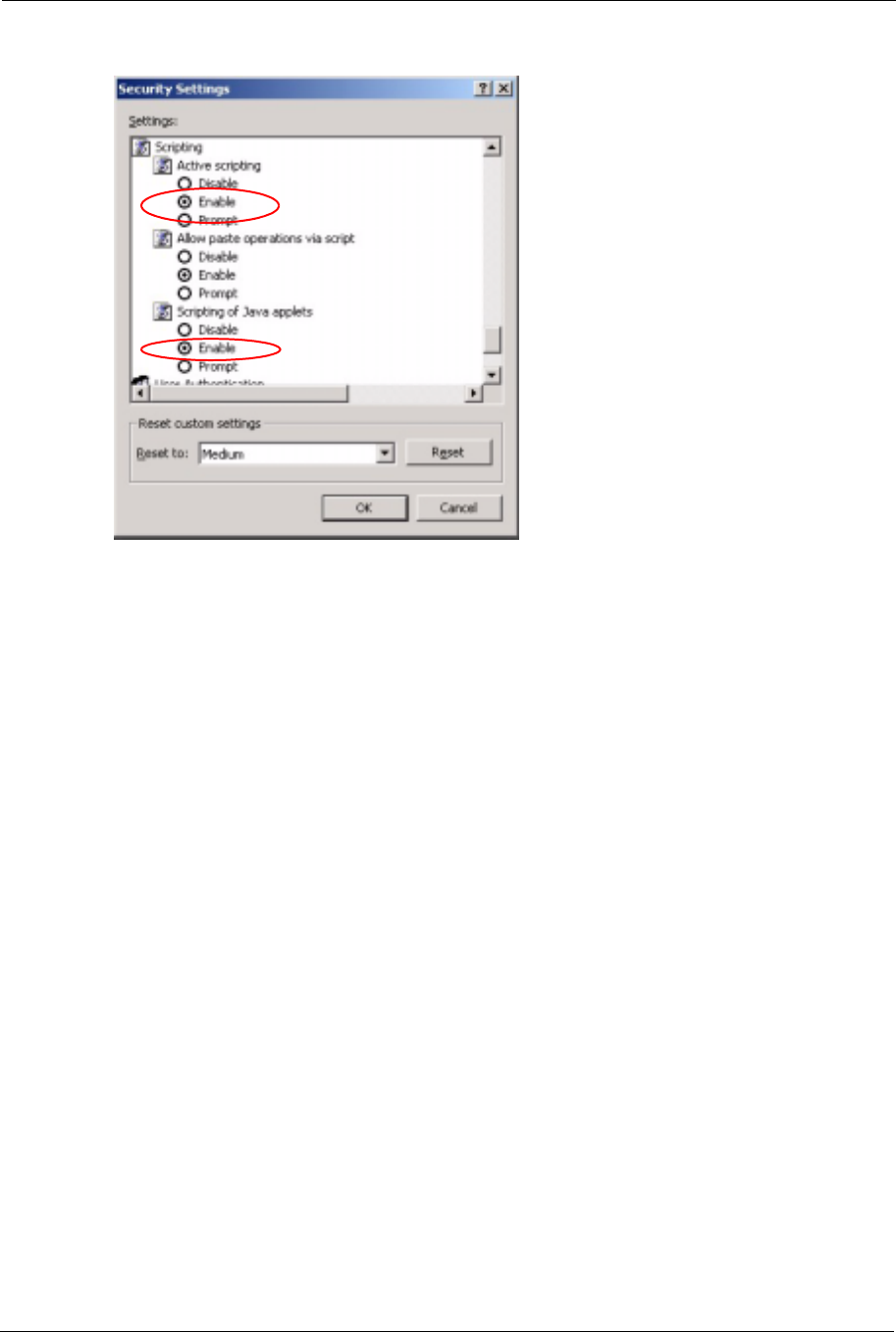
ZyXEL G-570S User’s Guide
110 Chapter 8 Troubleshooting
Figure 76 Security Settings - Java Scripting
8.4.1.3 Java Permissions
1From Internet Explorer, click Tools,Internet Options and then the Security tab.
2Click the Custom Level... button.
3Scroll down to Microsoft VM.
4Under Java permissions make sure that a safety level is selected.
5Click OK to close the window.
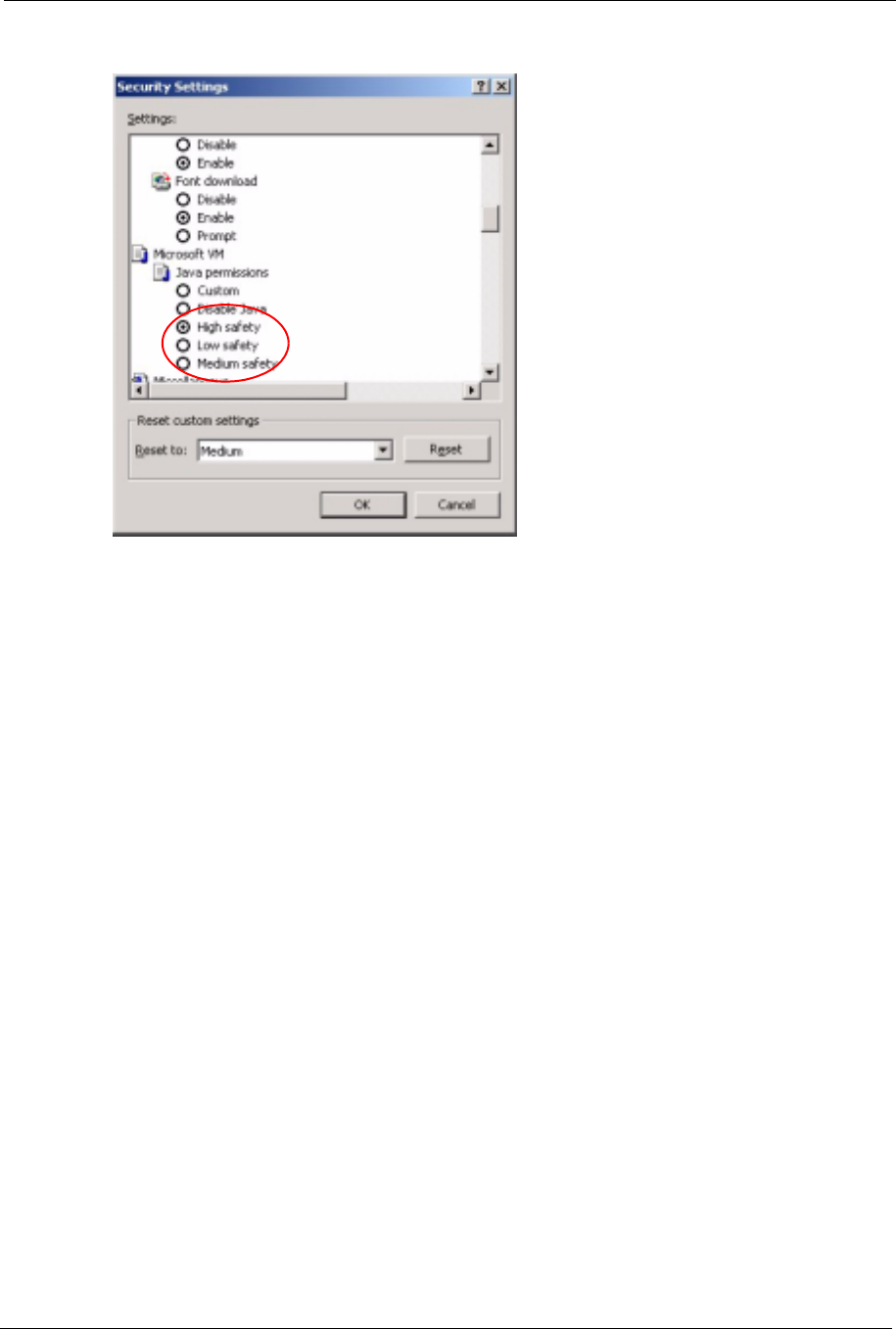
ZyXEL G-570S User’s Guide
Chapter 8 Troubleshooting 111
Figure 77 Security Settings - Java
8.4.1.3.1 JAVA (Sun)
1From Internet Explorer, click Tools,Internet Options and then the Advanced tab.
2make sure that Use Java 2 for <applet> under Java (Sun) is selected.
3Click OK to close the window.
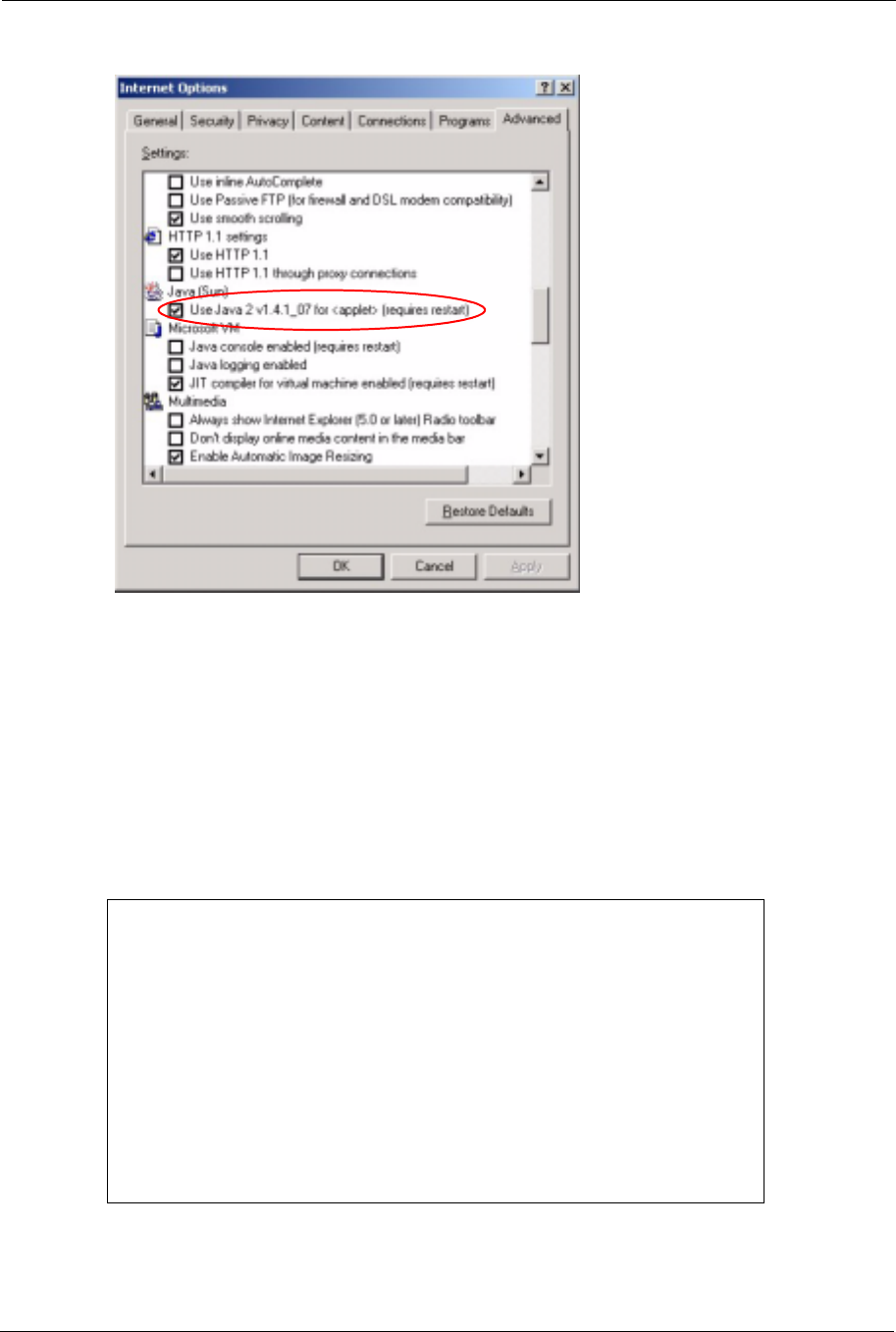
ZyXEL G-570S User’s Guide
112 Chapter 8 Troubleshooting
Figure 78 Java (Sun)
8.5 Testing the Connection to the G-570S
1Click Start,(All) Programs,Accessories and then Command Prompt.
2In the Command Prompt window, type “ping” followed by a space and the IP address of
the G-570S (192.168.1.2 is the default).
3Press ENTER. The following screen displays.
Figure 79 Pinging the G-650
Your computer can now communicate with the G-570S via the ETHERNET port.
C:\>ping 192.168.1.2
Pinging 192.168.1.2 with 32 bytes of data:
Reply from 192.168.1.2: bytes=32 time=10ms TTL=254
Reply from 192.168.1.2: bytes=32 time<10ms TTL=254
Reply from 192.168.1.2: bytes=32 time<10ms TTL=254
Reply from 192.168.1.2: bytes=32 time<10ms TTL=254
Ping statistics for 192.168.1.2:
Packets: Sent = 4, Received = 4, Lost = 0 (0% loss),
Approximate round trip times in milli-seconds:
Minimum = 0ms, Maximum = 10ms, Average = 2m

ZyXEL G-570S User’s Guide
Chapter 8 Troubleshooting 113

ZyXEL G-570S User’s Guide
114 Chapter 8 Troubleshooting

ZyXEL G-570S User’s Guide
Appendix A Product Specifications 115
APPENDIX A
Product Specifications
See also the introduction chapter for a general overview of the key features.
Specification Tables
Table 32 Device Specifications
Default IP Address 192.168.1.2
Default Subnet Mask 255.255.255.0 (24 bits)
Default Password 1234
Dimensions 112 mm (Wide) × 106 mm (Deep) × 28.5 mm (High)
Weight 203 g
Ethernet Port One auto-negotiating, auto MDI/MDI-X 10/100 Mbps RJ-45 Ethernet port
Antenna 1 detachable dipole antenna
Power Requirements 12VDC @ 1 Amp maximum
Operation Temperature 0º C ~ 50º C
Storage Temperature -30º ~ 60º C
Operation Humidity 20% ~ 95% RH
Storage Humidity 20% ~ 95% RH
Table 33 Feature Specifications
Protocol Support Transparent bridging for unsupported network layer protocols
DHCP Client
DHCP relay
Standard Compliance IEEE 802.3 and 802.3u 10Base-T and 100Base-TX physical layer
specification
IEEE 802.11g specification compliance for wireless LAN
IEEE 802.11b specification compliance for wireless LAN
IEEE 802.1x security standard support
Wi-Fi certificate
Roaming IEEE 802.11g compliant
IEEE 802.11b compliant
IEEE 802.11f partially compliant (without re-authentication)

ZyXEL G-570S User’s Guide
116 Appendix A Product Specifications
Operating Modes Access Point
Client
Bridge
Access Point and Repeater
Wireless Links Up to four bridge links.
Two or more repeater links are supported. It is suggested that you only use
up to three repeater links.
Management Embedded Web Configurator
Command-line interface
Telnet support (Password-protected telnet access to internal configuration
manager).
FTP//Web for firmware downloading and configuration backup and restore.
Limitation of client connections (# is configurable, default: unlimited)
Intra BSS Block (enable/disable)
Output Power Management (4-levels)
Security WPA and IEEE 802.1x security (EAP-TLS, EAP-TTLS, LEAP,. EAP-PEAP
and Win XP PEAP included)
64/128/152-bits WEP
WPA/WPA2 support based on 802.11i standard
Dynamic WEP key exchange
MAC address filtering through WLAN (supports up to 32 MAC address
entries
AES Support
Diagnostics Capabilities Built-in Diagnostic Tools for FLASH memory, RAM, Ethernet port and
wireless port.
Syslog
Error log
Trace Log
Packet Log
Hardware Features Restore Factory Defaults (reset) Button
Status LEDs
•PWR
•ETHN
•OTIST
•WLAN
Table 34 Wireless RF Specifications
STANDARD IEEE802.11 COMPLIANCE
Data Rate Super G/11g: 108M/54M/48M/36M/24M/18M/12M/9/6 Mbps auto
fallback
11b: 11Mbps/5.5Mbps/2Mbps/1Mbps auto fallback
Communication Method Half Duplex
Transmission/Emission Type Direct Sequence Spread Spectrum (DSSS)
Table 33 Feature Specifications (continued)

ZyXEL G-570S User’s Guide
Appendix A Product Specifications 117
Approvals
Security Wired Equivalent Privacy (WEP) data encryption
Dynamic WEP key exchange
WiFi Protected Access (WPA)
IEEE 802.1x
RF frequency range 2.412~2.462GHz: North America
2.412MHz~2.484 GHz: Japan
2.412-2.472 GHz: Europe ETSI
Data modulation type OFDM/BPSK/QPSK/CCK/PBCC/DQPSK/DBPSK
Peak Output Power 11b: 17.32 dBm
11g: 21.48 dBm
Turbo mode: 22.25 dBm
Sensitivity 54M: -65dBm 11M: -80dBm
Coverage Indoor: up to 100meters Outdoor: up to 400meters
Antenna 1 external detachable 2.05dBi dipole antenna with R-SMA connector
Table 34 Wireless RF Specifications
STANDARD IEEE802.11 COMPLIANCE
Table 35 Approvals
SAFETY
North America ANSI/UL-1950 3rd
CSA C22.2 No. 950 3rd
European Union (CE mark) EN60950 (1992+A1+A2+A3+A4+A11)
IEC 60950 3rd
EMI
North America FCC Part 15 Class B
European Union (CE mark) EN55022 Class B
EN61000-3-2
EN61000-3-3
EMS European Union (CE mark)
ELECTROSTATIC
DISCHARGE
EN61000-4-2
RADIO-FREQUENCY
ELECTROMAGNETIC FIELD
EN61000-4-3
EFT/BURST EN61000-4-4
SURGE EN61000-4-5
CONDUCTED
SUSCEPTIBILITY
EN61000-4-6
POWER MAGNETIC EN61000-4-8

ZyXEL G-570S User’s Guide
118 Appendix A Product Specifications
Power Adaptor Specifications
VOLTAGE DIPS/
INTERRUPTION
EN61000-4-11
EM FIELD FROM DIGITAL
TELEPHONES
ENV50204
LAN COMPATIBILITY SmartBit
FOR WIRELESS PC CARD
FCC Part15C, Sec15.247
ETS300 328
ETS300 826
CE mark
Table 35 Approvals (continued)
Table 36 Power Adaptor Specifications
AUSTRALIAN PLUG STANDARDS
AC Power Adapter Model AD-121AE
Input Power 240 Volts AC 50Hz
Output Power 12 Volts DC ±5% 1 Amp
Power Consumption 12 Watts
Safety Standards C-Tick
EUROPEAN PLUG STANDARDS
AC Power Adapter Model AD-121AB
Input Power 230 Volts AC 50Hz
Output Power 12 Volts DC ±5%, 1 Amp
Power Consumption 12 Watts
Safety Standards CE mark, EN60950 (2001)
NORTH AMERICAN PLUG STANDARDS
AC Power Adapter Model AD-121A
Input Power 120 Volts AC 60Hz
Output Power 12 Volts DC ±5%, 1 Amp
Power Consumption 12 Watts
Safety Standards UL
UK PLUG STANDARDS
AC Power Adapter Model AD-121AD
Input Power 240 Volts AC 50Hz
Output Power 12 Volts DC ±5% 1 Amp

ZyXEL G-570S User’s Guide
Appendix A Product Specifications 119
Power Consumption 12 Watts
Safety Standards CE mark, EN60950 (2001)
Table 36 Power Adaptor Specifications (continued)

ZyXEL G-570S User’s Guide
120 Appendix A Product Specifications

ZyXEL G-570S User’s Guide
Appendix B Setting up Your Computer’s IP Address 121
APPENDIX B
Setting up Your Computer’s IP Address
All computers must have a 10M or 100M Ethernet adapter card and TCP/IP installed.
Windows 95/98/Me/NT/2000/XP, Macintosh OS 7 and later operating systems and all
versions of UNIX/LINUX include the software components you need to install and use TCP/
IP on your computer. Windows 3.1 requires the purchase of a third-party TCP/IP application
package.
TCP/IP should already be installed on computers using Windows NT/2000/XP, Macintosh OS
7 and later operating systems.
After the appropriate TCP/IP components are installed, configure the TCP/IP settings in order
to "communicate" with your network.
If you manually assign IP information instead of using dynamic assignment, make sure that
your computers have IP addresses that place them in the same subnet as the G-570S’s LAN
port.
Windows 95/98/Me
Click Start,Settings,Control Panel and double-click the Network icon to open the Network
window.
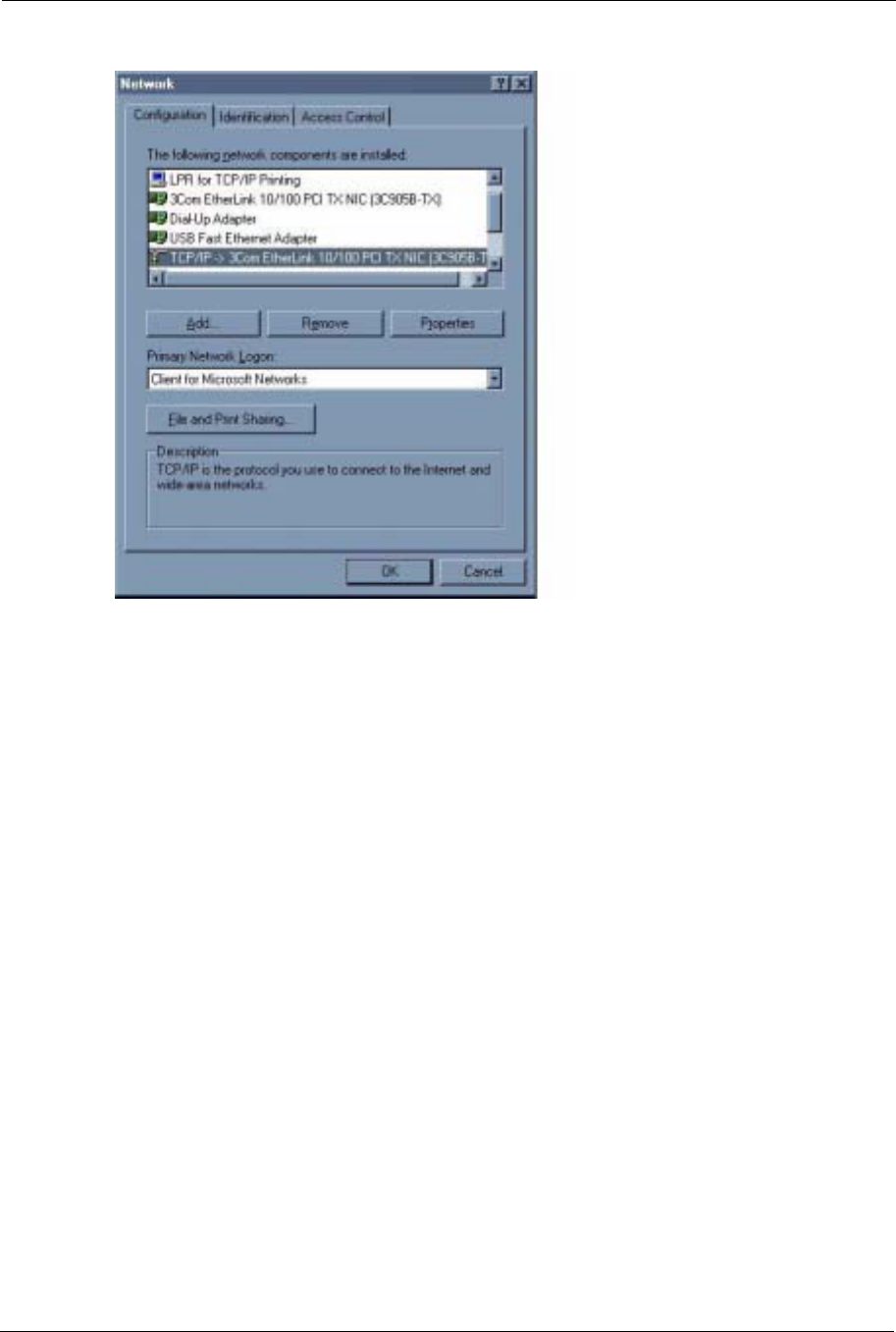
ZyXEL G-570S User’s Guide
122 Appendix B Setting up Your Computer’s IP Address
Figure 80 WIndows 95/98/Me: Network: Configuration
Installing Components
The Network window Configuration tab displays a list of installed components. You need a
network adapter, the TCP/IP protocol and Client for Microsoft Networks.
If you need the adapter:
1In the Network window, click Add.
2Select Adapter and then click Add.
3Select the manufacturer and model of your network adapter and then click OK.
If you need TCP/IP:
1In the Network window, click Add.
2Select Protocol and then click Add.
3Select Microsoft from the list of manufacturers.
4Select TCP/IP from the list of network protocols and then click OK.
If you need Client for Microsoft Networks:
1Click Add.
2Select Client and then click Add.
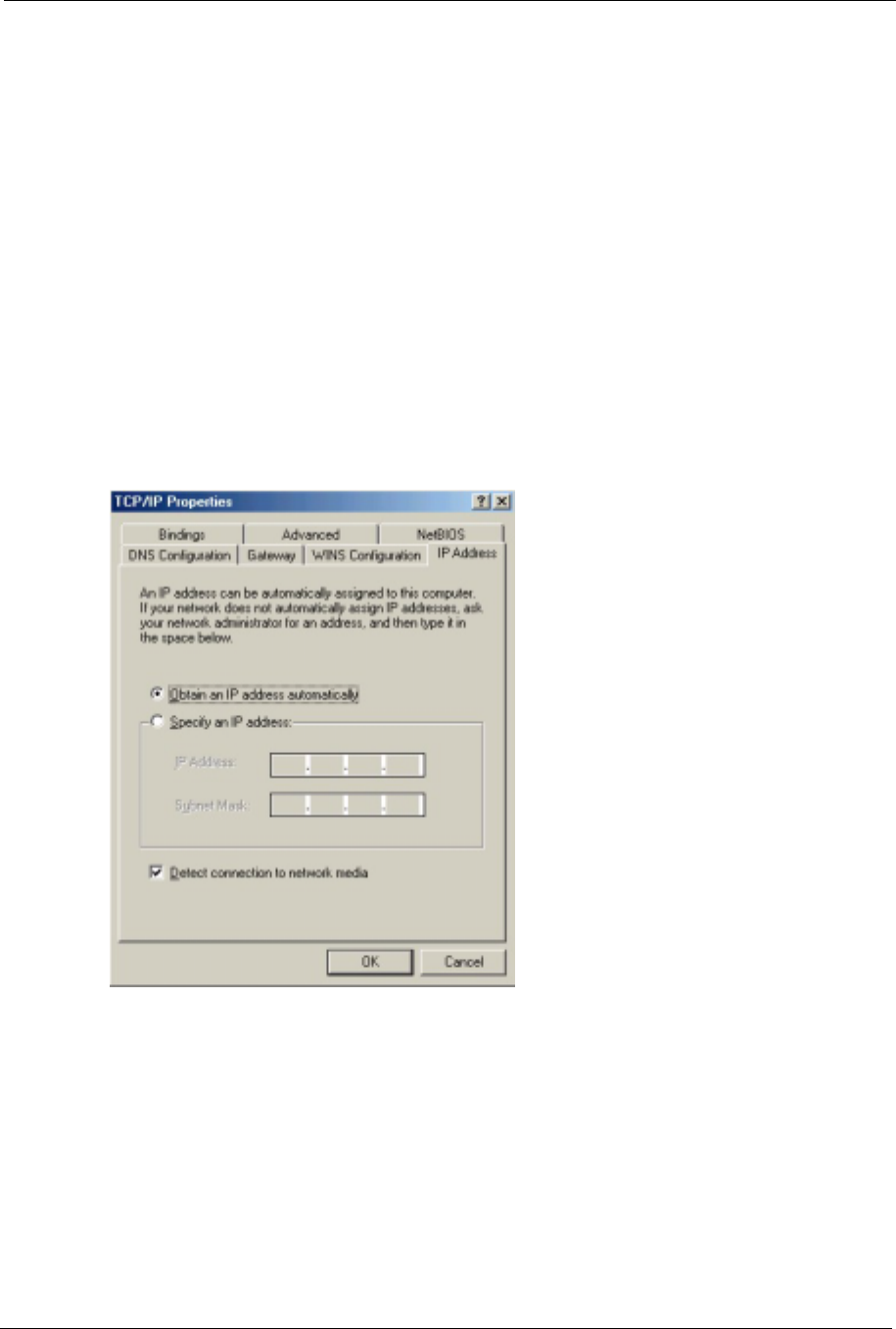
ZyXEL G-570S User’s Guide
Appendix B Setting up Your Computer’s IP Address 123
3Select Microsoft from the list of manufacturers.
4Select Client for Microsoft Networks from the list of network clients and then click
OK.
5Restart your computer so the changes you made take effect.
Configuring
1In the Network window Configuration tab, select your network adapter's TCP/IP entry
and click Properties
2Click the IP Address tab.
• If your IP address is dynamic, select Obtain an IP address
automatically.
• If you have a static IP address, select Specify an IP address and type
your information into the IP Address and Subnet Mask fields.
Figure 81 Windows 95/98/Me: TCP/IP Properties: IP Address
3Click the DNS Configuration tab.
• If you do not know your DNS information, select Disable DNS.
• If you know your DNS information, select Enable DNS and type the
information in the fields below (you may not need to fill them all in).
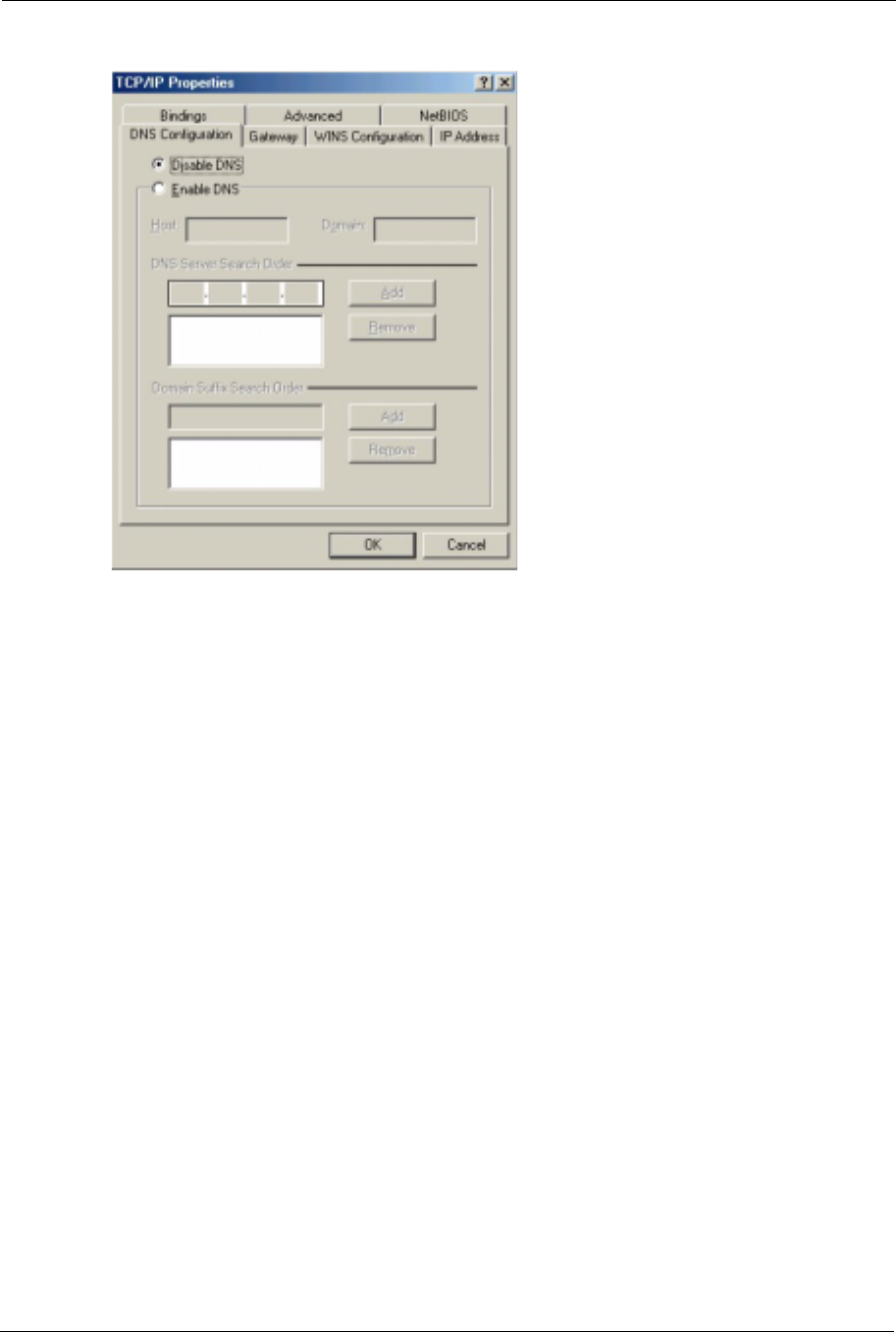
ZyXEL G-570S User’s Guide
124 Appendix B Setting up Your Computer’s IP Address
Figure 82 Windows 95/98/Me: TCP/IP Properties: DNS Configuration
4Click the Gateway tab.
• If you do not know your gateway’s IP address, remove previously
installed gateways.
• If you have a gateway IP address, type it in the New gateway field
and click Add.
5Click OK to save and close the TCP/IP Properties window.
6Click OK to close the Network window. Insert the Windows CD if prompted.
7Turn on your G-570S and restart your computer when prompted.
Verifying Settings
1Click Start and then Run.
2In the Run window, type "winipcfg" and then click OK to open the IP Configuration
window.
3Select your network adapter. You should see your computer's IP address, subnet mask
and default gateway.
Windows 2000/NT/XP
The following example figures use the default Windows XP GUI theme.
1Click start (Start in Windows 2000/NT), Settings,Control Panel.
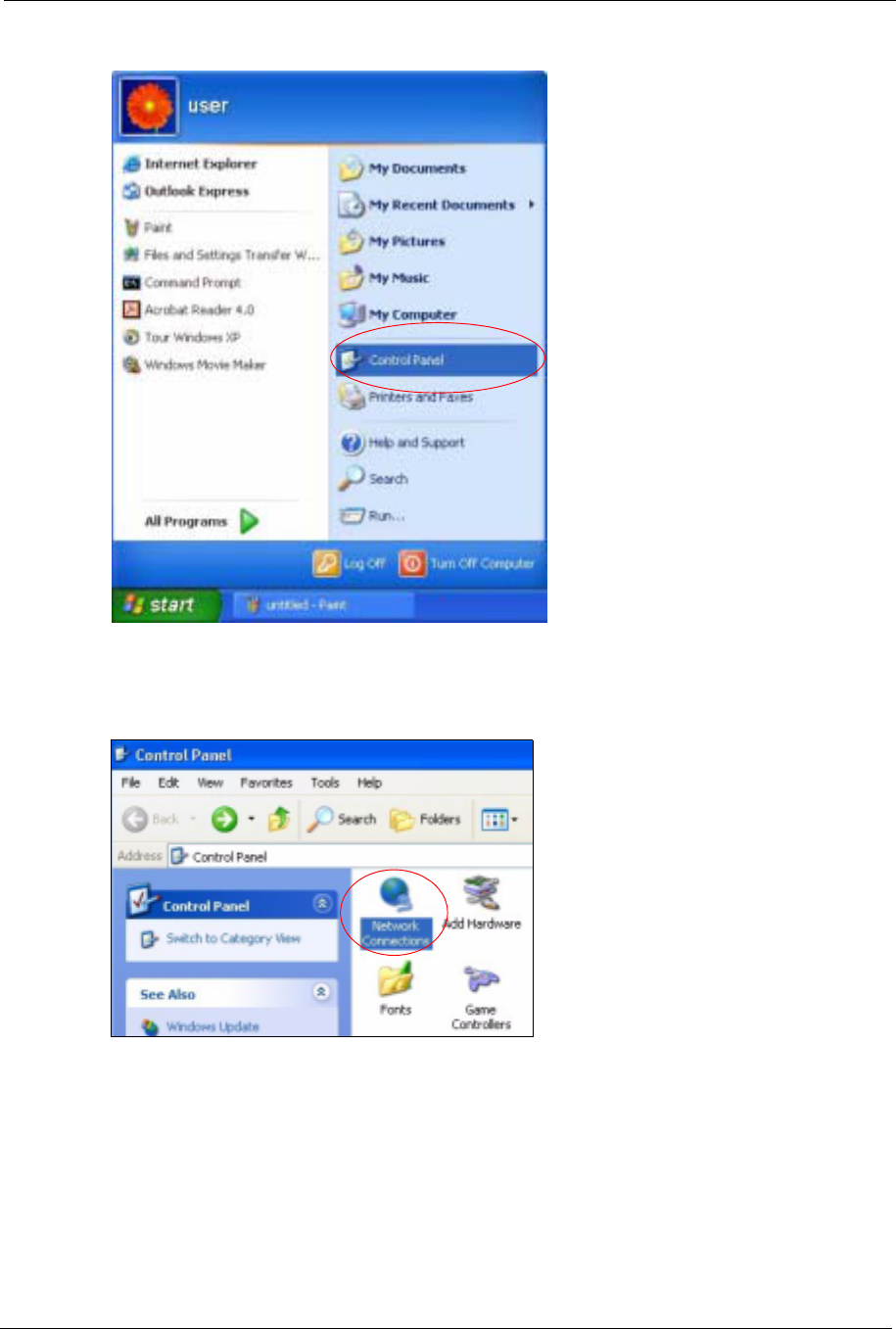
ZyXEL G-570S User’s Guide
Appendix B Setting up Your Computer’s IP Address 125
Figure 83 Windows XP: Start Menu
2In the Control Panel, double-click Network Connections (Network and Dial-up
Connections in Windows 2000/NT).
Figure 84 Windows XP: Control Panel
3Right-click Local Area Connection and then click Properties.
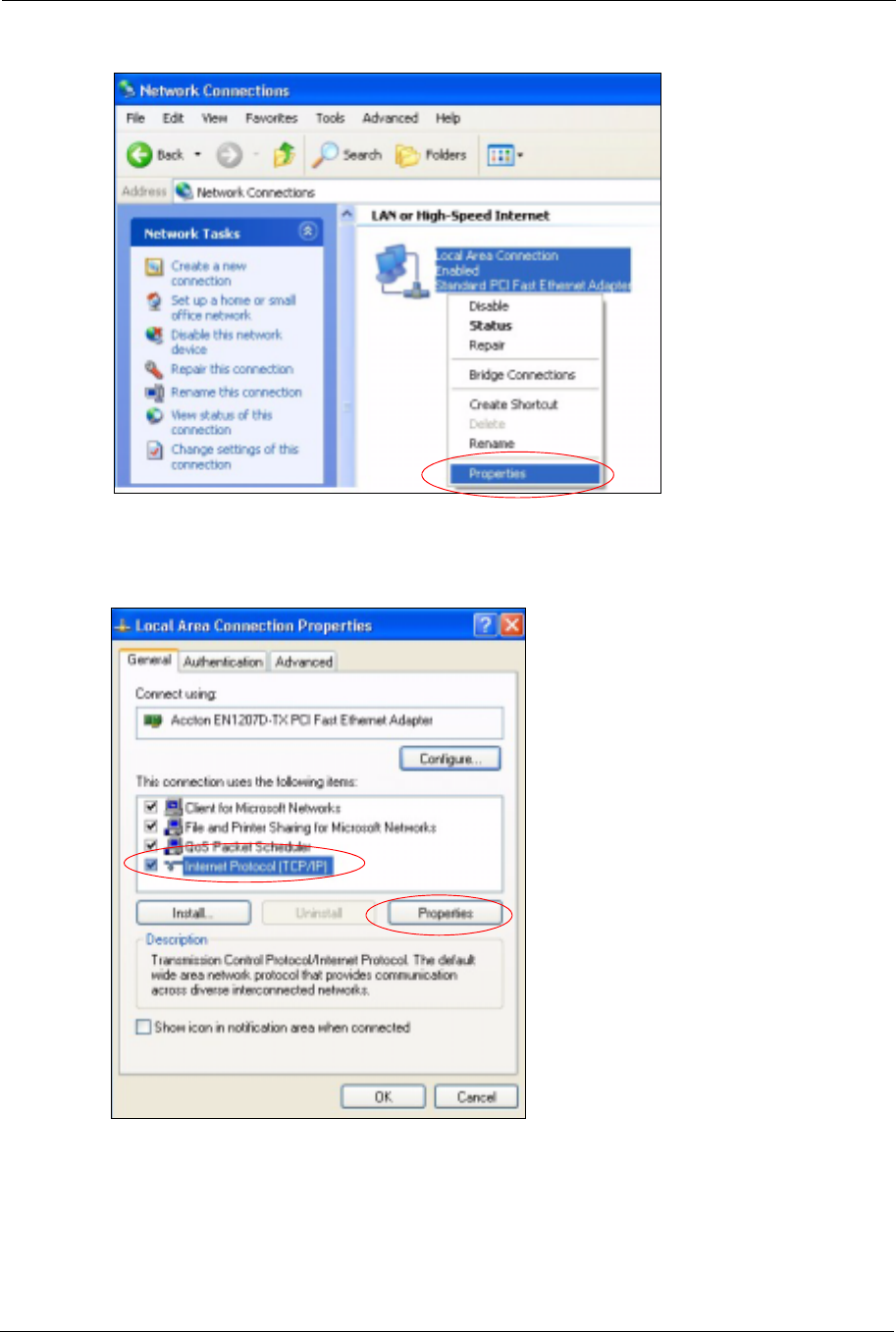
ZyXEL G-570S User’s Guide
126 Appendix B Setting up Your Computer’s IP Address
Figure 85 Windows XP: Control Panel: Network Connections: Properties
4Select Internet Protocol (TCP/IP) (under the General tab in Win XP) and then click
Properties.
Figure 86 Windows XP: Local Area Connection Properties
5The Internet Protocol TCP/IP Properties window opens (the General tab in Windows
XP).
• If you have a dynamic IP address click Obtain an IP address
automatically.
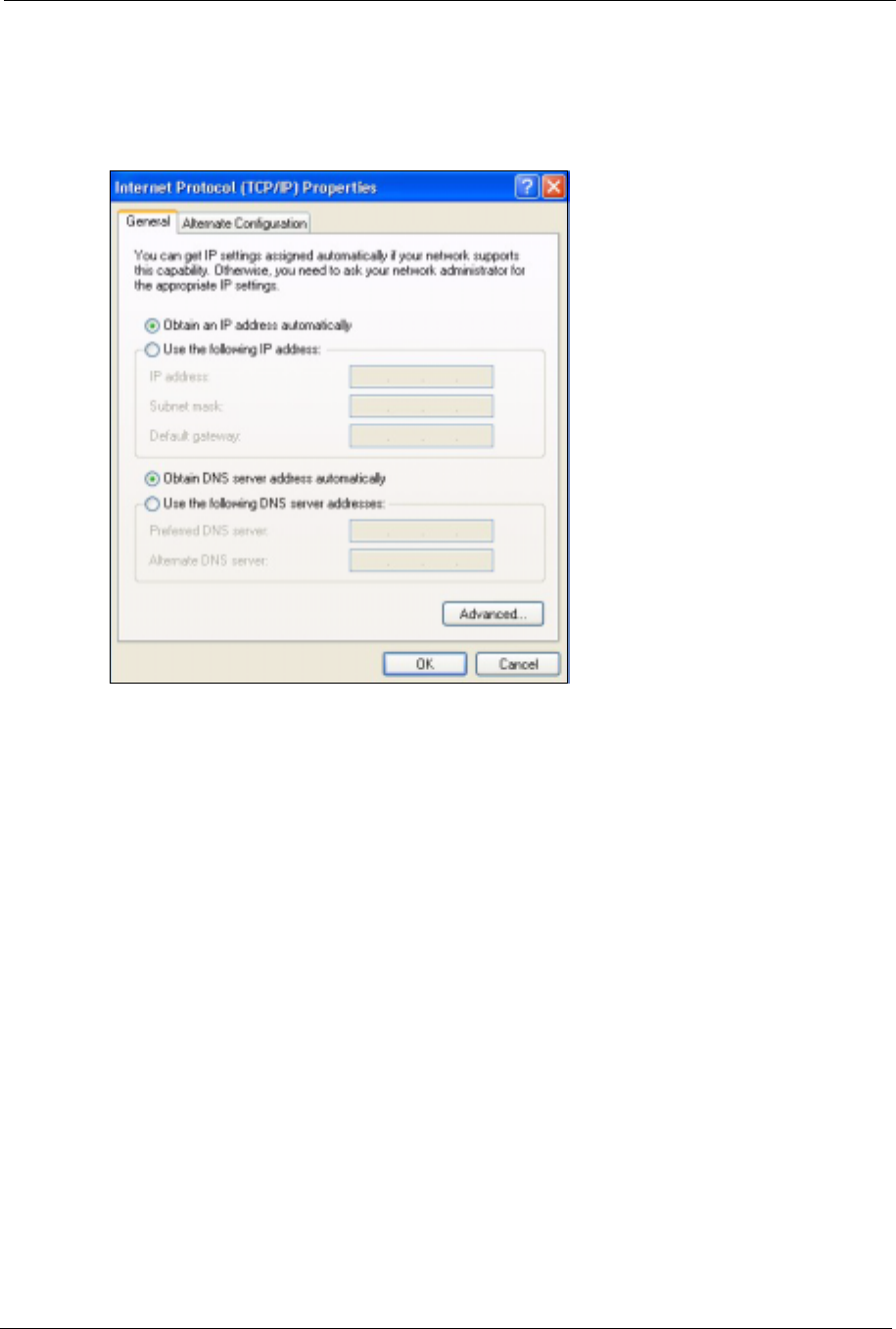
ZyXEL G-570S User’s Guide
Appendix B Setting up Your Computer’s IP Address 127
• If you have a static IP address click Use the following IP Address
and fill in the IP address,Subnet mask, and Default gateway fields.
• Click Advanced.
Figure 87 Windows XP: Internet Protocol (TCP/IP) Properties
6 If you do not know your gateway's IP address, remove any previously installed gateways
in the IP Settings tab and click OK.
Do one or more of the following if you want to configure additional IP addresses:
•In the IP Settings tab, in IP addresses, click Add.
•In TCP/IP Address, type an IP address in IP address and a subnet
mask in Subnet mask, and then click Add.
• Repeat the above two steps for each IP address you want to add.
• Configure additional default gateways in the IP Settings tab by
clicking Add in Default gateways.
•In TCP/IP Gateway Address, type the IP address of the default
gateway in Gateway. To manually configure a default metric (the
number of transmission hops), clear the Automatic metric check box
and type a metric in Metric.
• Click Add.
• Repeat the previous three steps for each default gateway you want to
add.
• Click OK when finished.
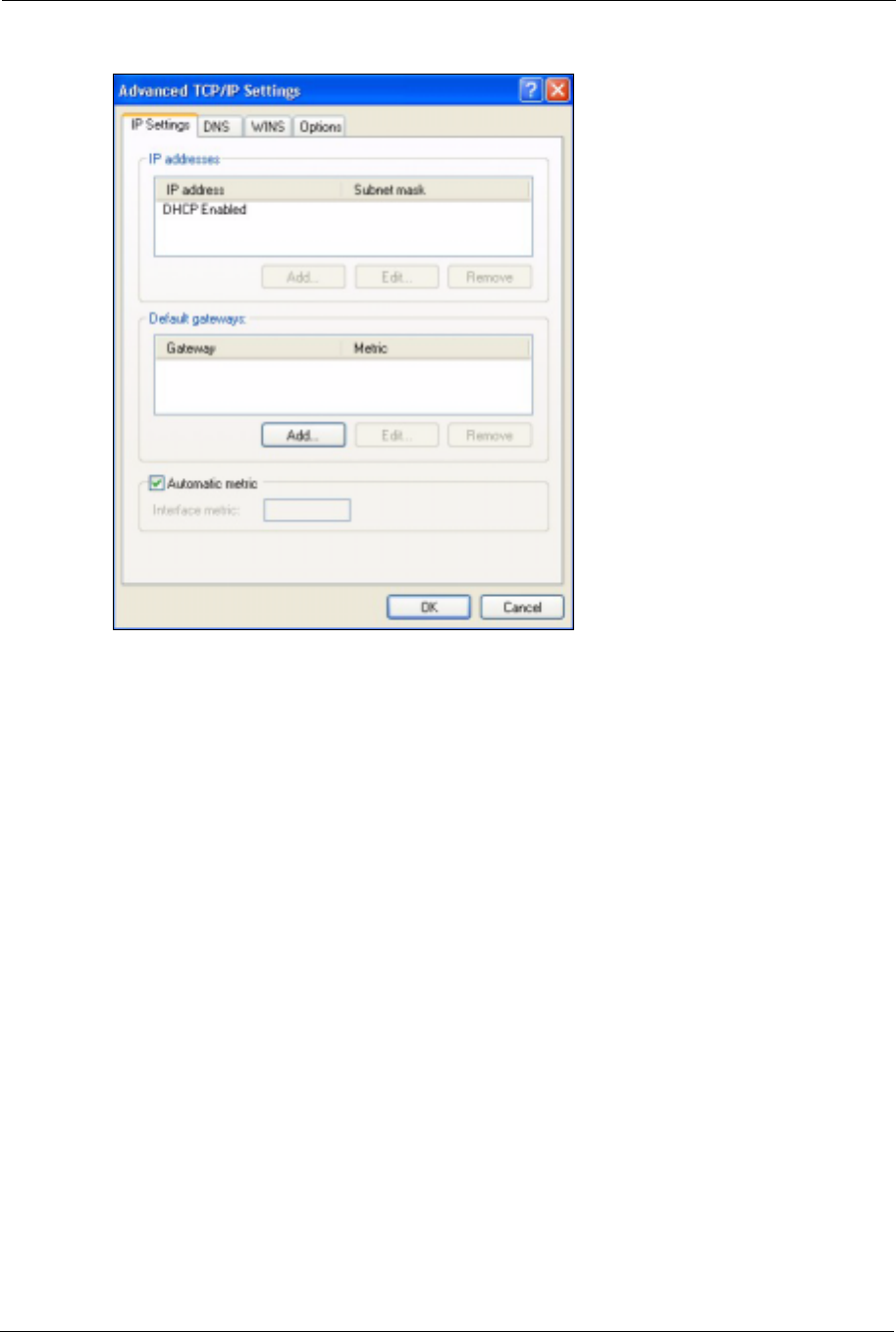
ZyXEL G-570S User’s Guide
128 Appendix B Setting up Your Computer’s IP Address
Figure 88 Windows XP: Advanced TCP/IP Properties
7In the Internet Protocol TCP/IP Properties window (the General tab in Windows XP):
• Click Obtain DNS server address automatically if you do not know
your DNS server IP address(es).
• If you know your DNS server IP address(es), click Use the following
DNS server addresses, and type them in the Preferred DNS server
and Alternate DNS server fields.
If you have previously configured DNS servers, click Advanced and
then the DNS tab to order them.
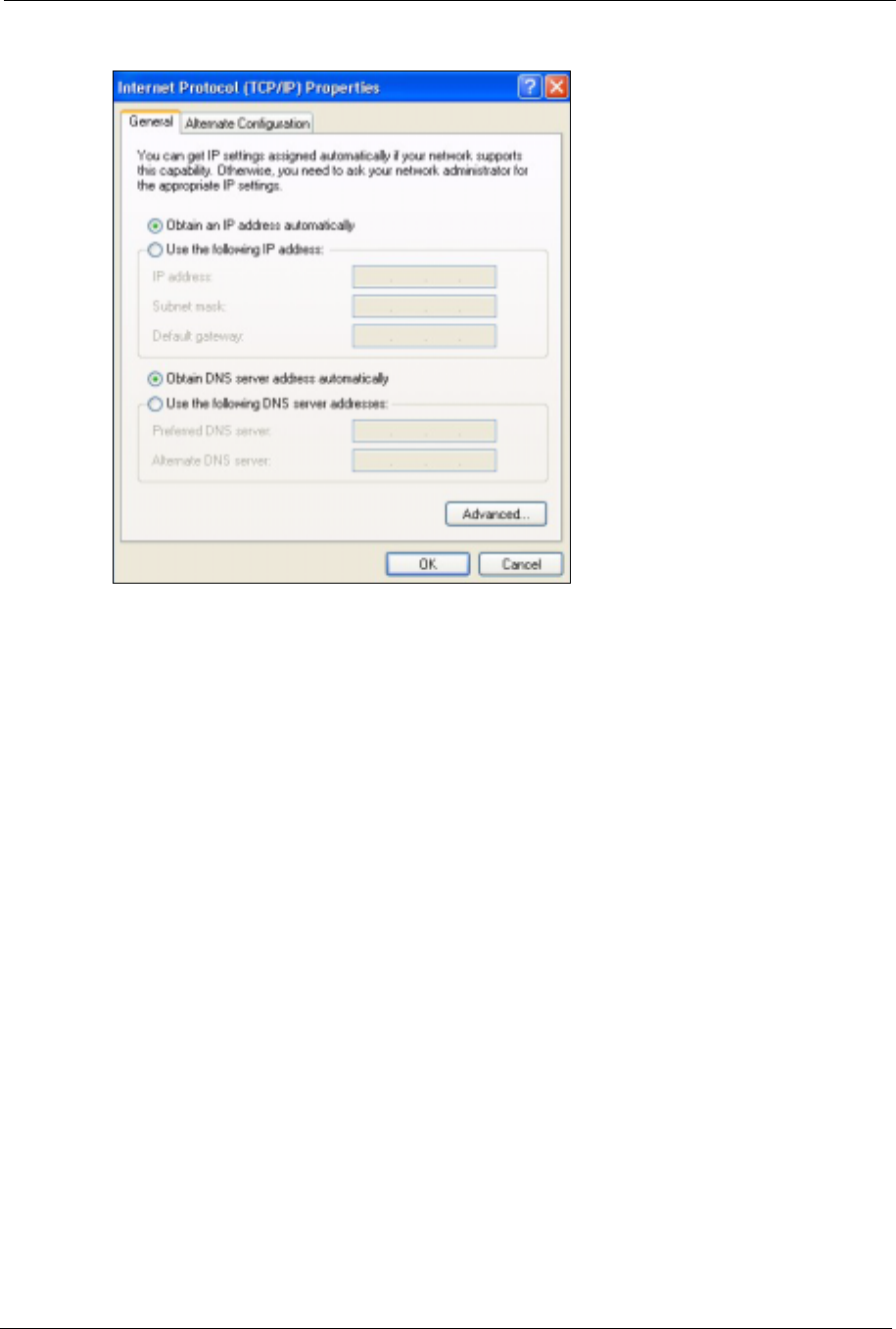
ZyXEL G-570S User’s Guide
Appendix B Setting up Your Computer’s IP Address 129
Figure 89 Windows XP: Internet Protocol (TCP/IP) Properties
8Click OK to close the Internet Protocol (TCP/IP) Properties window.
9Click Close (OK in Windows 2000/NT) to close the Local Area Connection Properties
window.
10 Close the Network Connections window (Network and Dial-up Connections in
Windows 2000/NT).
11Turn on your G-570S and restart your computer (if prompted).
Verifying Settings
1Click Start,All Programs,Accessories and then Command Prompt.
2In the Command Prompt window, type "ipconfig" and then press [ENTER]. You can
also open Network Connections, right-click a network connection, click Status and then
click the Support tab.
Macintosh OS 8/9
1Click the Apple menu, Control Panel and double-click TCP/IP to open the TCP/IP
Control Panel.
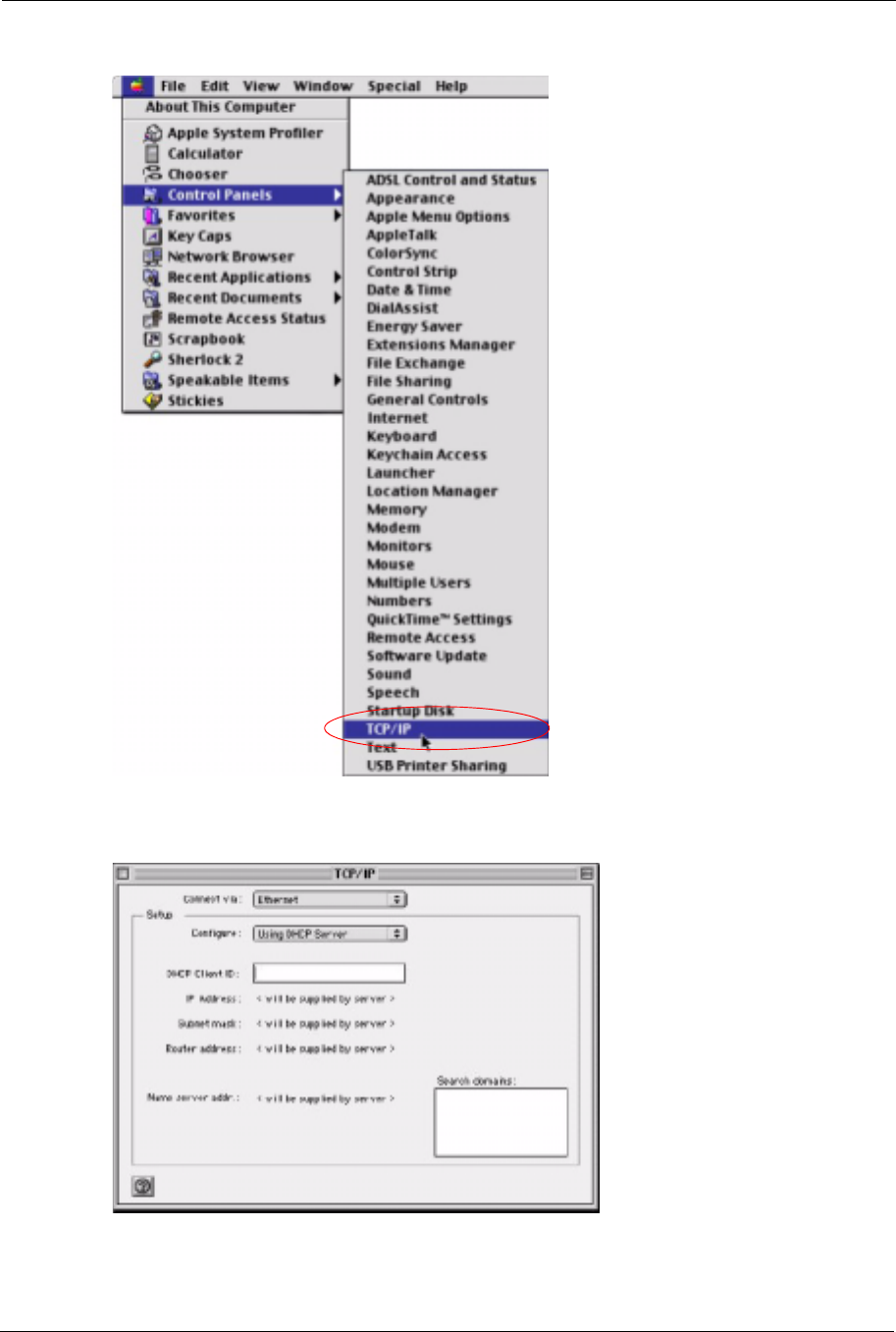
ZyXEL G-570S User’s Guide
130 Appendix B Setting up Your Computer’s IP Address
Figure 90 Macintosh OS 8/9: Apple Menu
2Select Ethernet built-in from the Connect via list.
Figure 91 Macintosh OS 8/9: TCP/IP
3For dynamically assigned settings, select Using DHCP Server from the Configure: list.
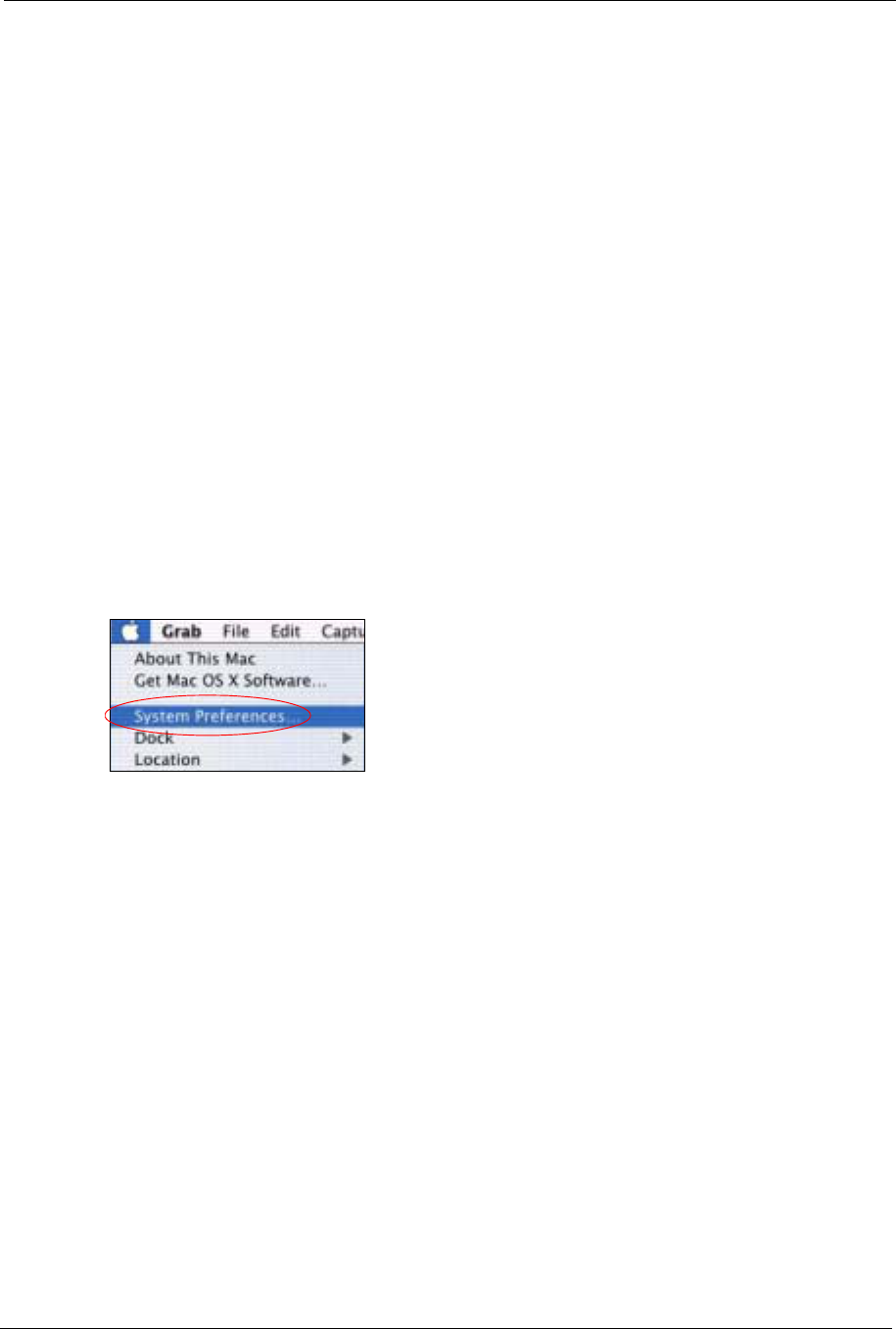
ZyXEL G-570S User’s Guide
Appendix B Setting up Your Computer’s IP Address 131
4For statically assigned settings, do the following:
•From the Configure box, select Manually.
• Type your IP address in the IP Address box.
• Type your subnet mask in the Subnet mask box.
• Type the IP address of your G-570S in the Router address box.
5Close the TCP/IP Control Panel.
6Click Save if prompted, to save changes to your configuration.
7Turn on your G-570S and restart your computer (if prompted).
Verifying Settings
Check your TCP/IP properties in the TCP/IP Control Panel window.
Macintosh OS X
1Click the Apple menu, and click System Preferences to open the System Preferences
window.
Figure 92 Macintosh OS X: Apple Menu
2Click Network in the icon bar.
• Select Automatic from the Location list.
• Select Built-in Ethernet from the Show list.
• Click the TCP/IP tab.
3For dynamically assigned settings, select Using DHCP from the Configure list.
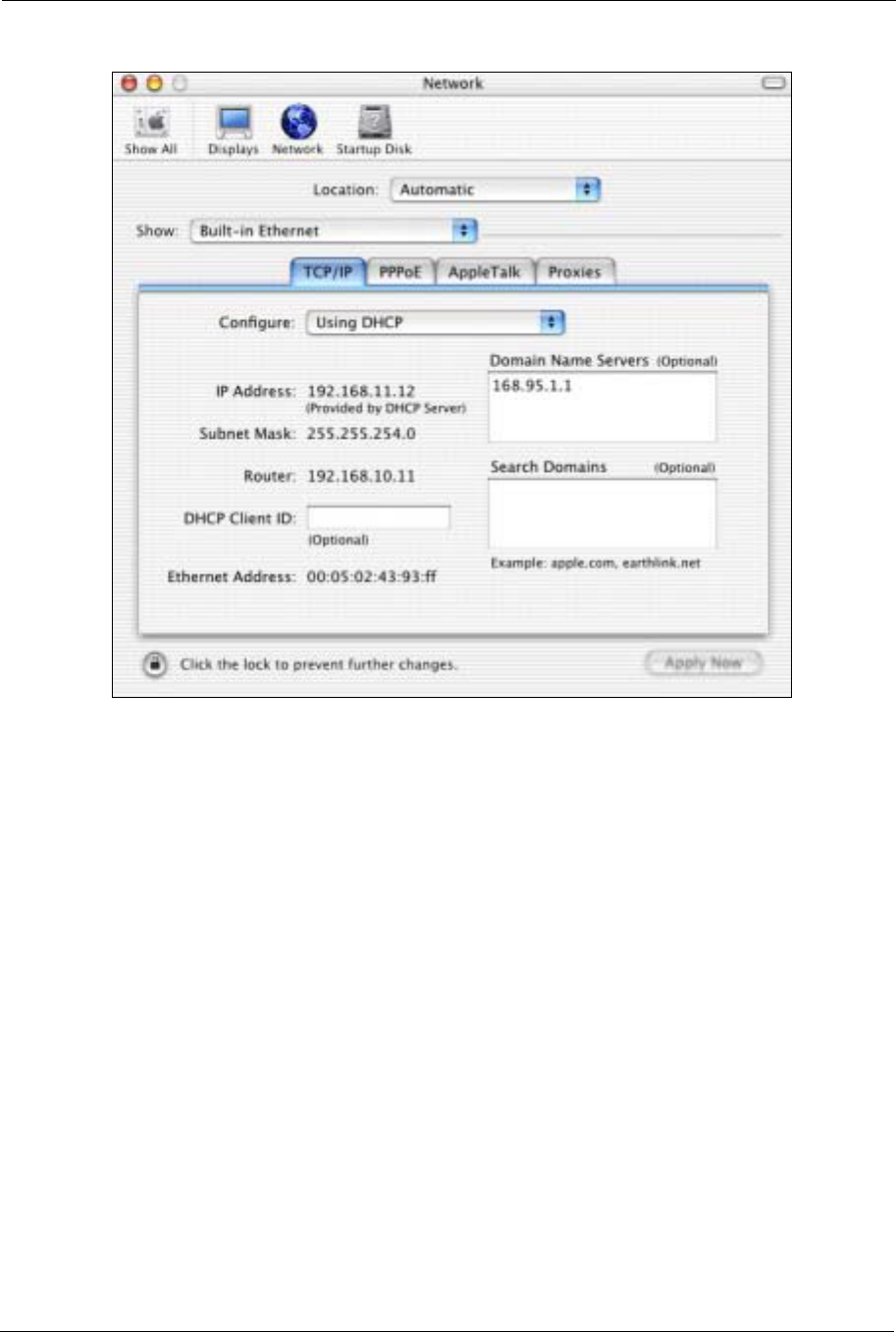
ZyXEL G-570S User’s Guide
132 Appendix B Setting up Your Computer’s IP Address
Figure 93 Macintosh OS X: Network
4For statically assigned settings, do the following:
•From the Configure box, select Manually.
• Type your IP address in the IP Address box.
• Type your subnet mask in the Subnet mask box.
• Type the IP address of your G-570S in the Router address box.
5Click Apply Now and close the window.
6Turn on your G-570S and restart your computer (if prompted).
Verifying Settings
Check your TCP/IP properties in the Network window.
Linux
This section shows you how to configure your computer’s TCP/IP settings in Red Hat Linux
9.0. Procedure, screens and file location may vary depending on your Linux distribution and
release version.
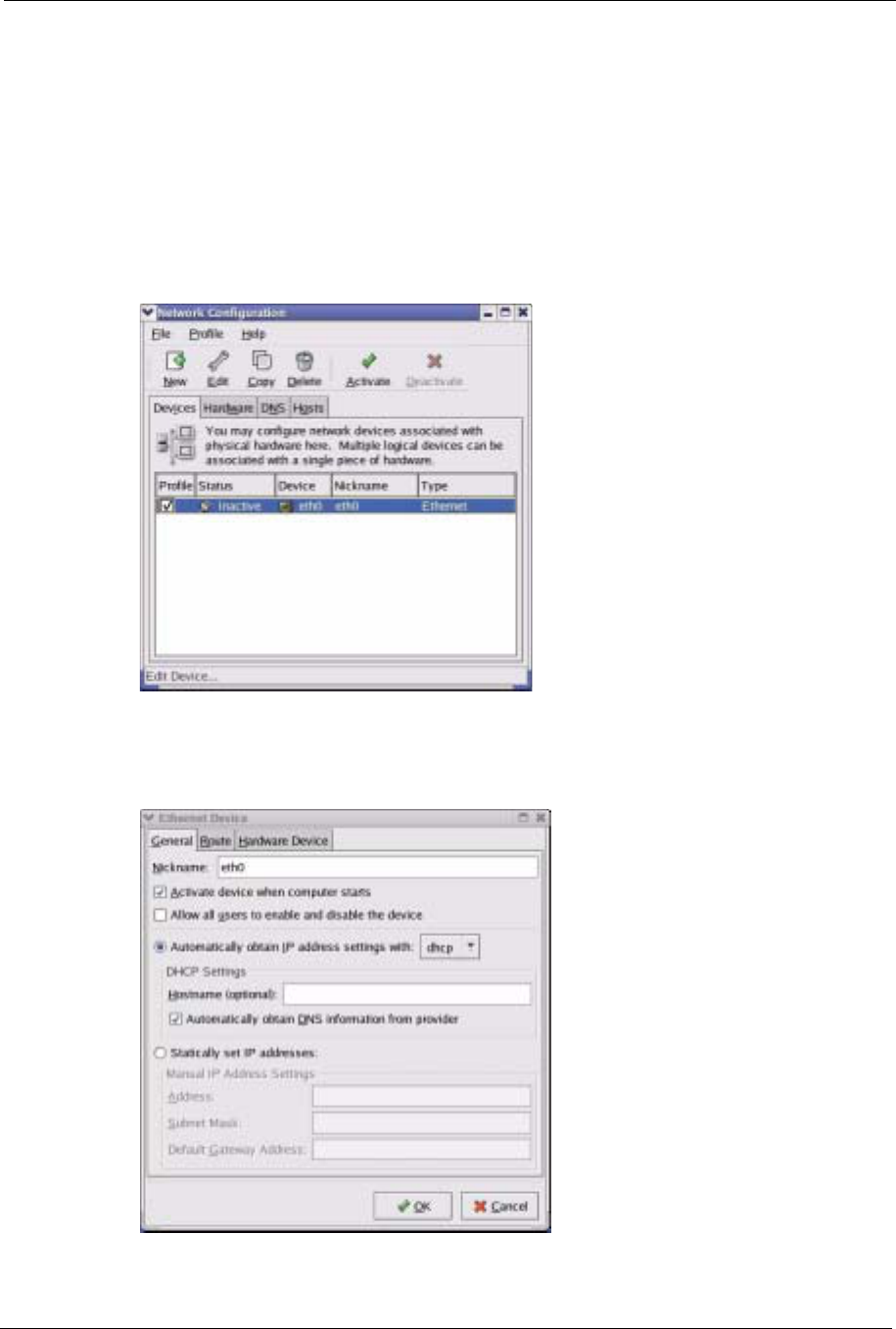
ZyXEL G-570S User’s Guide
Appendix B Setting up Your Computer’s IP Address 133
Note: Make sure you are logged in as the root administrator.
Using the K Desktop Environment (KDE)
Follow the steps below to configure your computer IP address using the KDE.
1Click the Red Hat button (located on the bottom left corner), select System Setting and
click Network.
Figure 94 Red Hat 9.0: KDE: Network Configuration: Devices
2Double-click on the profile of the network card you wish to configure. The Ethernet
Device General screen displays as shown.
Figure 95 Red Hat 9.0: KDE: Ethernet Device: General
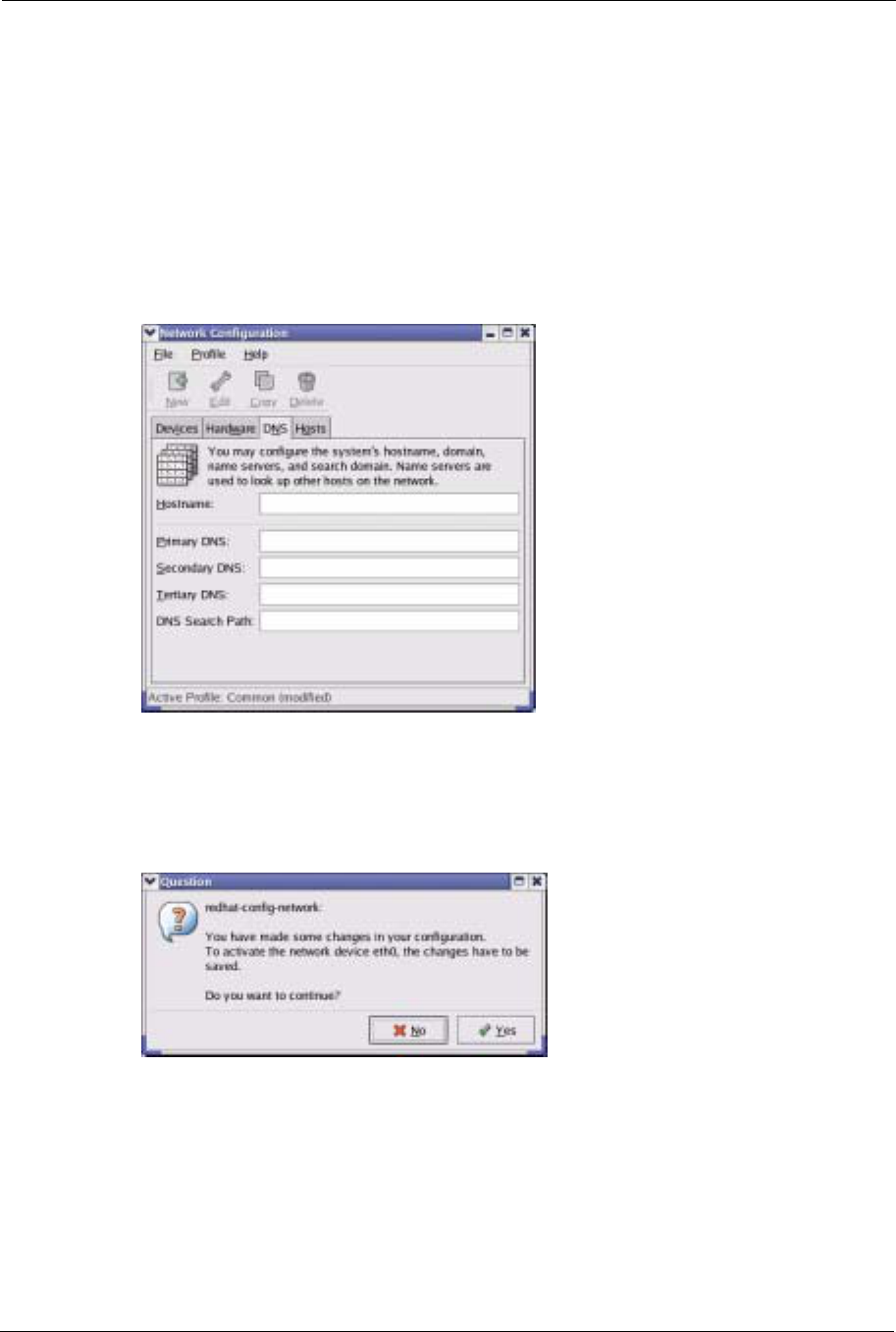
ZyXEL G-570S User’s Guide
134 Appendix B Setting up Your Computer’s IP Address
• If you have a dynamic IP address, click Automatically obtain IP
address settings with and select dhcp from the drop down list.
• If you have a static IP address, click Statically set IP Addresses and
fill in the Address,Subnet mask, and Default Gateway Address
fields.
3Click OK to save the changes and close the Ethernet Device General screen.
4If you know your DNS server IP address(es), click the DNS tab in the Network
Configuration screen. Enter the DNS server information in the fields provided.
Figure 96 Red Hat 9.0: KDE: Network Configuration: DNS
5Click the Devices tab.
6Click the Activate button to apply the changes. The following screen displays. Click Yes
to save the changes in all screens.
Figure 97 Red Hat 9.0: KDE: Network Configuration: Activate
7After the network card restart process is complete, make sure the Status is Active in the
Network Configuration screen.
Using Configuration Files
Follow the steps below to edit the network configuration files and set your computer IP
address.

ZyXEL G-570S User’s Guide
Appendix B Setting up Your Computer’s IP Address 135
1Assuming that you have only one network card on the computer, locate the ifconfig-
eth0 configuration file (where eth0 is the name of the Ethernet card). Open the
configuration file with any plain text editor.
• If you have a dynamic IP address, enter dhcp in the BOOTPROTO=
field. The following figure shows an example.
Figure 98 Red Hat 9.0: Dynamic IP Address Setting in ifconfig-eth0
• If you have a static IP address, enter static in the BOOTPROTO=
field. Type IPADDR= followed by the IP address (in dotted decimal
notation) and type NETMASK= followed by the subnet mask. The
following example shows an example where the static IP address is
192.168.1.10 and the subnet mask is 255.255.255.0.
Figure 99 Red Hat 9.0: Static IP Address Setting in ifconfig-eth0
2If you know your DNS server IP address(es), enter the DNS server information in the
resolv.conf file in the /etc directory. The following figure shows an example where
two DNS server IP addresses are specified.
Figure 100 Red Hat 9.0: DNS Settings in resolv.conf
3After you edit and save the configuration files, you must restart the network card. Enter
./network restart in the /etc/rc.d/init.d directory. The following figure
shows an example.
DEVICE=eth0
ONBOOT=yes
BOOTPROTO=dhcp
USERCTL=no
PEERDNS=yes
TYPE=Ethernet
DEVICE=eth0
ONBOOT=yes
BOOTPROTO=static
IPADDR=192.168.1.10
NETMASK=255.255.255.0
USERCTL=no
PEERDNS=yes
TYPE=Ethernet
nameserver 172.23.5.1
nameserver 172.23.5.2

ZyXEL G-570S User’s Guide
136 Appendix B Setting up Your Computer’s IP Address
Figure 101 Red Hat 9.0: Restart Ethernet Card
Verifying Settings
Enter ifconfig in a terminal screen to check your TCP/IP properties.
Figure 102 Red Hat 9.0: Checking TCP/IP Properties
[root@localhost init.d]# network restart
Shutting down interface eth0: [OK]
Shutting down loopback interface: [OK]
Setting network parameters: [OK]
Bringing up loopback interface: [OK]
Bringing up interface eth0: [OK]
[root@localhost]# ifconfig
eth0 Link encap:Ethernet HWaddr 00:50:BA:72:5B:44
inet addr:172.23.19.129 Bcast:172.23.19.255 Mask:255.255.255.0
UP BROADCAST RUNNING MULTICAST MTU:1500 Metric:1
RX packets:717 errors:0 dropped:0 overruns:0 frame:0
TX packets:13 errors:0 dropped:0 overruns:0 carrier:0
collisions:0 txqueuelen:100
RX bytes:730412 (713.2 Kb) TX bytes:1570 (1.5 Kb)
Interrupt:10 Base address:0x1000
[root@localhost]#

ZyXEL G-570S User’s Guide
Appendix C Wireless LANs 137
APPENDIX C
Wireless LANs
Wireless LAN Topologies
This section discusses ad-hoc and infrastructure wireless LAN topologies.
Ad-hoc Wireless LAN Configuration
The simplest WLAN configuration is an independent (Ad-hoc) WLAN that connects a set of
computers with wireless stations (A, B, C). Any time two or more wireless adapters are within
range of each other, they can set up an independent network, which is commonly referred to as
an Ad-hoc network or Independent Basic Service Set (IBSS). The following diagram shows an
example of notebook computers using wireless adapters to form an Ad-hoc wireless LAN.
Figure 103 Peer-to-Peer Communication in an Ad-hoc Network
BSS
A Basic Service Set (BSS) exists when all communications between wireless stations or
between a wireless station and a wired network client go through one access point (AP).
Intra-BSS traffic is traffic between wireless stations in the BSS. When Intra-BSS is enabled,
wireless station A and B can access the wired network and communicate with each other.
When Intra-BSS is disabled, wireless station A and B can still access the wired network but
cannot communicate with each other.
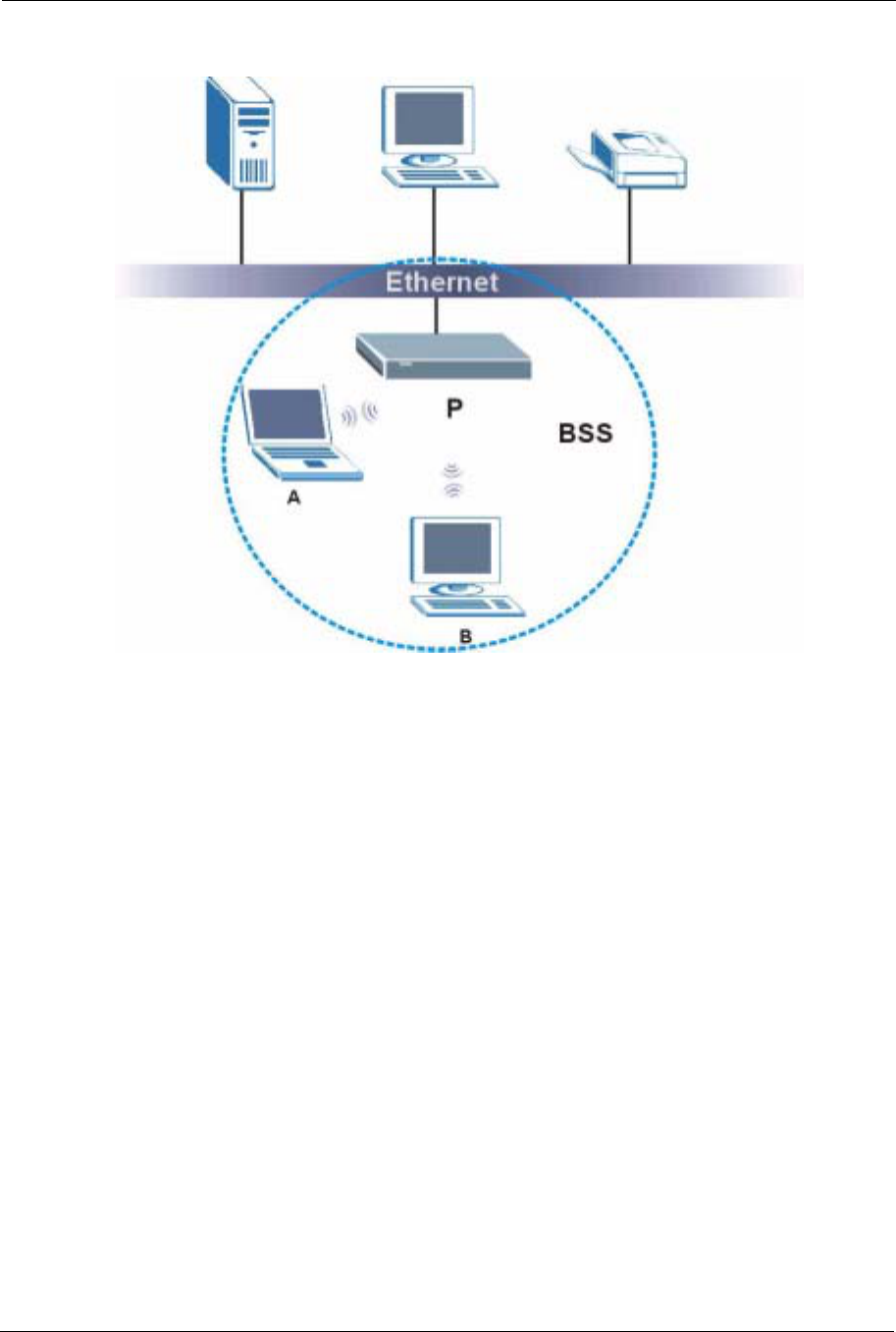
ZyXEL G-570S User’s Guide
138 Appendix C Wireless LANs
Figure 104 Basic Service Set
ESS
An Extended Service Set (ESS) consists of a series of overlapping BSSs, each containing an
access point, with each access point connected together by a wired network. This wired
connection between APs is called a Distribution System (DS).
This type of wireless LAN topology is called an Infrastructure WLAN. The Access Points not
only provide communication with the wired network but also mediate wireless network traffic
in the immediate neighborhood.
An ESSID (ESS IDentification) uniquely identifies each ESS. All access points and their
associated wireless stations within the same ESS must have the same ESSID in order to
communicate.
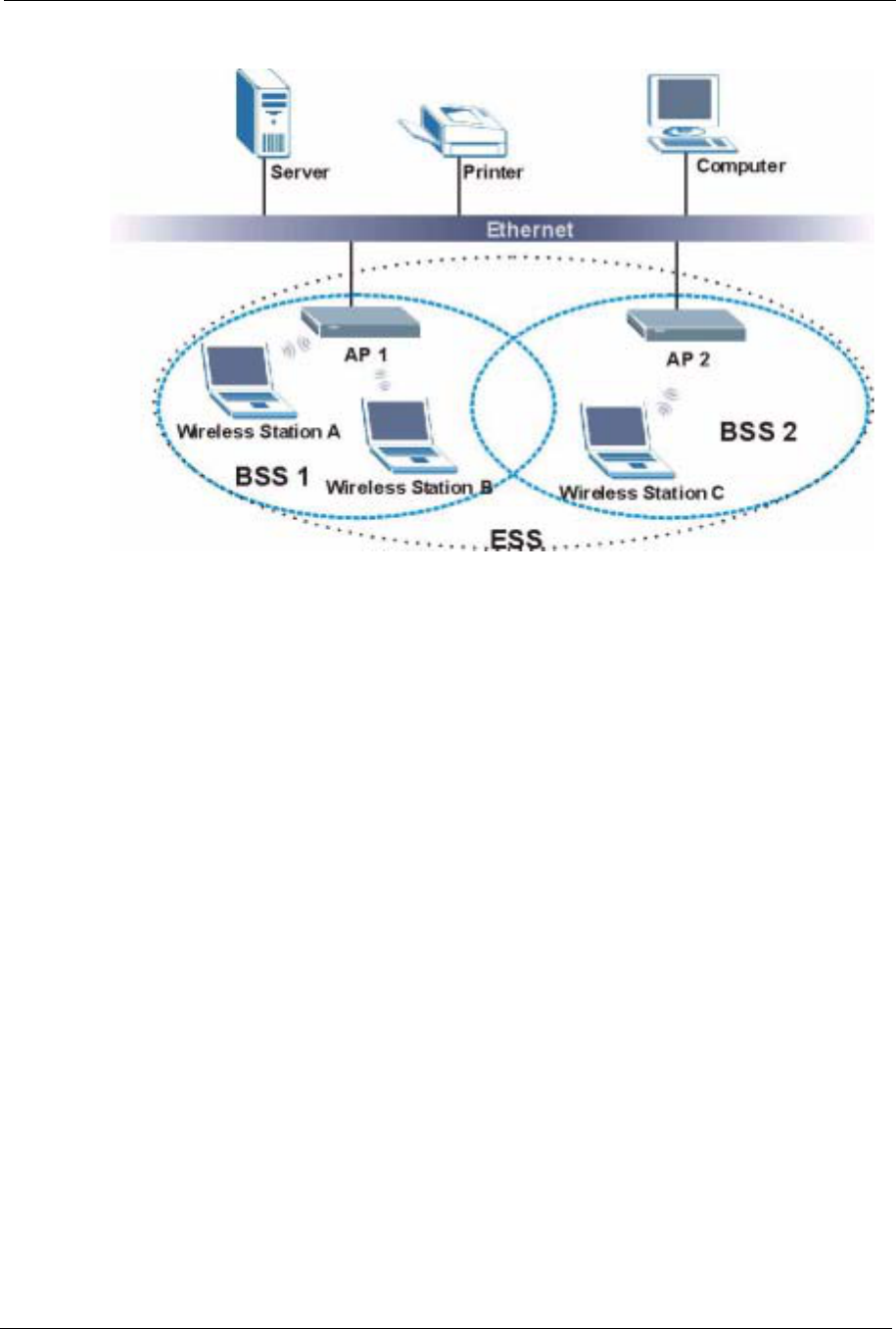
ZyXEL G-570S User’s Guide
Appendix C Wireless LANs 139
Figure 105 Infrastructure WLAN
Channel
A channel is the radio frequency(ies) used by IEEE 802.11a/b/g wireless devices. Channels
available depend on your geographical area. You may have a choice of channels (for your
region) so you should use a different channel than an adjacent AP (access point) to reduce
interference. Interference occurs when radio signals from different access points overlap
causing interference and degrading performance.
Adjacent channels partially overlap however. To avoid interference due to overlap, your AP
should be on a channel at least five channels away from a channel that an adjacent AP is using.
For example, if your region has 11 channels and an adjacent AP is using channel 1, then you
need to select a channel between 6 or 11.
RTS/CTS
A hidden node occurs when two stations are within range of the same access point, but are not
within range of each other. The following figure illustrates a hidden node. Both stations (STA)
are within range of the access point (AP) or wireless gateway, but out-of-range of each other,
so they cannot "hear" each other, that is they do not know if the channel is currently being
used. Therefore, they are considered hidden from each other.
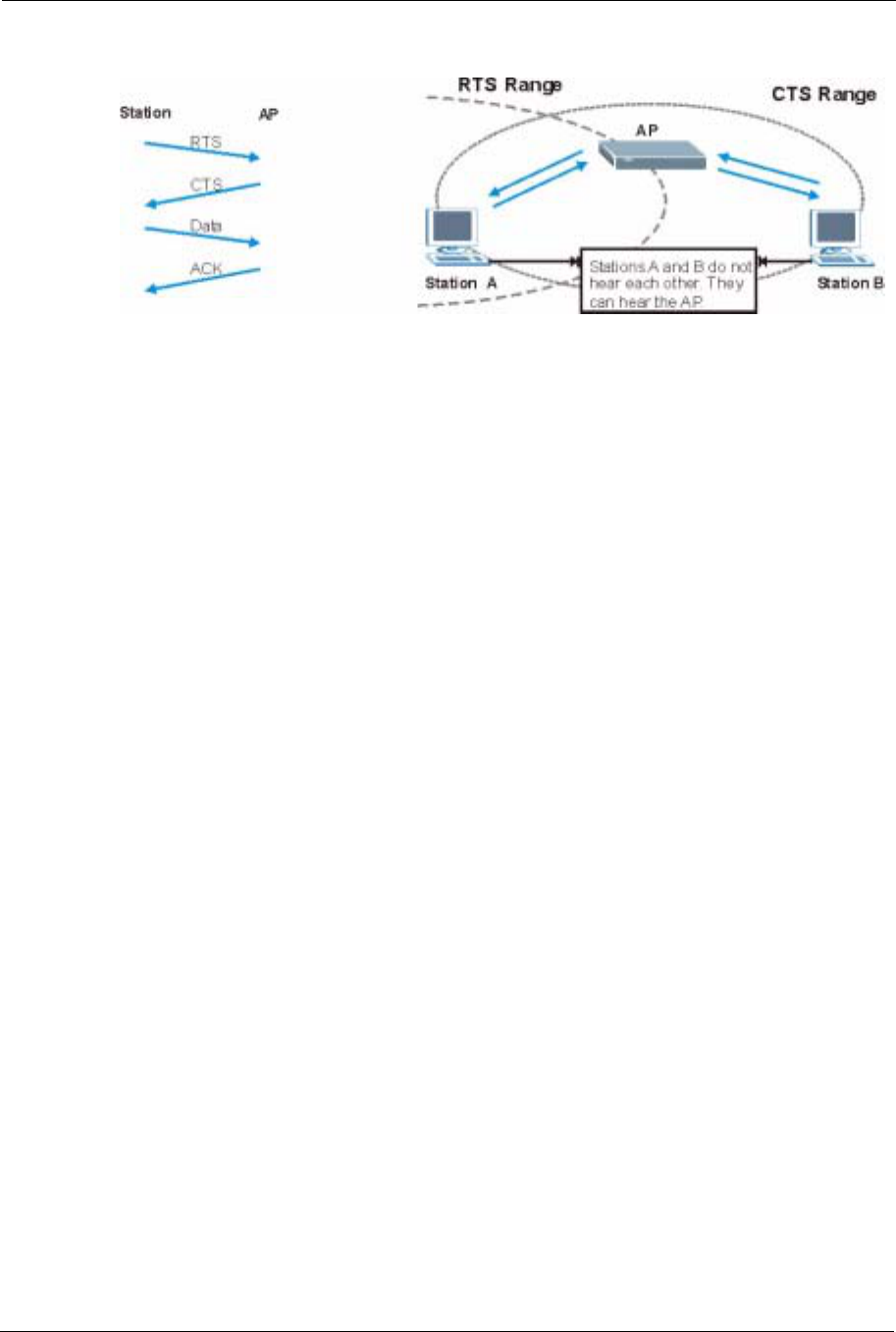
ZyXEL G-570S User’s Guide
140 Appendix C Wireless LANs
Figure 106 RTS/CTS
When station A sends data to the AP, it might not know that the station B is already using the
channel. If these two stations send data at the same time, collisions may occur when both sets
of data arrive at the AP at the same time, resulting in a loss of messages for both stations.
RTS/CTS is designed to prevent collisions due to hidden nodes. An RTS/CTS defines the
biggest size data frame you can send before an RTS (Request To Send)/CTS (Clear to Send)
handshake is invoked.
When a data frame exceeds the RTS/CTS value you set (between 0 to 2432 bytes), the station
that wants to transmit this frame must first send an RTS (Request To Send) message to the AP
for permission to send it. The AP then responds with a CTS (Clear to Send) message to all
other stations within its range to notify them to defer their transmission. It also reserves and
confirms with the requesting station the time frame for the requested transmission.
Stations can send frames smaller than the specified RTS/CTS directly to the AP without the
RTS (Request To Send)/CTS (Clear to Send) handshake.
You should only configure RTS/CTS if the possibility of hidden nodes exists on your network
and the "cost" of resending large frames is more than the extra network overhead involved in
the RTS (Request To Send)/CTS (Clear to Send) handshake.
If the RTS/CTS value is greater than the Fragmentation Threshold value (see next), then the
RTS (Request To Send)/CTS (Clear to Send) handshake will never occur as data frames will
be fragmented before they reach RTS/CTS size.
Note: Enabling the RTS Threshold causes redundant network overhead that could
negatively affect the throughput performance instead of providing a remedy.
Fragmentation Threshold
AFragmentation Threshold is the maximum data fragment size (between 256 and 2432
bytes) that can be sent in the wireless network before the AP will fragment the packet into
smaller data frames.

ZyXEL G-570S User’s Guide
Appendix C Wireless LANs 141
A large Fragmentation Threshold is recommended for networks not prone to interference
while you should set a smaller threshold for busy networks or networks that are prone to
interference.
If the Fragmentation Threshold value is smaller than the RTS/CTS value (see previously)
you set then the RTS (Request To Send)/CTS (Clear to Send) handshake will never occur as
data frames will be fragmented before they reach RTS/CTS size.
IEEE 802.11g Wireless LAN
IEEE 802.11g is fully compatible with the IEEE 802.11b standard. This means an IEEE
802.11b adapter can interface directly with an IEEE 802.11g access point (and vice versa) at
11 Mbps or lower depending on range. IEEE 802.11g has several intermediate rate steps
between the maximum and minimum data rates. The IEEE 802.11g data rate and modulation
are as follows:
IEEE 802.1x
In June 2001, the IEEE 802.1x standard was designed to extend the features of IEEE 802.11 to
support extended authentication as well as providing additional accounting and control
features. It is supported by Windows XP and a number of network devices. Some advantages
of IEEE 802.1x are:
• User based identification that allows for roaming.
• Support for RADIUS (Remote Authentication Dial In User Service, RFC 2138, 2139) for
centralized user profile and accounting management on a network RADIUS server.
• Support for EAP (Extensible Authentication Protocol, RFC 2486) that allows additional
authentication methods to be deployed with no changes to the access point or the wireless
stations.
RADIUS
RADIUS is based on a client-server model that supports authentication, authorization and
accounting. The access point is the client and the server is the RADIUS server. The RADIUS
server handles the following tasks:
Table 37 IEEE 802.11g
DATA RATE (MBPS) MODULATION
1 DBPSK (Differential Binary Phase Shift Keyed)
2 DQPSK (Differential Quadrature Phase Shift Keying)
5.5 / 11 CCK (Complementary Code Keying)
6/9/12/18/24/36/48/54 OFDM (Orthogonal Frequency Division Multiplexing)

ZyXEL G-570S User’s Guide
142 Appendix C Wireless LANs
• Authentication
Determines the identity of the users.
• Authorization
Determines the network services available to authenticated users once they are connected
to the network.
• Accounting
Keeps track of the client’s network activity.
RADIUS is a simple package exchange in which your AP acts as a message relay between the
wireless station and the network RADIUS server.
Types of RADIUS Messages
The following types of RADIUS messages are exchanged between the access point and the
RADIUS server for user authentication:
• Access-Request
Sent by an access point requesting authentication.
• Access-Reject
Sent by a RADIUS server rejecting access.
• Access-Accept
Sent by a RADIUS server allowing access.
• Access-Challenge
Sent by a RADIUS server requesting more information in order to allow access. The
access point sends a proper response from the user and then sends another Access-
Request message.
The following types of RADIUS messages are exchanged between the access point and the
RADIUS server for user accounting:
• Accounting-Request
Sent by the access point requesting accounting.
• Accounting-Response
Sent by the RADIUS server to indicate that it has started or stopped accounting.
In order to ensure network security, the access point and the RADIUS server use a shared
secret key, which is a password, they both know. The key is not sent over the network. In
addition to the shared key, password information exchanged is also encrypted to protect the
network from unauthorized access.
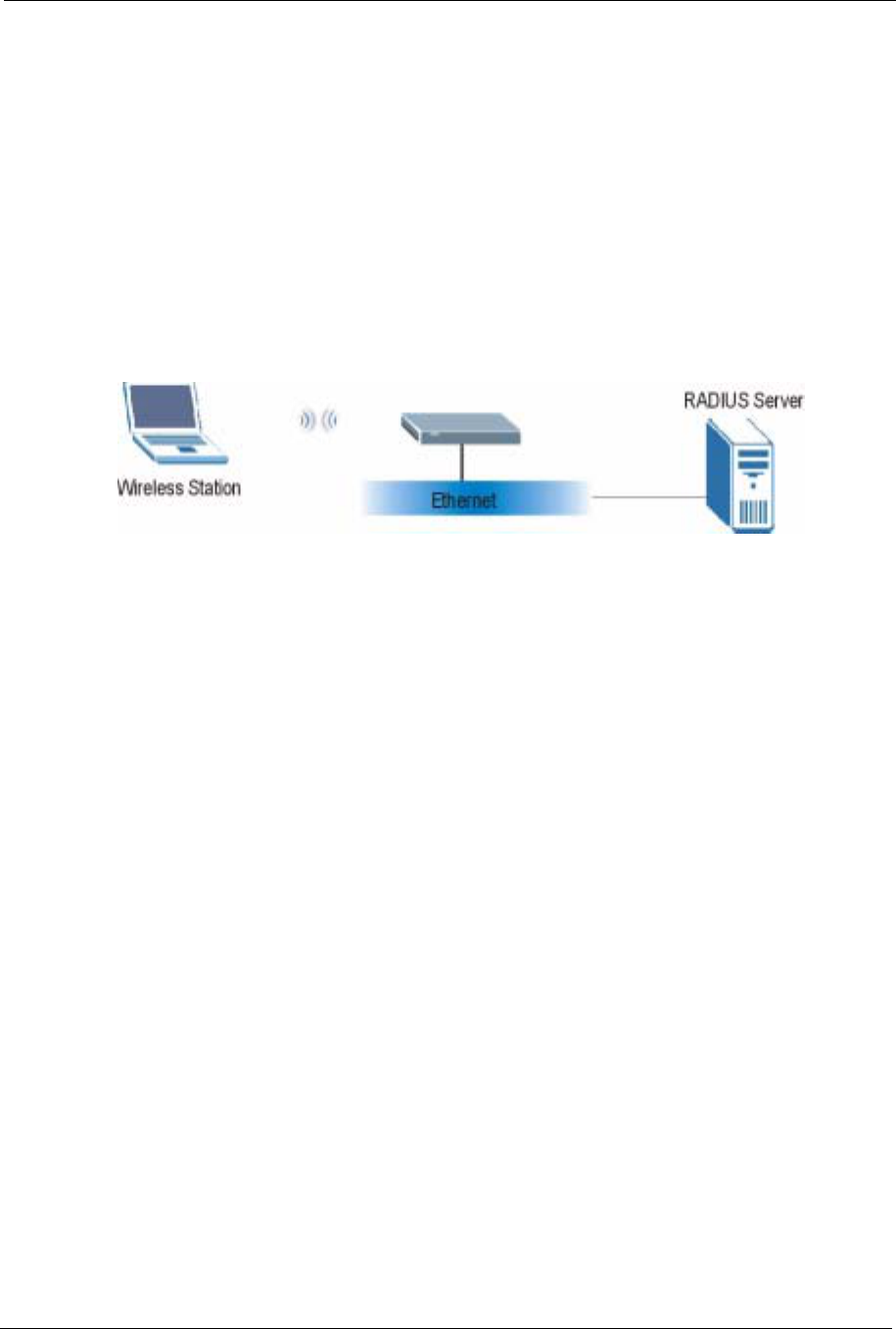
ZyXEL G-570S User’s Guide
Appendix C Wireless LANs 143
EAP Authentication
EAP (Extensible Authentication Protocol) is an authentication protocol that runs on top of the
IEEE802.1x transport mechanism in order to support multiple types of user authentication. By
using EAP to interact with an EAP-compatible RADIUS server, the access point helps a
wireless station and a RADIUS server perform authentication.
The type of authentication you use depends on the RADIUS server or the AP.
The following figure shows an overview of authentication when you specify a RADIUS server
on your access point.
Figure 107 EAP Authentication
The details below provide a general description of how IEEE 802.1x EAP authentication
works. For an example list of EAP-MD5 authentication steps, see the IEEE 802.1x appendix.
1The wireless station sends a “start” message to the device.
2The device sends a “request identity” message to the wireless station for identity
information.
3The wireless station replies with identity information, including username and password.
4The RADIUS server checks the user information against its user profile database and
determines whether or not to authenticate the wireless station.
Types of Authentication
This section discusses some popular authentication types: EAP-MD5,EAP-TLS,EAP-
TTLS,PEAP and LEAP.
The type of authentication you use depends on the RADIUS server or the AP. Consult your
network administrator for more information.
EAP-MD5 (Message-Digest Algorithm 5)
MD5 authentication is the simplest one-way authentication method. The authentication server
sends a challenge to the wireless station. The wireless station ‘proves’ that it knows the
password by encrypting the password with the challenge and sends back the information.
Password is not sent in plain text.

ZyXEL G-570S User’s Guide
144 Appendix C Wireless LANs
However, MD5 authentication has some weaknesses. Since the authentication server needs to
get the plaintext passwords, the passwords must be stored. Thus someone other than the
authentication server may access the password file. In addition, it is possible to impersonate an
authentication server as MD5 authentication method does not perform mutual authentication.
Finally, MD5 authentication method does not support data encryption with dynamic session
key. You must configure WEP encryption keys for data encryption.
EAP-TLS (Transport Layer Security)
With EAP-TLS, digital certifications are needed by both the server and the wireless stations
for mutual authentication. The server presents a certificate to the client. After validating the
identity of the server, the client sends a different certificate to the server. The exchange of
certificates is done in the open before a secured tunnel is created. This makes user identity
vulnerable to passive attacks. A digital certificate is an electronic ID card that authenticates the
sender’s identity. However, to implement EAP-TLS, you need a Certificate Authority (CA) to
handle certificates, which imposes a management overhead.
EAP-TTLS (Tunneled Transport Layer Service)
EAP-TTLS is an extension of the EAP-TLS authentication that uses certificates for only the
server-side authentications to establish a secure connection. Client authentication is then done
by sending username and password through the secure connection, thus client identity is
protected. For client authentication, EAP-TTLS supports EAP methods and legacy
authentication methods such as PAP, CHAP, MS-CHAP and MS-CHAP v2.
PEAP (Protected EAP)
Like EAP-TTLS, server-side certificate authentication is used to establish a secure connection,
then use simple username and password methods through the secured connection to
authenticate the clients, thus hiding client identity. However, PEAP only supports EAP
methods, such as EAP-MD5, EAP-MSCHAPv2 and EAP-GTC (EAP-Generic Token Card),
for client authentication. EAP-GTC is implemented only by Cisco.
LEAP
LEAP (Lightweight Extensible Authentication Protocol) is a Cisco implementation of IEEE
802.1x.
WEP Encryption
WEP encryption scrambles the data transmitted between the wireless stations and the access
points to keep network communications private. It encrypts unicast and multicast
communications in a network. Both the wireless stations and the access points must use the
same WEP key.
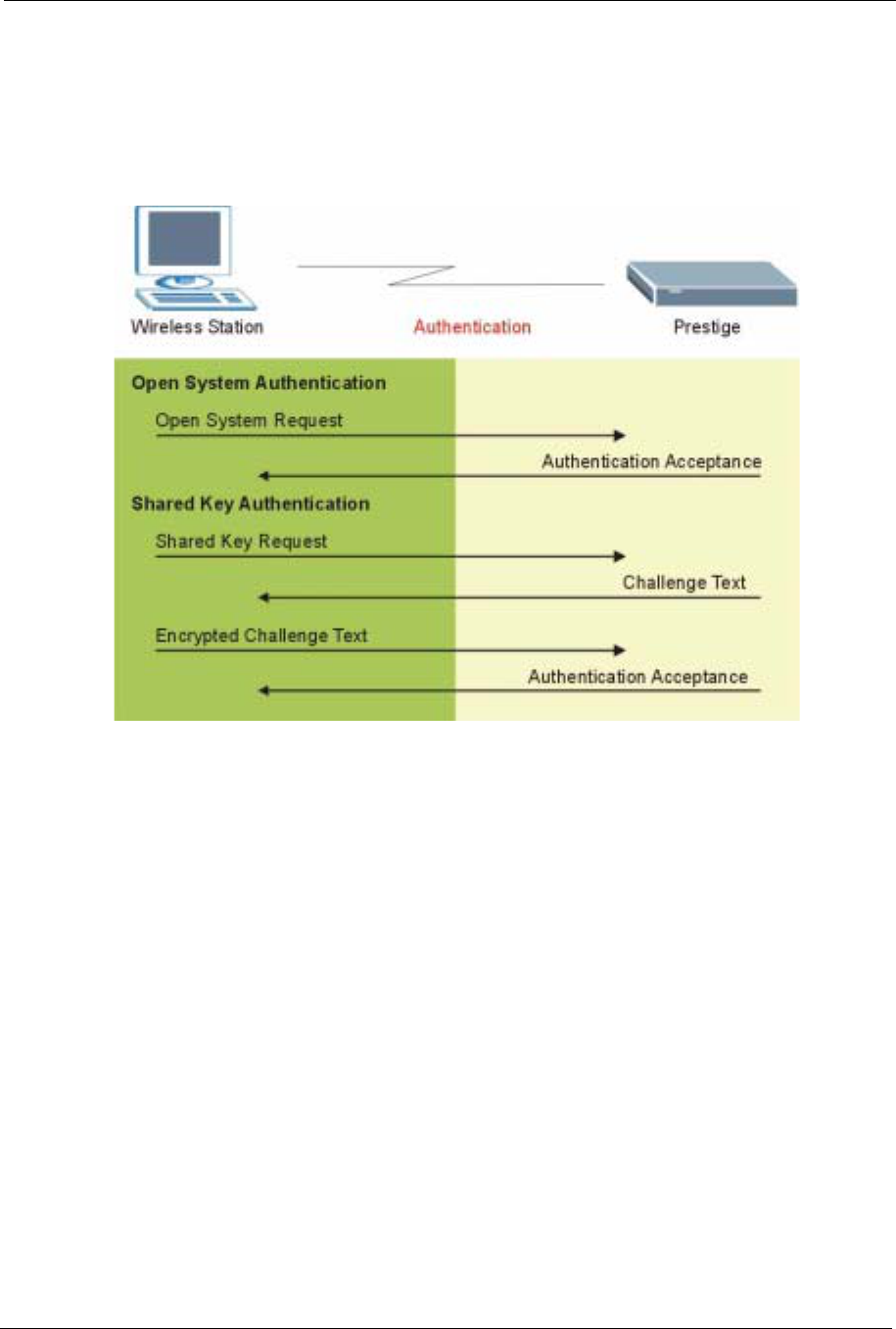
ZyXEL G-570S User’s Guide
Appendix C Wireless LANs 145
WEP Authentication Steps
Three different methods can be used to authenticate wireless stations to the network: Open
System,Shared Key, and Auto. The following figure illustrates the steps involved.
Figure 108 WEP Authentication Steps
Open system authentication involves an unencrypted two-message procedure. A wireless
station sends an open system authentication request to the AP, which will then automatically
accept and connect the wireless station to the network. In effect, open system is not
authentication at all as any station can gain access to the network.
Shared key authentication involves a four-message procedure. A wireless station sends a
shared key authentication request to the AP, which will then reply with a challenge text
message. The wireless station must then use the AP’s default WEP key to encrypt the
challenge text and return it to the AP, which attempts to decrypt the message using the AP’s
default WEP key. If the decrypted message matches the challenge text, the wireless station is
authenticated.
When your device authentication method is set to open system, it will only accept open system
authentication requests. The same is true for shared key authentication. However, when it is
set to auto authentication, the device will accept either type of authentication request and the
device will fall back to use open authentication if the shared key does not match.

ZyXEL G-570S User’s Guide
146 Appendix C Wireless LANs
Dynamic WEP Key Exchange
The AP maps a unique key that is generated with the RADIUS server. This key expires when
the wireless connection times out, disconnects or reauthentication times out. A new WEP key
is generated each time reauthentication is performed.
If this feature is enabled, it is not necessary to configure a default encryption key in the
Wireless screen. You may still configure and store keys here, but they will not be used while
Dynamic WEP is enabled.
Note: EAP-MD5 cannot be used with Dynamic WEP Key Exchange
For added security, certificate-based authentications (EAP-TLS, EAP-TTLS and PEAP) use
dynamic keys for data encryption. They are often deployed in corporate environments, but for
public deployment, a simple user name and password pair is more practical. The following
table is a comparison of the features of authentication types.
WPA(2)
User Authentication
WPA or WPA2 applies IEEE 802.1x and Extensible Authentication Protocol (EAP) to
authenticate wireless stations using an external RADIUS database.
Encryption
Both WPA and WPA2 improve data encryption by using Temporal Key Integrity Protocol
(TKIP), Message Integrity Check (MIC) and IEEE 802.1x. In addition to TKIP, WPA2 also
uses Advanced Encryption Standard (AES) in the Counter mode with Cipher block chaining
Message authentication code Protocol (CCMP) to offer stronger encryption.
Table 38 Comparison of EAP Authentication Types
EAP-MD5 EAP-TLS EAP-TTLS PEAP LEAP
Mutual Authentication No Yes Yes Yes Yes
Certificate – Client No Yes Optional Optional No
Certificate – Server No Yes Yes Yes No
Dynamic Key Exchange No Yes Yes Yes Yes
Credential Integrity None Strong Strong Strong Moderate
Deployment Difficulty Easy Hard Moderate Moderate Moderate
Client Identity Protection No No Yes Yes No

ZyXEL G-570S User’s Guide
Appendix C Wireless LANs 147
TKIP uses 128-bit keys that are dynamically generated and distributed by the authentication
server. It includes a per-packet key mixing function, a Message Integrity Check (MIC) named
Michael, an extended initialization vector (IV) with sequencing rules, and a re-keying
mechanism.
TKIP regularly changes and rotates the encryption keys so that the same encryption key is
never used twice.
The RADIUS server distributes a Pairwise Master Key (PMK) key to the AP that then sets up
a key hierarchy and management system, using the PMK to dynamically generate unique data
encryption keys to encrypt every data packet that is wirelessly communicated between the AP
and the wireless stations. This all happens in the background automatically.
WPA2 AES (Advanced Encryption Standard) is a block cipher that uses a 256-bit
mathematical algorithm called Rijndael.
The Message Integrity Check (MIC) is designed to prevent an attacker from capturing data
packets, altering them and resending them. The MIC provides a strong mathematical function
in which the receiver and the transmitter each compute and then compare the MIC. If they do
not match, it is assumed that the data has been tampered with and the packet is dropped.
By generating unique data encryption keys for every data packet and by creating an integrity
checking mechanism (MIC), TKIP makes it much more difficult to decrypt data on a Wi-Fi
network than WEP, making it difficult for an intruder to break into the network.
The encryption mechanisms used for WPA and WPA-PSK are the same. The only difference
between the two is that WPA-PSK uses a simple common password, instead of user-specific
credentials. The common-password approach makes WPA-PSK susceptible to brute-force
password-guessing attacks but it’s still an improvement over WEP as it employs an easier-to-
use, consistent, single, alphanumeric password.
Roaming
A wireless station is a device with an IEEE 802.11 mode compliant wireless adapter. An
access point (AP) acts as a bridge between the wireless and wired networks. An AP creates its
own wireless coverage area. A wireless station can associate with a particular access point
only if it is within the access point’s coverage area.
In a network environment with multiple access points, wireless stations are able to switch from
one access point to another as they move between the coverage areas. This is roaming. As the
wireless station moves from place to place, it is responsible for choosing the most appropriate
access point depending on the signal strength, network utilization or other factors.
The roaming feature on the access points allows the access points to relay information about
the wireless stations to each other. When a wireless station moves from a coverage area to
another, it scans and uses the channel of a new access point, which then informs the access
points on the LAN about the change. The new information is then propagated to the other
access points on the LAN. An example is shown in Figure 109.
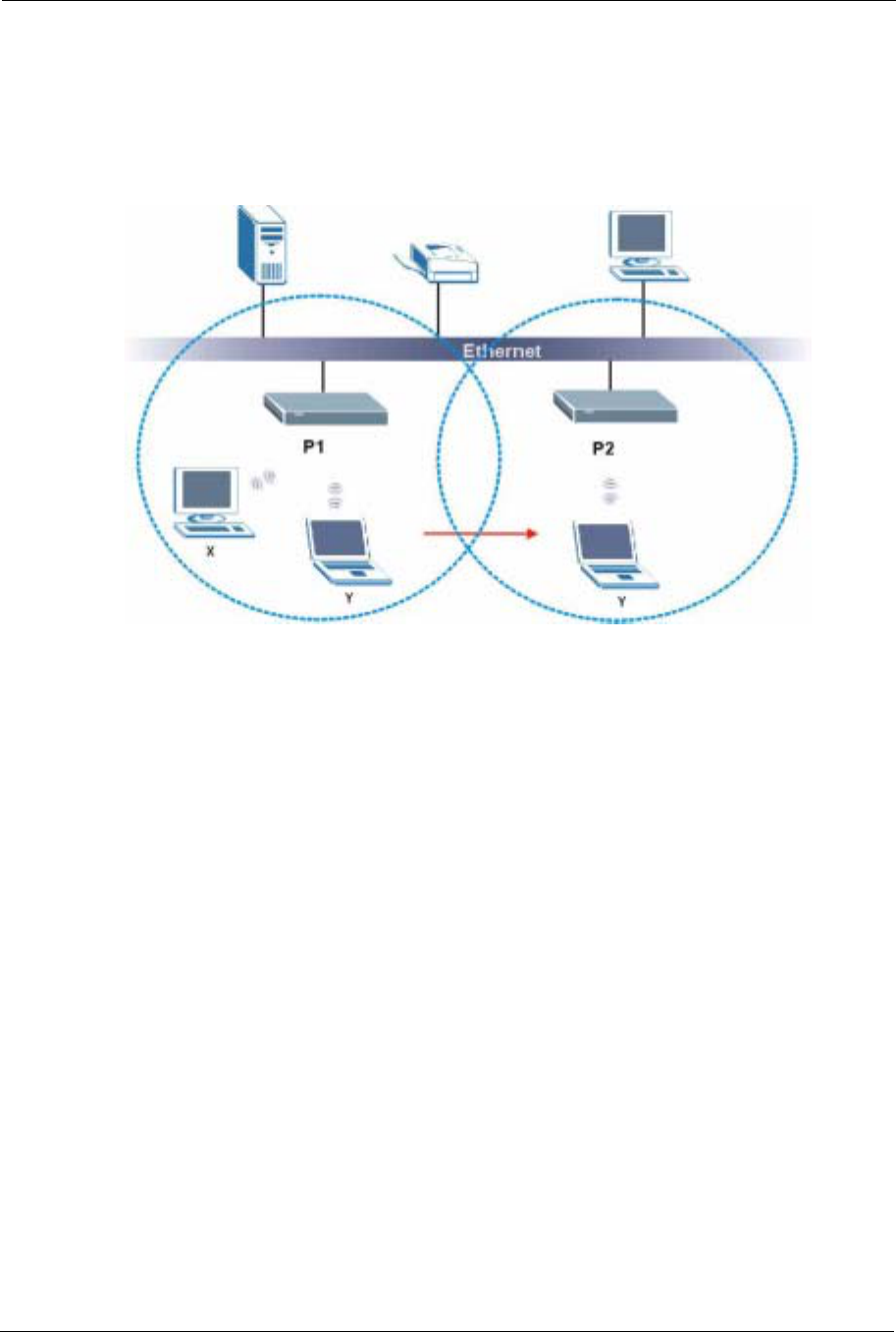
ZyXEL G-570S User’s Guide
148 Appendix C Wireless LANs
If the roaming feature is not enabled on the access points, information is not communicated
between the access points when a wireless station moves between coverage areas. The
wireless station may not be able to communicate with other wireless stations on the network
and vice versa.
Figure 109 Roaming Example
The steps below describe the roaming process.
1As wireless station Y moves from the coverage area of access point P1 to that of access
point
2P2, it scans and uses the signal of access point P2.
3Access point P2 acknowledges the presence of wireless station Y and relays this
information to access point P1 through the wired LAN.
4Access point P1 updates the new position of wireless station.
5Wireless station Y sends a request to access point P2 for re-authentication.
Requirements for Roaming
The following requirements must be met in order for wireless stations to roam between the
coverage areas.
1All the access points must be on the same subnet and configured with the same ESSID.
2If IEEE 802.1x user authentication is enabled and to be done locally on the access point,
the new access point must have the user profile for the wireless station.
3The adjacent access points should use different radio channels when their coverage areas
overlap.
4All access points must use the same port number to relay roaming information.

ZyXEL G-570S User’s Guide
Appendix C Wireless LANs 149
5The access points must be connected to the Ethernet and be able to get IP addresses from
a DHCP server if using dynamic IP address assignment.

ZyXEL G-570S User’s Guide
150 Appendix C Wireless LANs

ZyXEL G-570S User’s Guide
Appendix D IP Subnetting 151
APPENDIX D
IP Subnetting
IP Addressing
Routers “route” based on the network number. The router that delivers the data packet to the
correct destination host uses the host ID.
IP Classes
An IP address is made up of four octets (eight bits), written in dotted decimal notation, for
example, 192.168.1.1. IP addresses are categorized into different classes. The class of an
address depends on the value of its first octet.
• Class “A” addresses have a 0 in the left most bit. In a class “A” address the first octet is
the network number and the remaining three octets make up the host ID.
• Class “B” addresses have a 1 in the left most bit and a 0 in the next left most bit. In a class
“B” address the first two octets make up the network number and the two remaining
octets make up the host ID.
• Class “C” addresses begin (starting from the left) with 1 1 0. In a class “C” address the
first three octets make up the network number and the last octet is the host ID.
• Class “D” addresses begin with 1 1 1 0. Class “D” addresses are used for multicasting.
(There is also a class “E” address. It is reserved for future use.)
Note: Host IDs of all zeros or all ones are not allowed.
Therefore:
A class “C” network (8 host bits) can have 28 –2 or 254 hosts.
A class “B” address (16 host bits) can have 216 –2 or 65534 hosts.
A class “A” address (24 host bits) can have 224 –2 hosts (approximately 16 million hosts).
Table 39 Classes of IP Addresses
IP ADDRESS: OCTET 1 OCTET 2 OCTET 3 OCTET 4
Class A 0Network number Host ID Host ID Host ID
Class B 10 Network number Network number Host ID Host ID
Class C 110 Network number Network number Network number Host ID

ZyXEL G-570S User’s Guide
152 Appendix D IP Subnetting
Since the first octet of a class “A” IP address must contain a “0”, the first octet of a class “A”
address can have a value of 0 to 127.
Similarly the first octet of a class “B” must begin with “10”, therefore the first octet of a class
“B” address has a valid range of 128 to 191. The first octet of a class “C” address begins with
“110”, and therefore has a range of 192 to 223.
Subnet Masks
A subnet mask is used to determine which bits are part of the network number, and which bits
are part of the host ID (using a logical AND operation). A subnet mask has 32 is a “1” then
the corresponding bit in the IP address is part of the network number. If a bit in the subnet
mask is “0” then the corresponding bit in the IP address is part of the host ID.
Subnet masks are expressed in dotted decimal notation just as IP addresses are. The “natural”
masks for class A, B and C IP addresses are as follows.
Subnetting
With subnetting, the class arrangement of an IP address is ignored. For example, a class C
address no longer has to have 24 bits of network number and 8 bits of host ID. With
subnetting, some of the host ID bits are converted into network number bits. By convention,
subnet masks always consist of a continuous sequence of ones beginning from the left most bit
of the mask, followed by a continuous sequence of zeros, for a total number of 32 bits.
Table 40 Allowed IP Address Range By Class
CLASS ALLOWED RANGE OF FIRST OCTET
(BINARY) ALLOWED RANGE OF FIRST OCTET
(DECIMAL)
Class A 00000000 to 01111111 0 to 127
Class B 10000000 to 10111111 128 to 191
Class C 11000000 to 11011111 192 to 223
Class D 11100000 to 11101111 224 to 239
Table 41 “Natural” Masks
CLASS NATURAL MASK
A255.0.0.0
B255.255.0.0
C255.255.255.0

ZyXEL G-570S User’s Guide
Appendix D IP Subnetting 153
Since the mask is always a continuous number of ones beginning from the left, followed by a
continuous number of zeros for the remainder of the 32 bit mask, you can simply specify the
number of ones instead of writing the value of each octet. This is usually specified by writing
a “/” followed by the number of bits in the mask after the address.
For example, 192.1.1.0 /25 is equivalent to saying 192.1.1.0 with mask 255.255.255.128.
The following table shows all possible subnet masks for a class “C” address using both
notations.
The first mask shown is the class “C” natural mask. Normally if no mask is specified it is
understood that the natural mask is being used.
Example: Two Subnets
As an example, you have a class “C” address 192.168.1.0 with subnet mask of 255.255.255.0.
The first three octets of the address make up the network number (class “C”). You want to
have two separate networks.
Divide the network 192.168.1.0 into two separate subnets by converting one of the host ID bits
of the IP address to a network number bit. The “borrowed” host ID bit can be either “0” or “1”
thus giving two subnets; 192.168.1.0 with mask 255.255.255.128 and 192.168.1.128 with
mask 255.255.255.128.
Table 42 Alternative Subnet Mask Notation
SUBNET MASK IP ADDRESS SUBNET MASK “1” BITS LAST OCTET BIT VALUE
255.255.255.0 /24 0000 0000
255.255.255.128 /25 1000 0000
255.255.255.192 /26 1100 0000
255.255.255.224 /27 1110 0000
255.255.255.240 /28 1111 0000
255.255.255.248 /29 1111 1000
255.255.255.252 /30 1111 1100
Table 43 Two Subnets Example
NETWORK NUMBER HOST ID
IP Address 192.168.1. 0
IP Address (Binary) 11000000.10101000.00000001. 00000000
Subnet Mask 255.255.255. 0
Subnet Mask (Binary) 11111111.11111111.11111111. 00000000

ZyXEL G-570S User’s Guide
154 Appendix D IP Subnetting
Note: In the following charts, shaded/bolded last octet bit values indicate host ID bits
“borrowed” to form network ID bits. The number of “borrowed” host ID bits
determines the number of subnets you can have. The remaining number of
host ID bits (after “borrowing”) determines the number of hosts you can have
on each subnet.
The remaining 7 bits determine the number of hosts each subnet can have. Host IDs of all
zeros represent the subnet itself and host IDs of all ones are the broadcast address for that
subnet, so the actual number of hosts available on each subnet in the example above is 27 – 2
or 126 hosts for each subnet.
192.168.1.0 with mask 255.255.255.128 is the subnet itself, and 192.168.1.127 with mask
255.255.255.128 is the directed broadcast address for the first subnet. Therefore, the lowest IP
address that can be assigned to an actual host for the first subnet is 192.168.1.1 and the highest
is 192.168.1.126. Similarly the host ID range for the second subnet is 192.168.1.129 to
192.168.1.254.
Table 44 Subnet 1
NETWORK NUMBER LAST OCTET BIT
VALUE
IP Address 192.168.1. 0
IP Address (Binary) 11000000.10101000.00000001. 00000000
Subnet Mask 255.255.255. 128
Subnet Mask (Binary) 11111111.11111111.11111111. 10000000
Subnet Address: 192.168.1.0 Lowest Host ID: 192.168.1.1
Broadcast Address:
192.168.1.127 Highest Host ID: 192.168.1.126
Table 45 Subnet 2
NETWORK NUMBER LAST OCTET BIT VALUE
IP Address 192.168.1. 128
IP Address (Binary) 11000000.10101000.00000001. 10000000
Subnet Mask 255.255.255. 128
Subnet Mask (Binary) 11111111.11111111.11111111. 10000000
Subnet Address:
192.168.1.128 Lowest Host ID: 192.168.1.129
Broadcast Address:
192.168.1.255 Highest Host ID: 192.168.1.254

ZyXEL G-570S User’s Guide
Appendix D IP Subnetting 155
Example: Four Subnets
The above example illustrated using a 25-bit subnet mask to divide a class “C” address space
into two subnets. Similarly to divide a class “C” address into four subnets, you need to
“borrow” two host ID bits to give four possible combinations of 00, 01, 10 and 11. The subnet
mask is 26 bits (11111111.11111111.11111111.11000000) or 255.255.255.192. Each subnet
contains 6 host ID bits, giving 26-2 or 62 hosts for each subnet (all 0’s is the subnet itself, all
1’s is the broadcast address on the subnet).
Table 46 Subnet 1
NETWORK NUMBER LAST OCTET BIT
VALUE
IP Address 192.168.1. 0
IP Address (Binary) 11000000.10101000.00000001. 00000000
Subnet Mask (Binary) 11111111.11111111.11111111. 11000000
Subnet Address: 192.168.1.0 Lowest Host ID: 192.168.1.1
Broadcast Address:
192.168.1.63 Highest Host ID: 192.168.1.62
Table 47 Subnet 2
NETWORK NUMBER LAST OCTET BIT
VALUE
IP Address 192.168.1. 64
IP Address (Binary) 11000000.10101000.00000001. 01000000
Subnet Mask (Binary) 11111111.11111111.11111111. 11000000
Subnet Address: 192.168.1.64 Lowest Host ID: 192.168.1.65
Broadcast Address: 192.168.1.127 Highest Host ID: 192.168.1.126
Table 48 Subnet 3
NETWORK NUMBER LAST OCTET BIT
VALUE
IP Address 192.168.1. 128
IP Address (Binary) 11000000.10101000.00000001. 10000000
Subnet Mask (Binary) 11111111.11111111.11111111. 11000000
Subnet Address:
192.168.1.128 Lowest Host ID: 192.168.1.129
Broadcast Address:
192.168.1.191 Highest Host ID: 192.168.1.190

ZyXEL G-570S User’s Guide
156 Appendix D IP Subnetting
Example Eight Subnets
Similarly use a 27-bit mask to create 8 subnets (001, 010, 011, 100, 101, 110).
The following table shows class C IP address last octet values for each subnet.
The following table is a summary for class “C” subnet planning.
Table 49 Subnet 4
NETWORK NUMBER LAST OCTET BIT VALUE
IP Address 192.168.1. 192
IP Address (Binary) 11000000.10101000.00000001. 11000000
Subnet Mask (Binary) 11111111.11111111.11111111. 11000000
Subnet Address:
192.168.1.192 Lowest Host ID: 192.168.1.193
Broadcast Address:
192.168.1.255 Highest Host ID: 192.168.1.254
Table 50 Eight Subnets
SUBNET SUBNET ADDRESS FIRST ADDRESS LAST ADDRESS BROADCAST
ADDRESS
1 0 1 30 31
232 33 62 63
364 65 94 95
496 97 126 127
5128 129 158 159
6160 161 190 191
7192 193 222 223
8224 225 254 255
Table 51 Class C Subnet Planning
NO. “BORROWED” HOST
BITS SUBNET MASK NO. SUBNETS NO. HOSTS PER
SUBNET
1255.255.255.128 (/25) 2126
2255.255.255.192 (/26) 462
3255.255.255.224 (/27) 830
4255.255.255.240 (/28) 16 14
5255.255.255.248 (/29) 32 6
6255.255.255.252 (/30) 64 2
7255.255.255.254 (/31) 128 1

ZyXEL G-570S User’s Guide
Appendix D IP Subnetting 157
Subnetting With Class A and Class B Networks.
For class “A” and class “B” addresses the subnet mask also determines which bits are part of
the network number and which are part of the host ID.
A class “B” address has two host ID octets available for subnetting and a class “A” address has
three host ID octets (see Table 39 on page 151) available for subnetting.
The following table is a summary for class “B” subnet planning.
Table 52 Class B Subnet Planning
NO. “BORROWED” HOST
BITS SUBNET MASK NO. SUBNETS NO. HOSTS PER
SUBNET
1255.255.128.0 (/17) 232766
2255.255.192.0 (/18) 416382
3255.255.224.0 (/19) 88190
4255.255.240.0 (/20) 16 4094
5255.255.248.0 (/21) 32 2046
6255.255.252.0 (/22) 64 1022
7255.255.254.0 (/23) 128 510
8255.255.255.0 (/24) 256 254
9255.255.255.128 (/25) 512 126
10 255.255.255.192 (/26) 1024 62
11 255.255.255.224 (/27) 2048 30
12 255.255.255.240 (/28) 4096 14
13 255.255.255.248 (/29) 8192 6
14 255.255.255.252 (/30) 16384 2
15 255.255.255.254 (/31) 32768 1

ZyXEL G-570S User’s Guide
158 Appendix D IP Subnetting

ZyXEL G-570S User’s Guide
Index 159
Index
Numerics
110V AC 5
230V AC 5
A
Abnormal Working Conditions 6
AC 5
Accessories 5
Acts of God 6
Address Assignment 53
Ad-hoc 57
Advanced Encryption Standard 146
Airflow 5
Alternative Subnet Mask Notation 153
AP (access point) 139
Association List 50
Authentication 75,145
Authority 3
Auto MDI/MDI-X 115
Auto-negotiating 115
B
Basement 5
Basic Service Set 57
BSS 57,137
C
CA 144
Cables, Connecting 5
Certificate Authority 144
Certifications 4
Changes or Modifications 3
Channel 139
Interference 139
channel 51,59
Channel ID 62,69,72
Charge 6
Circuit 3
Class B 3
Communications 3
Compliance, FCC 3
Components 6
Condition 6
Connecting Cables 5
Consequential Damages 6
Contact Information 7
Contacting Customer Support 7
Copyright 2
Correcting Interference 3
Corrosive Liquids 5
Covers 5
CTS (Clear to Send) 140
Customer Support 7
Czech Republic, Contact Information 7
D
Dampness 5
Danger 5
Data Encryption 75
Dealer 3
Deep 115
Default IP Address 115
Default Password 115
Default Subnet Mask 115
Defective 6
Denmark, Contact Information 7
DHCP Client 115
Diagnostic Tools 116
Dimensions 115
Disclaimer 2
Discretion 6
Distribution System 58
Dust 5
Dynamic WEP Key Exchange 78,146

ZyXEL G-570S User’s Guide
160 Index
E
EAP 74,77,79
EAP Authentication 143
Electric Shock 5
Electrical Pipes 5
Encryption 79,146
Equal Value 6
ESS 58,138
ESS IDentification 58
Ethernet Ports 115
Europe 5
European Plug Standards 118
Exposure 5
Extended Service Set 58,138
Extensible Authentication Protocol 79
F
Failure 6
FCC 3
Compliance 3
Rules, Part 15 3
FCC Rules 3
Federal Communications Commission 3
Finland, Contact Information 7
Fitness 6
Fragmentation Threshold 61,140
Fragmentation threshold 140
France, Contact Information 7
Functionally Equivalent 6
G
Gas Pipes 5
Germany, Contact Information 7
God, act of 6
H
Harmful Interference 3
Hidden node 139
High 115
High Voltage Points 5
Host IDs 151
I
IBSS 57,137
IEEE 802.11g 141
Independent Basic Service Set 57,137
Indirect Damages 6
initialization vector (IV) 147
Insurance 6
Interference 3
Interference Correction Measures 3
Interference Statement 3
IP Address 53
IP Address, Default 115
IP Addressing 151
IP Classes 151
L
Labor 6
Legal Rights 6
Liability 2
License 2
Lightning 5
Liquids, Corrosive 5
M
MAC filter 74
Management 116
Materials 6
Merchantability 6
Message Integrity Check (MIC) 146
Modifications 3
N
Navigation Panel 44
New 6
North America 5
North America Contact Information 7

ZyXEL G-570S User’s Guide
Index 161
North American Plug Standards 118
Norway, Contact Information 7
O
Open System 76
Opening 5
Operating Condition 6
Operation Humidity 115
Operation Temperature 115
Out-dated Warranty 6
Outlet 3
P
Pairwise Master Key (PMK) 147
Parts 6
Password 115
Patent 2
Permission 2
Photocopying 2
Pipes 5
Pool 5
Postage Prepaid. 6
Power Adaptor Specifications 118
Power Cord 5
Private IP Address 53
Product Model 7
Product Page 4
Product Serial Number 7
Products 6
Proof of Purchase 6
Proper Operating Condition 6
Protocol Support 115
Purchase, Proof of 6
Purchaser 6
Q
Qualified Service Personnel 5
R
Radio Communications 3
Radio Frequency Energy 3
Radio Interference 3
Radio Reception 3
Radio Technician 3
RADIUS 141
Shared Secret Key 142
RADIUS Message Types 142
RADIUS Messages 142
Read Me First 19
Receiving Antenna 3
Registered 2
Registered Trademark 2
Regular Mail 7
Related Documentation 19
Relocate 3
Re-manufactured 6
Removing 5
Reorient 3
Repair 6
Replace 6
Replacement 6
Reproduction 2
Restore 6
Return Material Authorization (RMA) Number 6
Returned Products 6
Returns 6
Rights 2
Rights, Legal 6
Risk 5
Risks 5
RJ-45 115
RMA 6
Roaming 147
Example 148
Requirements 148
RTS (Request To Send) 140
RTS Threshold 60,139,140
RTS/CTS 60
S
Safety Warnings 5
Security Parameters 81
Separation Between Equipment and Receiver 3
Serial Number 7

ZyXEL G-570S User’s Guide
162 Index
Service 5,6
Service Personnel 5
Service Set Identity 59
Shared Key 76
Shipping 6
Shock, Electric 5
signal strength 50,51
Spain, Contact Information 8
SSID 51,59
Statistics 48
Storage Humidity 115
Storage Temperature 115
Subnet Mask 53
Subnet Mask, Default 115
Subnet Masks 152
Subnetting 152
Supply Voltage 5
Support E-mail 7
Supporting Disk 19
Sweden, Contact Information 8
Swimming Pool 5
Syntax Conventions 19
System Status 47
T
Tampering 6
Telephone 7
Television Interference 3
Television Reception 3
Temporal Key Integrity Protocol (TKIP) 146
Thunderstorm 5
Trademark 2
Trademark Owners 2
Trademarks 2
Translation 2
TV Technician 3
U
Undesired Operations 3
User Authentication 79,146
V
Value 6
Vendor 5
Ventilation Slots 5
Viewing Certifications 4
Voltage Supply 5
Voltage, High 5
W
Wall Mount 5
Warnings 5
Warranty 6
Warranty Information 7
Warranty Period 6
Water 5
Water Pipes 5
WDS 66
Web Site 7
Weight 115
WEP 75
WEP encryption 144
Wet Basement 5
Wide 115
Wired Equivalent Privacy 75
Wireless Client WPA Supplicants 81
WLAN
Interference 139
Workmanship 6
Worldwide Contact Information 7
WPA 78
WPA with RADIUS Application 80
WPA2 78
WPA-PSK 79
WPA-PSK Application 79
Written Permission 2
Z
ZyNOS 2
ZyXEL Communications Corporation 2
ZyXEL Home Page 4
ZyXEL Limited Warranty
Note 6
ZyXEL Network Operating System 2